CalAmp Wireless Networks 5098-500 ViPR Narrowband IP Modem User Manual 9 ViPR Rev2
CalAmp Wireless Networks Corporation ViPR Narrowband IP Modem 9 ViPR Rev2
Users Manual
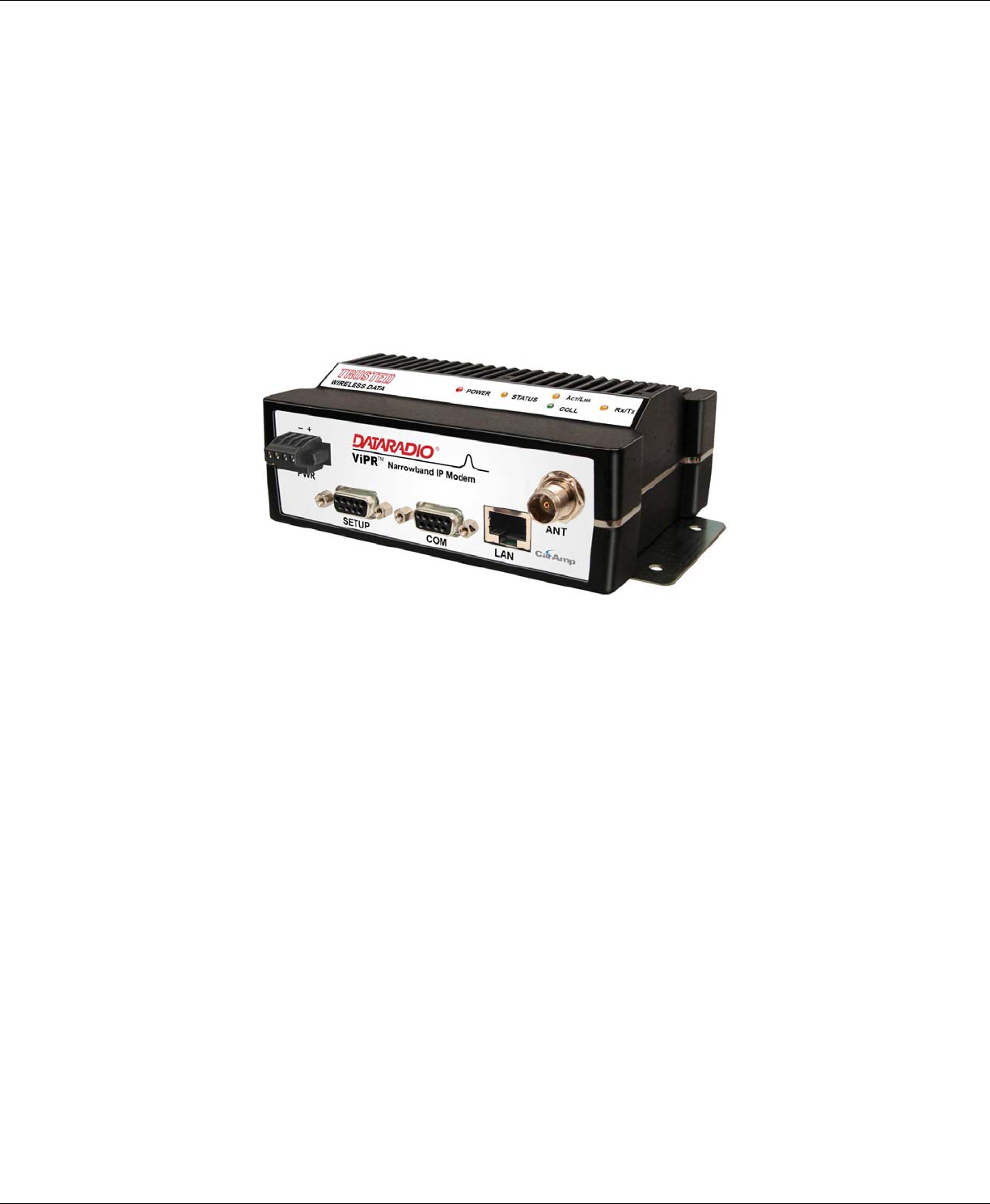
V
Vi
iP
PR
R™
™
N
Na
ar
rr
ro
ow
wb
ba
an
nd
d
I
IP
P
M
Mo
od
de
em
m/
/R
Ro
ou
ut
te
er
r
User Manual
PN 001-5008-000 Rev 3
Revised December 2008

REVISION HISTORY
REV DATE ECO REVISION DETAILS
0 Jan 11, 2008 - Initial Release as 001-5008-000
1 May 2008 02550 Update Dual Port ViPR info
2 September 2008
Added information about SNMP
Updated Firmware Upgrade instructions.
3 December 2008
Added information about TCP Client Server Mode
Added information about Saving/Restoring User
Configuration files.
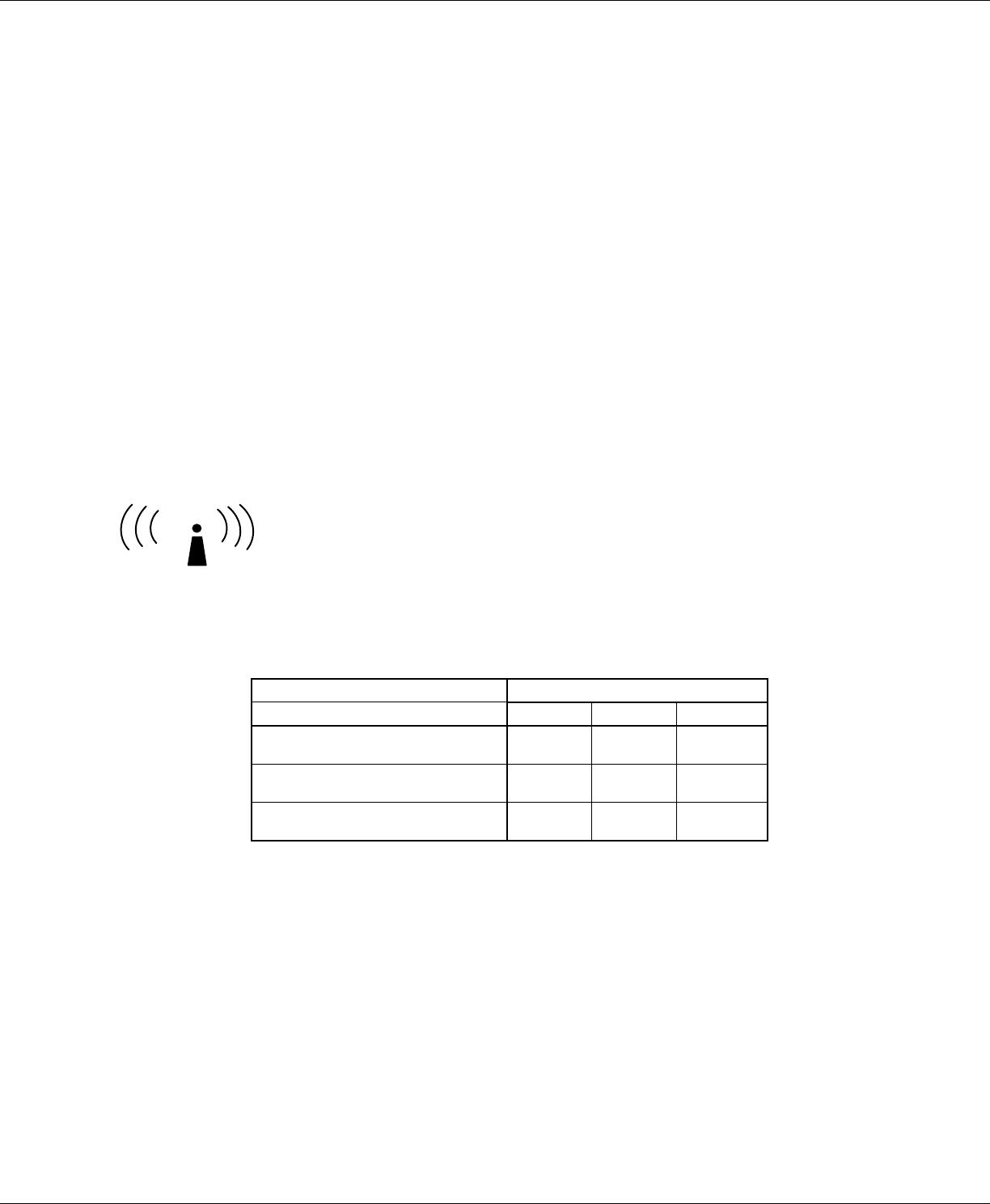
IMPORTANT NOTICE
Because of the nature of wireless communication, transmission and reception of data can never
be guaranteed. Data may be delayed, corrupted (i.e., have errors), or be totally lost. Significant
delays or losses of data are rare when wireless devices such as the ViPR are used in a normal
manner with a well-constructed network. ViPR should not be used in situations where failure to
transmit or receive data could result in damage of any kind to the user or any other party,
including but not limited to personal injury, death, or loss of property. CalAmp accepts no
responsibility for damages of any kind resulting from delays or errors in data transmitted or
received using ViPR, or for the failure of ViPR to transmit or receive such data.
COPYRIGHT NOTICE
© Copyright 2007 CalAmp.
Products offered may contain software proprietary to CalAmp. The offer of supply of these
products and services does not include or infer any transfer of ownership. No part of the
documentation or information supplied may be divulged to any third party without the express
written consent of CalAmp.
RF EXPOSURE COMPLIANCE REQUIREMENTS
The ViPR radio is intended for use in the Industrial Monitoring and Control and
SCADA markets. The ViPR unit must be professionally installed and must ensure a minimum
separation distance listed in the table below between the radiating structure and any person.
An antenna mounted on a pole or tower is the typical installation and in rare instances, a 1/2-
wave whip antenna is used.
Antenna Gain
5 dBi 10 dBi 15 dBi
Min Safety Distance (VHF @
max Power) 123cm 218.8cm 389cm
Min Safety Distance (UHF @
max Power) 105.7cm 188cm 334.4cm
Min Safety Distance (900Mhz @
max power) 63.8cm 115 cm 201.7 cm
Note: It is the responsibility of the user to guarantee compliance with the FCC MPE
regulations when operating this device in a way other than described above.
The ViPR radio uses a low power radio frequency transmitter. The concentrated energy from an
antenna may pose a health hazard. People should not be in front of the antenna when the
transmitter is operating.
The installer of this equipment must ensure the antenna is located or pointed such that it does
not emit an RF field in excess of Health Canada limits for the general population. Recommended
safety guidelines for the human exposure to radio frequency electromagnetic energy are
contained in the Canadian Safety Code 6 (available from Health Canada) and the Federal
Communications Commission (FCC) Bulletin 65.
Any changes or modifications not expressly approved by the party responsible for compliance
(in the country where used) could void the user's authority to operate the equipment.
RF Exposure

TABLE OF CONTENTS
1 VIPR OVERVIEW.......................................................................................................................................................8
1.1 General Description............................................................................................................................................8
1.2 Operational Characteristics...............................................................................................................................8
1.3 Physical Description ...........................................................................................................................................9
1.3.1 Front Panel....................................................................................................................................................9
1.3.2 LED Panel...................................................................................................................................................10
1.3.3 Ethernet LAN Port......................................................................................................................................10
1.3.4 SETUP and COM Ports..............................................................................................................................11
1.3.5 Power Connector ........................................................................................................................................11
1.3.6 Antenna Connector .....................................................................................................................................12
1.3.7 Chassis Dimensions....................................................................................................................................12
1.4 Part Numbers and Availability........................................................................................................................13
1.4.1 ViPR Radio.................................................................................................................................................13
1.4.2 Accessories and Options.............................................................................................................................13
1.5 Product Warranty ............................................................................................................................................14
1.6 RMA Request....................................................................................................................................................15
1.7 Documentation and Downloads.......................................................................................................................15
2 SYSTEM ARCHITECTURE AND NETWORK PLANNING .................................................................................15
2.1 Single Coverage Area .......................................................................................................................................15
2.2 Master/Remote..................................................................................................................................................15
2.3 Point-to-Point....................................................................................................................................................16
2.3.1 Point-to-Multipoint.....................................................................................................................................18
2.3.2 Report by Exception ...................................................................................................................................18
2.4 Extending the Coverage Area with a Relay Point..........................................................................................19
2.4.1 Understanding RF Path Requirements........................................................................................................19
2.5 Site Selection and Site Survey..........................................................................................................................19
2.5.1 Site Selection ..............................................................................................................................................19
2.5.2 Site Survey..................................................................................................................................................20
2.6 Selecting Antenna and Feedline.......................................................................................................................20
2.6.1 Antenna Gain..............................................................................................................................................20
2.6.2 Omni Directional Antenna..........................................................................................................................20
2.6.3 Yagi Antenna..............................................................................................................................................21
2.6.4 Vertical Dipoles..........................................................................................................................................21
2.6.5 Feedline ......................................................................................................................................................21
2.6.6 RF Exposure Compliance Requirements....................................................................................................21
2.7 Terrain and Signal Strength............................................................................................................................22
2.8 Radio Interference............................................................................................................................................23
2.9 IP Forwarding Modes.......................................................................................................................................23
2.9.1 Bridge Mode...............................................................................................................................................23
2.9.2 Router Mode...............................................................................................................................................24
3 DATARADIO VIPR QUICK START........................................................................................................................24
3.1 Setup and Configuration..................................................................................................................................24
3.2 Install the Antenna ...........................................................................................................................................24
3.3 PC LAN Setup...................................................................................................................................................25
3.3.1 Front Panel Connections.............................................................................................................................25
3.4 Measure and Connect Primary Power............................................................................................................26

3.5 Connect ViPR to Programming PC ................................................................................................................27
3.5.1 Initial Installation Login .............................................................................................................................27
3.6 Configure Your ViPR Using the Setup Wizard .............................................................................................27
3.7 Check For Normal Operation..........................................................................................................................30
4 VIPR WEB MANAGEMENT ...................................................................................................................................31
4.1 Navigating the Network Management System...............................................................................................31
4.2 Main Menu........................................................................................................................................................31
4.2.1 Network Management System Commands.................................................................................................31
5 UNIT STATUS...........................................................................................................................................................33
5.1 Unit Identification and Status..........................................................................................................................33
5.2 Diagnostics.........................................................................................................................................................34
5.2.1 Local Diagnostics .......................................................................................................................................34
5.2.2 Online Diagnostics......................................................................................................................................36
6 SETUP (BASIC)........................................................................................................................................................39
6.1 General Setup....................................................................................................................................................39
6.2 IP Settings..........................................................................................................................................................42
6.2.1 Ethernet Interface........................................................................................................................................42
6.2.2 RF Interface ................................................................................................................................................43
6.2.3 Default Gateway.........................................................................................................................................44
6.3 Channel Table...................................................................................................................................................44
6.4 Serial Ports Setup .............................................................................................................................................45
6.4.1 Basic Settings..............................................................................................................................................47
6.4.2 IP Gateway Service.....................................................................................................................................47
6.4.3 IP Gateway Transport.................................................................................................................................48
6.4.4 RTS/CTS Mode Settings ............................................................................................................................52
7 SETUP (ADVANCED)..............................................................................................................................................53
7.1 RF Optimizations..............................................................................................................................................53
7.1.1 MAC Advanced Settings ............................................................................................................................53
7.1.2 Carrier Sense Level Threshold....................................................................................................................54
7.2 IP Services.........................................................................................................................................................54
7.2.1 SNMP .........................................................................................................................................................55
7.2.2 NAT Overview ...........................................................................................................................................58
7.2.3 NAT on ViPR.............................................................................................................................................59
7.2.4 Ethernet Interface Private ...........................................................................................................................59
7.2.5 RF Interface Private....................................................................................................................................61
7.2.6 User NAT Entries .......................................................................................................................................63
7.2.7 NAT Port Forwarding.................................................................................................................................64
7.3 IP Addressing....................................................................................................................................................66
7.3.1 Broadcast Mode..........................................................................................................................................66
7.3.2 Multicast Mode...........................................................................................................................................66
7.4 IP Optimization.................................................................................................................................................67
7.5 IP Routing (Table/Entries)...............................................................................................................................68
7.6 Time Source.......................................................................................................................................................69
7.6.1 SNTP ..........................................................................................................................................................69
7.6.2 Time Zone...................................................................................................................................................69
7.7 Alarm Reporting...............................................................................................................................................69
7.7.1 Forward Power Alarm & Notification........................................................................................................69
7.7.2 Reverse Power Alarm & Notification.........................................................................................................70
7.7.3 PA Power Alarm & Notification.................................................................................................................70

7.8 User Settings......................................................................................................................................................70
8 SECURITY.................................................................................................................................................................71
8.1 User ID and Password......................................................................................................................................71
8.2 Encryption.........................................................................................................................................................72
9 STATISTICS..............................................................................................................................................................73
9.1 Ethernet (LAN).................................................................................................................................................73
9.2 Serial..................................................................................................................................................................74
9.3 RF.......................................................................................................................................................................74
9.4 Airlink Error Detection....................................................................................................................................74
10 MAINTENANCE...................................................................................................................................................76
10.1 Ping Test............................................................................................................................................................76
10.2 Unit Configuration Control .............................................................................................................................76
10.2.1 User Configuration Settings........................................................................................................................77
10.3 Package Control................................................................................................................................................78
10.4 Net Tests ............................................................................................................................................................78
10.4.1 Net Test Setup.............................................................................................................................................79
10.4.2 Net Test Results..........................................................................................................................................80
10.5 RF Tests.............................................................................................................................................................82
10.6 Feature Options ................................................................................................................................................82
11 NEIGHBOR MANAGEMENT .............................................................................................................................83
11.1 User Interface....................................................................................................................................................83
11.2 Neighbor Discovery (Modes)............................................................................................................................83
11.2.1 Manual-SCAN............................................................................................................................................84
11.2.2 Auto-SCAN ................................................................................................................................................84
11.2.3 Disabled......................................................................................................................................................84
11.3 Local Status.......................................................................................................................................................84
11.3.1 Neighbor Discovery States .........................................................................................................................85
11.3.2 Neighboring ViPRs Found..........................................................................................................................86
11.3.3 Discovery Duration.....................................................................................................................................86
11.4 Discovered ViPR Neighbors.............................................................................................................................86
11.4.1 Information on Neighboring ViPRs............................................................................................................86
11.4.2 Neighbor Table Entry Type........................................................................................................................86
11.4.3 Route to Neighboring ViPRs......................................................................................................................87
11.5 Control Operations...........................................................................................................................................87
11.6 Primary and Backup Route Selection.............................................................................................................88
11.7 Network Status..................................................................................................................................................88
11.8 Maintenance......................................................................................................................................................89
11.9 Recommended Neighbor Discovery Modes of Operations............................................................................90
12 NETWORK OPTIMIZATION ..............................................................................................................................90
12.1 Maximizing TCP/IP Throughput....................................................................................................................90
12.2 Maximizing Throughput with a Weak RF Link............................................................................................91
12.2.1 Use Router Mode with RF Acknowledgements Enabled............................................................................91
12.2.2 Reduce RF Network Bit Rate .....................................................................................................................91
12.2.3 Increase OIP and MAC Retries Limit.........................................................................................................91
13 UPGRADING YOUR FIRMWARE......................................................................................................................92

13.1 Software Release History .................................................................................................................................92
13.2 Upgrade Modem Firmware Procedure...........................................................................................................92
13.3 Upgrade Radio Firmware................................................................................................................................93
13.4 Verify File Integrity..........................................................................................................................................95
VIPR SPECIFICATIONS.................................................................................................................................................96
PRODUCT WARRANTY ................................................................................................................................................100
DEFINITIONS................................................................................................................................................................101

#9 ViPR User Manual_Rev2.doc Page 8
VIPR OVERVIEW
This document provides information required for the operation and verification of the
Dataradio ViPR Narrowband IP Modem/Router. The information in this manual makes the
assumption the user’s PC has an NIC (Network Interface Card) with TCP/IP implemented.
Setup requires the knowledge and authorization to modify the TCP/IP settings for the NIC.
Changing or installing new IP addresses in a network can cause serious network problems.
If you have any questions or concerns, contact the Network Administrator for your system.
GENERAL DESCRIPTION
ViPR provides any IP-enabled device with connectivity to transmit narrowband data. This
DSP-based radio was designed for SCADA, telemetry and industrial applications in the
406.1-512 MHz UHF, 136-174 MHz VHF and 928-960 MHz frequency ranges.
ViPR supports serial and Ethernet/IP Remote Terminal Units (RTU) and programmable logic
controllers (PLC). It is standard IEEE 802.3 compliant. ViPR supports any protocol running
over IPv4 (including ICMP, IPinIP, IPSec, RSVP, TCP and UDP protocols). It provides MAC
layer bridging and HTTP, ARP, and static routing packet forwarding.
OPERATIONAL CHARACTERISTICS
The ViPR product has the following operational characteristics:
Frequency range of 406.1-470 MHz, 450-512 MHz, 136-174 MHz or 928-960 MHz.
User-selectable data rates
Built-in transceiver adjustable from 1 to 10 watts (8 watts max for 900MHz)
Used as an access point or an end point with each configurable in (a) Bridge mode for
quick setup of units on same network or (b) Router mode for advanced networks
Embedded web server to access status and/or setup information
Remote access for over-the-air system firmware upgrades
Wide input power range of 10 to 30 volts DC
AES 128-bit data encryption (Applies to Serial and IP connections)
Superior data compression (zlib compression algorithm applies to Serial and IP
connections)
Native UDP and TCP/IP support
Online and Offline Diagnostics
Supports up to 32 different frequency channel pairs
Industrial operating temperature range of -30 to +60 C
Rugged die-cast aluminum and steel case
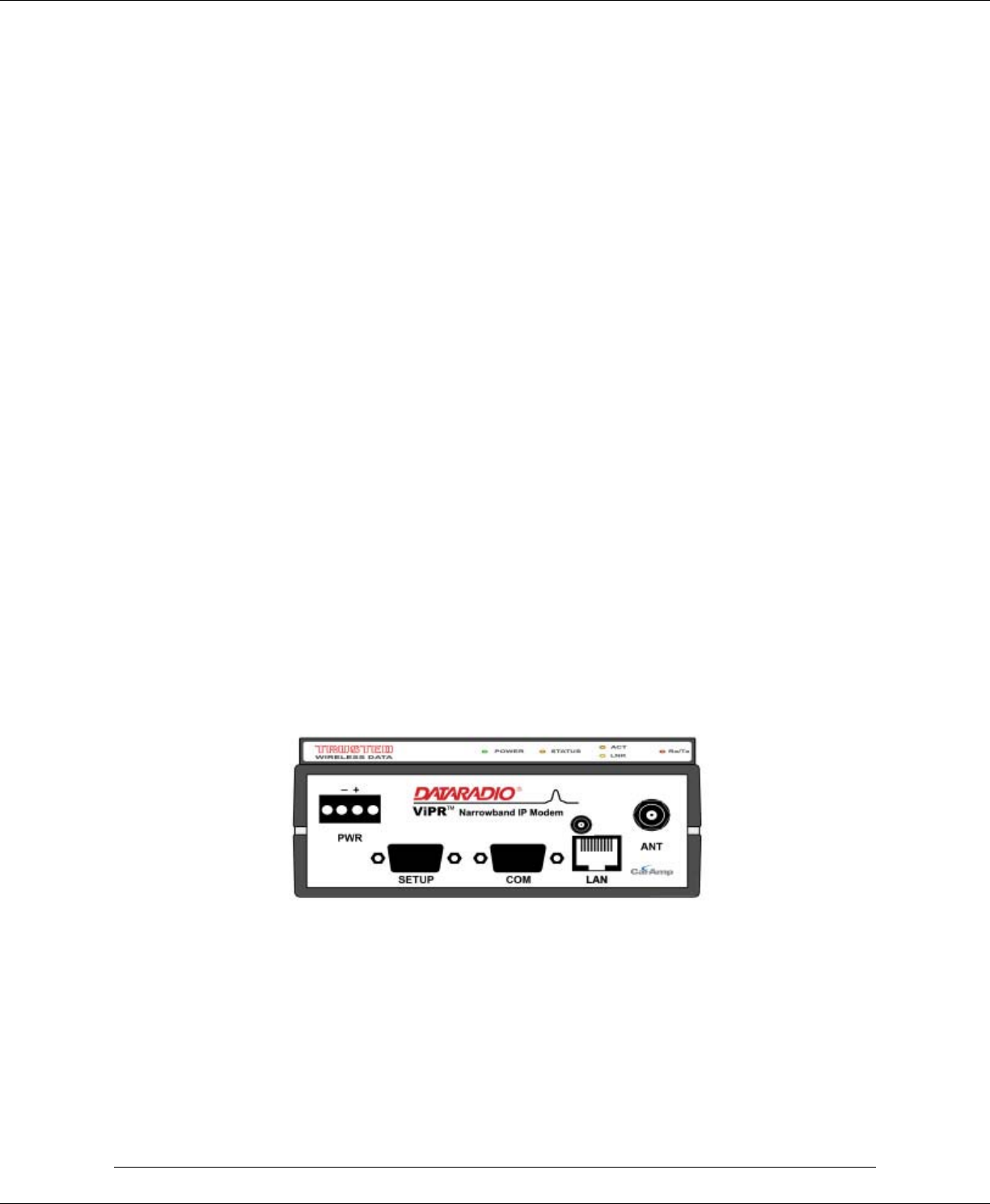
#9 ViPR User Manual_Rev2.doc Page 9
These features provide system benefits that give users:
Rugged Packaging. ViPR is housed in a compact and rugged cast aluminum case. Built
for industrial applications in a variety of environments, ViPR operates over an extended
temperature range and provides worry-free operation in the roughest environments.
Simple Installation. Basic installation typically utilizes an omni-directional antenna at the
master station or Relay Point and a directional antenna at each remote site not a Relay
Point. See Section 2 for information on Site and Antenna Selection. For basic service, just
hook up an antenna, connect your Ethernet LAN to the ViPR’s LAN port, apply primary
power, check and set a few operating parameters and you are done.
Flexible Management. Configuration, commissioning, maintenance and troubleshooting
can be done locally or remotely. There are no physical switches or adjustments; all
operating parameters are set via a web browser. The Dual-Port ViPR provides a receive
antenna connector allowing for unique customer applications requiring additional receive
filtering, external PA(s), and other options.
Long Range. Narrowband configurations allow better coverage over harsh terrain.
PHYSICAL DESCRIPTION
ViPR consists of two logic PCBs, one that includes the modem circuitry and the other the
radio module. Both are installed in a cast aluminum case. The unit is not hermetically
sealed and should be mounted in a suitable enclosure when dust, moisture, and/or a
corrosive atmosphere are anticipated.
The ViPR is designed for easy installation and configuration; the ViPR features no external or
internal switches or adjustments. All operating parameters are set via an internal web
browser.
Front Panel
Figure 1.1 ViPR Front Panel (Dual-port model shown)

#9 ViPR User Manual_Rev2.doc Page 10
As shown in Figure 1.1, the front panel has the following connections:
(1) RJ-45 LAN 10 BaseT Ethernet connection with Auto-MDIX
(1) 50-ohm TNC female Antenna connector
(1) 50-ohm SMA female receive antenna connector (Dual-Port models only)
(1) Right-angle power connector (10-30 VDC)
(2) DE-9F RS-232 ports
For Dual-port ViPR connections, see Section 1.3.6.
LED Panel
The LED panel has five Tri-Color LEDs. The functionality of each LED is shown in Table 1.1.
Table 1.1 ViPR LED Functionality
LED Color Definition
Power Green
Red ViPR ready, normal operations
ViPR hardware fault
Status Green
Blinking Green
Red
Amber (Solid or Blinking)
ViPR no faults, normal operations
ViPR scanning for neighbors
ViPR has a fault condition, check unit status
ViPR detects high background noise
ACT
Blinking Green
Off Ethernet activity detected on PHY link (RJ45)
No Ethernet activity on PHY link (RJ45)
Lnk Green
Off Ethernet connection established (RJ45)
No Ethernet connection (RJ45)
Rx/Tx Green
Red Receiving data
Transmitting data
Ethernet LAN Port
The Ethernet LAN port is an RJ-45 receptacle with a 10 BaseT Ethernet connection and
Auto-MDIX feature. Table 1.2 shows pin-out descriptions for the
RJ-45 port.
Table 1.2 Pin-out for IEEE-802.3 RJ-45 Receptacle Contacts
Contact 10 Base-T Signal
1 TXP(1)
2 TXN(1)
3 RXP(1)
4 SPARE
5 SPARE
6 RXN(1)
7 SPARE
8 SPARE
SHELL Shield
(1) The name shows the default function. Given the Auto-MDIX capability of
the Ethernet transceiver, TX and RX function could be swapped.

#9 ViPR User Manual_Rev2.doc Page 11
SETUP and COM Ports
The SETUP and COM serial connections are DE-9F RS-232 ports.
Serial port considerations:
• ViPR radio modem SETUP and COM ports are Data Communication Equipment (DCE)
devices
• In general, equipment connected to the ViPR’s SETUP / COM serial port is Data
Terminal Equipment (DTE) and a straight-through cable is recommended.
Note: If a DCE device is connected to the ViPR SETUP / COM port, a null modem
cable/adapter is required.
The pin-out for the SETUP and COM ports are shown in Table 1.3.
Table 1.3 Pin-out for DCE SETUP and COM port, 9 Contact DE-9 Connector
Contact EIA-232F Function Signal Direction
1 DCD(1) DTE ← DCE
2 RXD DTE ← DCE
3 TXD DTE → DCE
4 DTR DTE → DCE
5 GND DTE --- DCE
6 DSR(2) DTE ← DCE
7 RTS(1) DTE → DCE
8 CTS(1) DTE ← DCE
9 RING
(3) DTE --- DCE
(1) Programmable.
(2) Always asserted
(3) For future use
The DCD, DTR, RTS and CTS control lines are programmable. Refer to section 6.4 for serial
port control line configurations.
Power Connector
The ViPR is supplied with a right-angle power connector (10-30 VDC). Table 1.4 shows the
pin-out of the power connector.
Table 1.4 Pin-out of the power connector
Contact #
(Left to Right) Color Description
4 Fan Power Output (5V)
3 Black Ground
2 Red Positive (10-30) VDC
1 White Enable
Note: The White Enable line must be tied to the red positive lead of the connector for the
ViPR to function.
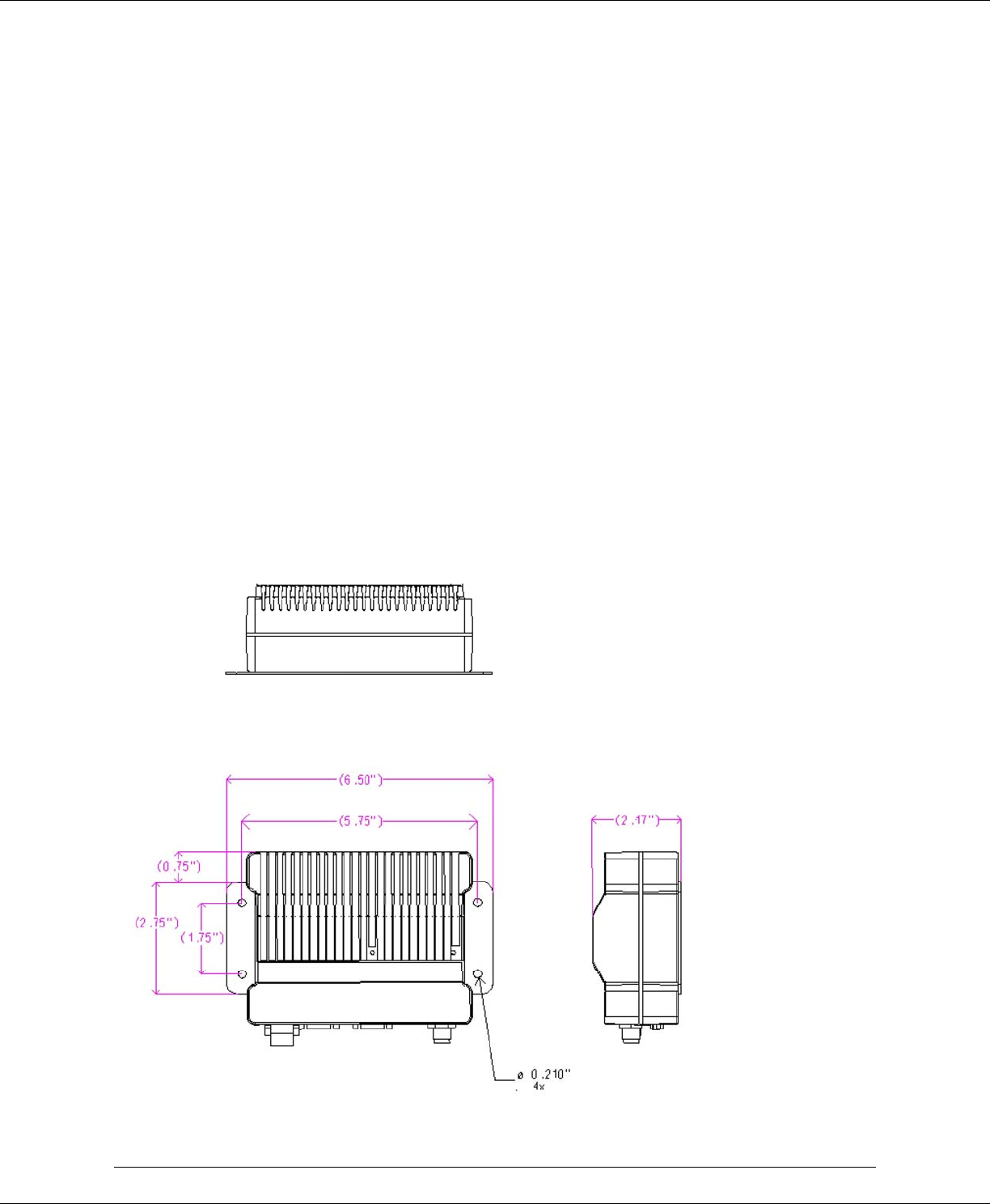
#9 ViPR User Manual_Rev2.doc Page 12
Antenna Connector
The standard ViPR has a 50-ohm TNC female antenna connector. This connection functions
for both transmit and receive.
The Dual-Port ViPR has a 50-ohm TNC female antenna connector functioning for transmit
(only) and a 50-ohm SMA female antenna connector functioning for receive (only). The
separate receive antenna connector allows for unique customer applications that require
additional receive filtering, external PA(s) and other options.
Warning: The transmit antenna port must not be connected directly to the receive
antenna port of the Dual-Port ViPR. Excessive power into the receive antenna port
will damage the radio. Input power to the receiver should not exceed 17 dBm
(50mW).
To reduce potential interference, the antenna type and its gain should be chosen to ensure
the effective isotropic radiated power (EIRP) is not more than required for successful
communication.
Chassis Dimensions
Figure 1.2 shows the dimensions of the ViPR Chassis and mounting plate.
Figure 1.2 ViPR Chassis Dimensions (units are in inches)

#9 ViPR User Manual_Rev2.doc Page 13
PART NUMBERS AND AVAILABILITY
ViPR Radio
Table 1.5 provides a breakdown of the ViPR part number 140-50X8-Y0Z.
Table 1.5 - Part Number Breakdown
X Y Z
1 VHF 5 136 – 174 MHz 0 Standard
4 UHF 3 406.1 – 470 MHz 1 Dual-Port
4 UHF 5 450 – 512 MHz
9 900 5 928 – 960 MHz
Accessories and Options
Tables 1.6-1.8 list standard accessories (including antenna, feedline, and connectors) tested
and approved for use with the ViPR.
Table 1.6 - Accessories
ITEM PART NUMBER
Power Cable 697-5100-001
ViPR Demo Kit* – VHF - 136-174 MHz 250-5018-500
ViPR Demo Kit* – UHF - 406-470 MHz 250-5048-300
ViPR Demo Kit* – UHF - 450-512 MHz 250-5048-500
Factory Installed ViPR Fan Kit 150-5008-001
Field Installed ViPR Fan Kit** 150-5008-002
TNC-Male to N-Male 18” 250-0697-103
TNC-Male to N-Male 48” 250-0697-104
TNC-Male to N-Male 72” 250-0697-105
TNC-Male to N-Female 18” 250-0697-106
* The ViPR Demo Kit includes two of each of the following: ViPR, rubber duck antennas, adapters, attenuators,
power cables, and power supplies.
** The field install Fan Kit is available for all UHF/900 ViPRs (140-5048-xxx/140-5098-xxx) but is only available for
VHF models-(140-5018-xxx) with RF revision 0.3 or greater (shipping Fall 2008). Contact CalAmp Technical
Support for more information.

#9 ViPR User Manual_Rev2.doc Page 14
Table 1.7 Antenna Kits
ITEM PART NUMBER
Antenna Kit*: 138-143 MHz 6.5 dBd 250-0211-007
Antenna Kit*: 138-143 MHz 9.5 dBd 250-0211-010
Antenna Kit*: 143-148 MHz 6.5 dBd 250-0211-107
Antenna Kit*: 143-138 MHz 9.5 dBd 250-0211-110
Antenna Kit*: 148-152 MHz 6.5 dBd 250-0211-207
Antenna Kit*: 148-152 MHz 9.5 dBd 250-0211-210
Antenna Kit*: 152-157 MHz 6.5 dBd 250-0211-307
Antenna Kit*: 152-157 MHz 9.5 dBd 250-0211-310
Antenna Kit*: 157-163 MHz 6.5 dBd 250-0211-407
Antenna Kit*: 157-163 MHz 9.5 dBd 250-0211-410
Antenna Kit*: 163-169 MHz 6.5 dBd 250-0211-507
Antenna Kit*: 163-169 MHz 9.5 dBd 250-0211-510
Antenna Kit*: 169-174 MHz 6.5 dBd 250-0211-607
Antenna Kit*: 169-174 MHz 9.5 dBd 250-0211-610
Antenna Kit*: 450-470 MHz, 7 dBd 250-0241-507
Antenna Kit*: 450-470 MHz, 10 dBd 250-0241-510
Antenna Kit*: 890-960 MHz, 6.4 dBd 250-5099-011
Antenna Kit*: 890-960 MHz, 10 dBd 250-5099-021
*Kits include premium antenna, mounting bracket, surge protector, grounding kit, cable ties, 18” TNC male to N-
male jumper cable and weather kit. UHF kits include 25 feet of LMR400 antenna feedline. Feedline is available for
VHF kits in 25 or 50 feet lengths.
Table 1.8 - Feedline and Connectors
ITEM PART NUMBER
25 feet antenna feedline (LMR400), N-Male 250-0200-025
50 feet antenna feedline (LMR400), N-Male 250-0200-055
Barrel Connector, RF1 N type, Female 250-0200-100
PRODUCT WARRANTY
It is our guarantee that every ViPR Radio modem will be free from physical defects in
material and workmanship for TWO YEARS from the date of purchase when used within the
limits set forth in Appendix A: Specifications.
The manufacturer's warranty statement is available in Appendix B. If the product proves
defective during the warranty period, contact our Customer Service Department to obtain a
Return Material Authorization (RMA). BE SURE TO HAVE THE EQUIPMENT MODEL, SERIAL
NUMBER, AND BILLING & SHIPPING ADDRESSES AVAILABLE WHEN CALLING. You may also
request an RMA online at www.calamp.com/component/option,com_rma/
FACTORY AND TECHNICAL SUPPORT
M-F 7:30-4:30 CST
CalAmp Wireless DataCom
299 Johnson Ave., Ste 110, Waseca, MN 56093
Tel 507.833.8819; Fax 507.833.6758
Email imcsupport@calamp.com

#9 ViPR User Manual_Rev2.doc Page 15
RMA REQUEST
When returning a product, mark the RMA clearly on the outside of the package. Include a
complete description of the problem and the name and telephone number of a contact
person. RETURN REQUESTS WILL NOT BE PROCESSED WITHOUT THIS INFORMATION.
Contact Customer Service:
299 Johnson Ave., Ste 110, Waseca, MN 56093
Tel 1.507.833.8819
BE SURE TO HAVE THE EQUIPMENT MODEL AND SERIAL NUMBER, AND BILLING AND
SHIPPING ADDRESSES ON HAND WHEN CALLING.
For units in warranty, customers are responsible for shipping charges to CalAmp Wireless
DataCom. For units returned out of warranty, customers are responsible for all shipping
charges. Return shipping instructions are the responsibility of the customer.
DOCUMENTATION AND DOWNLOADS
CalAmp reserves the right to update its products, software, or documentation without
obligation to notify any individual or entity. Product updates may result in differences
between the information provided in this manual and the product shipped. For access to
the most current product documentation and application notes, visit
www.calamp.com/home/download_library.html
S
SY
YS
ST
TE
EM
M
A
AR
RC
CH
HI
IT
TE
EC
CT
TU
UR
RE
E
A
AN
ND
D
N
NE
ET
TW
WO
OR
RK
K
P
PL
LA
AN
NN
NI
IN
NG
G
This section briefly discusses network architecture (including basic network types),
interfacing modems and DTE, data protocols for efficient channel operation, addressing, and
repeaters.
ViPR is designed to replace wire lines in SCADA, telemetry and control applications. The
Ethernet and RS-232 serial port allows direct connection to Programmable Logic Controllers
(PLCs) or Remote Terminal Units (RTUs). A SCADA system is defined as one or more
centralized control sites used to monitor and control remote field devices over wide areas.
For example, a regional utility may monitor and control networks over an entire
metropolitan area. Industry sectors with SCADA systems include energy utilities, water and
wastewater utilities, and environmental groups.
The ViPR is intended for use in the Industrial Monitoring and SCADA market. The range of
the ViPR is dependent on terrain, RF (radio frequency) path obstacles, and antenna system
design. This section provides tips for selecting an appropriate site, choosing an antenna
system, and reducing the chance of harmful interference.
SINGLE COVERAGE AREA
In a network topology with only a single coverage area (all units can talk to one another
directly), there are several common system configurations.
The most common is for one unit to be designated as a master and the rest designated as
remotes. Another system configuration is Report-by-Exception.
MASTER/REMOTE
In a ViPR network, ViPRs are not programmed to be masters or remotes. All ViPRs in a
network can be configured the same. However, a unit can be configured as an Access Point.

#9 ViPR User Manual_Rev2.doc Page 16
The unit configured as an Access Point would allow access to the Internet, but an Access
Point is not required in all networks. Most SCADA networks have a “polling master”, but the
polling master is not necessarily configured any different than the remotes. It is the
responsibility of the polling master to control RF traffic so RF collisions do not occur.
Note: In a radio system, only one radio should transmit at a time. If two radios
transmit at the same time to another radio, RF collisions occur. Collisions will
slow data traffic and possibly corrupt data.
The ViPR has RF collision avoidance technology (checks the air wave for a carrier before
transmitting) and Ethernet CSMA (Carrier Sense Multiple Access). CSMA is an Ethernet
collision avoidance mechanism technology built into to all Ethernet connections. These
technologies still need to be supplemented by the HMI/PLC polling master to optimize RF
data traffic.
Some HMI/PLC Ethernet applications may depend solely on Ethernet CSMA to control the
flow of messages to avoid RF collisions in a ViPR network. This may flood the network with
multiple polling messages, making it difficult for the RTUs to acquire the airwave to transmit
their reply messages. This will cause the RTUs to compete for airtime and a dominant RTU
may be created.
While the dominant RTU/radio is transmitting, the other RTUs will send their reply messages
to their connected ViPR. ViPRs will buffer reply messages because the dominant RTU/radio
is transmitting (carrier is present). A ViPR will buffer (while a carrier is present) a reply
message until it can capture the airwave (carrier absent) to transmit. There could be five or
six RTU/radios in a small system (or 10 or 20 in a large syste), which could be trying to
capture the airwaves to transmit. The RTUs will not respond in the order they were polled
but will respond when they are ready and have captured the airwaves. The dominant RTU is
created because it happens to reply at just the right time and be in the right order in the
polling sequence.
A common method for a polling master to manage RF traffic is for the HMI/PLC polling
master to poll one remote at a time. The next polling message is not sent until the current
message has been completed (“Done”) or has timed out. This prevents more than one
outstanding polling message. Ladder logic programs typically refer to these parameters as
the message “Done” and “Error” bits. The “Done” and “Error” bits parameter values can be
adjusted for longer timeout values, if required.
Because the ViPR has the ability to use two completely different and separate SCADA polling
protocols, it is important to have interaction between the two protocols. The ViPR can send
out an Ethernet TCP/IP polling message and also an RS232 polling message, which may or
may not be generated by the same HMI/PLC. CalAmp recommends the user program the
polling sequence in each protocol with logic that interacts with the other’s protocol “Done”
and “Error” bits. The Ethernet polling protocol would not be allowed to send a message
until the current Ethernet message is either “Done” or “Error” and the previous RS232
message are either “Done” or “Error” bits are set. The RS232 polling protocol would also
have a similar logic.
POINT-TO-POINT
A point-to-point network is the most simple of all networks, and may be used for connecting
a pair of PC's, a host computer and a terminal, a SCADA polling master and one remote,
mobile applications (like in-vehicle GPS receivers and base stations) or a wide variety of
other networking applications.
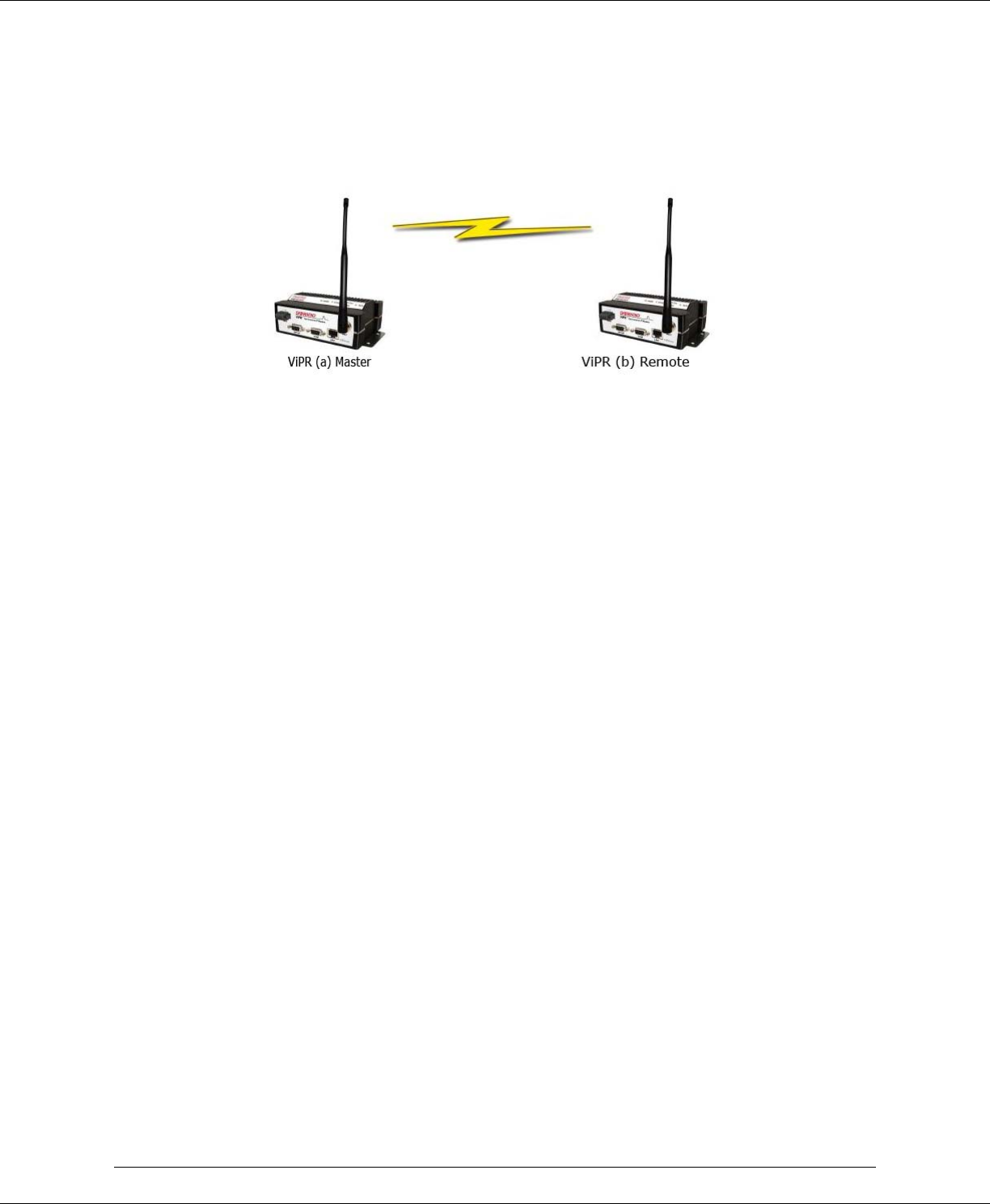
#9 ViPR User Manual_Rev2.doc Page 17
System configurations indicated above allow for either Ethernet or serial interfaces. In
bridge mode, all the network devices are on the same IP subnet. In router mode, the
Ethernet connection on the polling master unit and the remote(s) use different IP subnets.
A hub or switch may be used to allow multiple devices to connect to the ViPR radio modem.
Serial connections are transparent pass-through connections, allowing the use of legacy
serial devices in the ViPR product environment.
Figure 2.1 – Point-to-Point Network
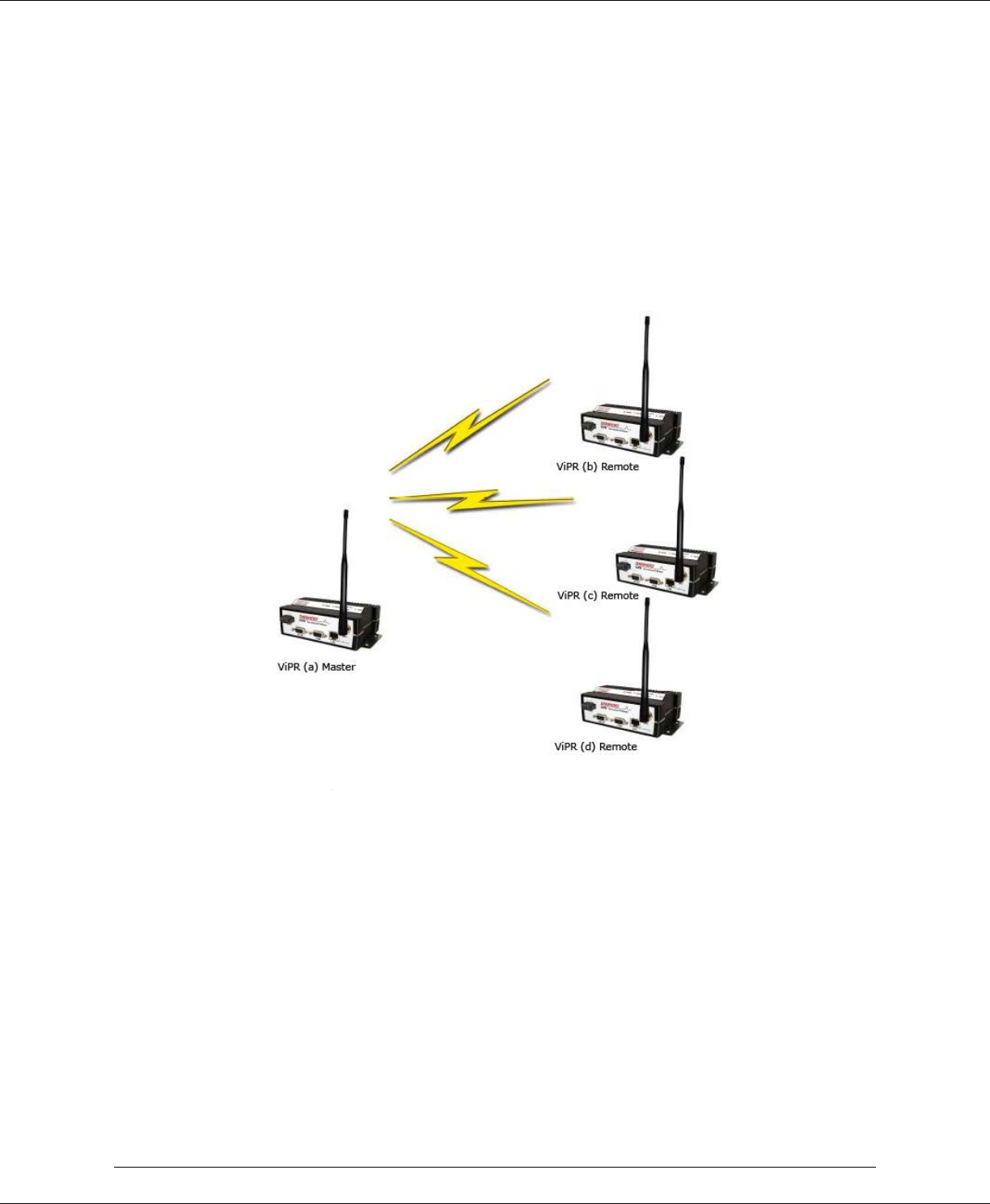
#9 ViPR User Manual_Rev2.doc Page 18
Point-to-Multipoint
A Point-to-Multipoint network is a common network type used in SCADA or other polling
systems. The single polling master station communicates with any number of remotes and
controls the network by issuing polls and waiting for remote responses. Individual PLC/RTU
remotes manage addressing and respond when their individual addresses are queried.
PLC/RTU unit addresses are maintained in a scanning list stored in the host program or
master terminal device at the SCADA host site. Communications equipment is transparent
and does not interact with specific remotes; all data is coupled to the host on a single data
line (such a network is commonly used with synchronous radio modems and asynchronous
radio modems).
Figure 2.2 – Point to Multipoint Network
Report by Exception
In a true Report by Exception configuration, the remotes send data to the master only when
an event or exception has occurred in the remote. However, most Report by Exception
systems have a master/remote polling component. The master polls the remotes once every
hour or half-hour to ensure there is still a valid communication path. In a Report by
Exception configuration, there will not be a master controlling RF traffic and RF collisions will
often occur. The ViPR has several collision avoidance features to help minimize collisions.
The ViPR is a “polite radio”. The ViPR will check the RF traffic on the receive channel before
transmitting. If there is no RF traffic present (no carrier present) it will transmit. If there is
RF traffic (carrier present) the ViPR will buffer the data. The ViPR will transmit the buffered
data when there is no RF traffic present (no carrier present).
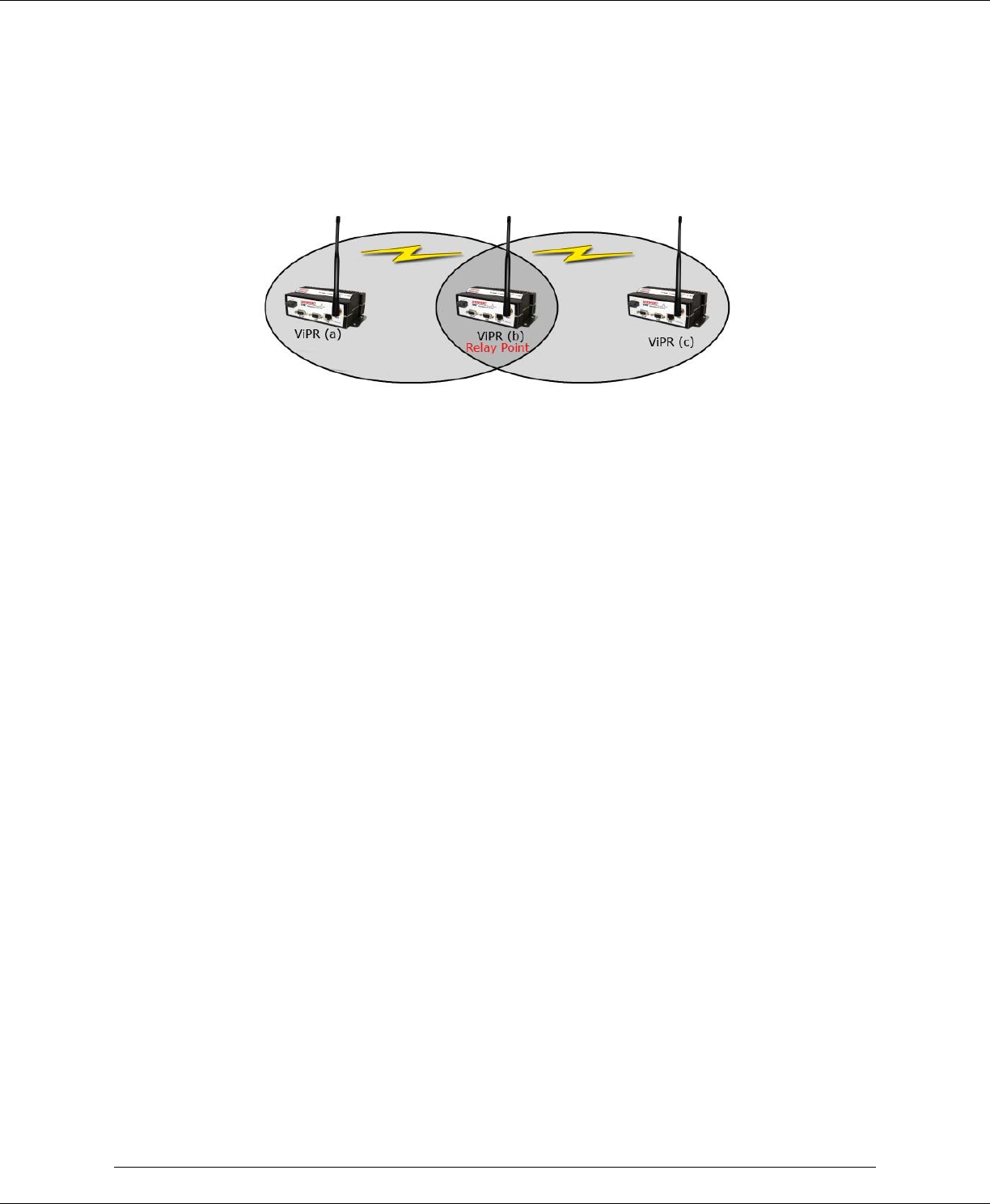
#9 ViPR User Manual_Rev2.doc Page 19
EXTENDING THE COVERAGE AREA WITH A RELAY POINT
The ViPR has a Relay Point feature that allows a unit to relay data from one RF coverage
area to another RF coverage area. When units are spread over two or more coverage areas,
the user must identify the devices forming the backbone between coverage areas so any
unit can talk to any other regardless of their locations. There can be multiple Relay Points
in the system extending the coverage over several hops.
Figure 2.3 - Two Coverage Areas
The unit forming the backbone between the coverage areas must be configured to repeat all
necessary information from one coverage area to the next. This unit must have the Relay
Point parameter enabled (See Section 6.1).
Understanding RF Path Requirements
Radio waves are propagated when electrical energy produced by a radio transmitter is
converted into magnetic energy by an antenna. Magnetic waves travel through space. The
receiving antenna intercepts a very small amount of this magnetic energy and converts it
back into electrical energy that is amplified by the radio receiver. The energy received by
the receiver is called the Received Signal Strength Indication (RSSI) and is measured in
dBm.
A radio modem requires a minimum amount of received RF signal to operate reliably and
provide adequate data throughput. This is the radio’s receiver sensitivity. In most cases,
spectrum regulators will define or limit the amount of signal that can be transmitted and it
will be noted on the FCC license. This is the effective isotropic radiated power (EIRP).
Transmitted power decays with distance and other factors as it moves away from the
transmitting antenna.
SITE SELECTION AND SITE SURVEY
Site Selection
For a successful installation, careful thought must be given to selecting the site for each
radio. Suitable sites should provide the following:
Protection from direct weather exposure
A source of adequate and stable primary power
Suitable entrances for antenna, interface, or other cabling
Antenna location with an unobstructed transmission path to all remote radios in the
system
These requirements can be quickly determined in most cases.

#9 ViPR User Manual_Rev2.doc Page 20
Site Survey
A Site Survey is an RF propagation study of the RF path between two points or between one
point and multiple points. UHF radio signals travel primarily by line of sight and
obstructions between the sending and receiving stations will affect system performance.
Signal propagation is also affected by attenuation from obstructions such as terrain, foliage,
or buildings in the transmission path. A Site Survey is recommended for most projects to
determine the optimal RF paths for each link. This is especially true when more than one RF
coverage area is required. A Site Survey will determine the best unit location for the Relay
Points.
SELECTING ANTENNA AND FEEDLINE
The ViPR can be used with a variety of antenna types. The exact style used depends on the
physical size and layout of a system. The ViPR device has been tested and approved with
antennas having a maximum gain of 10 dBi.
Antenna Gain
Antenna gain is usually measured in comparison to a dipole. A dipole acts much like the
filament of a flashlight bulb: it radiates energy in almost all directions. One bulb like this
would provide very dim room lighting. Add a reflector capable of concentrating all the
energy into a narrow angle of radiation and you have a flashlight. Within that bright spot
on the wall, the light might be a thousand times greater than it would be without the
reflector. The resulting bulb-reflector combination has a gain of 1000, or 30 dB, compared
to the bulb alone. Gain can be achieved by concentrating the energy both vertically and
horizontally, as in the case of the flashlight and Yagi antenna. Gain can be also be achieved
by reducing the vertical angle of radiation, leaving the horizontal alone. In this case, the
antenna will radiate equally in all horizontal directions, but will take energy that otherwise
would have gone skywards and use it to increase the horizontal radiation.
The required antenna impedance is 50 ohms. To reduce potential radio interference, the
antenna type and its gain should be chosen to ensure the effective isotropic radiated power
(EIRP) is not more than required for successful communication.
See Table 1.7 for a list of tested antenna recommendations. These antennas are FCC
approved for use with the ViPR. Similar antenna types from other manufacturers are equally
acceptable. It is important to follow the manufacturer’s recommended installation
procedures and instructions when mounting any antenna.
Omni Directional Antenna
In general, an omni directional antenna should be used at a master station and Relay
Points. This allows equal coverage to all of the remote locations. Omni directional antennas
are designed to radiate the RF signal in a 360-degree pattern around the antenna. Short
range antennas such as folded dipoles and ground independent whips are used to radiate
the signal in a ball shaped pattern while high gain omni antennas, such as a collinear
antenna, compress the RF radiation sphere into the horizontal plane to provide a relatively
flat disc shaped pattern that travels further because more of the energy is radiated in the
horizontal plane.

#9 ViPR User Manual_Rev2.doc Page 21
Yagi Antenna
At remote locations (not used as a Relay Point), a directional Yagi is generally
recommended to minimize interference to and from other users.
Vertical Dipoles
Vertical dipoles are very often mounted in pairs, or sometimes groups of 3 or 4, to achieve
even coverage and to increase gain. The vertical collinear antenna usually consists of
several elements stacked one above the other to achieve similar results.
Figure 2.4 - Antenna Types
Omni (Vertical Collinear) Yagi Vertical Dipole
Feedline
The choice of feedline should be carefully considered. Poor quality coaxial cables should be
avoided, as they will degrade system performance for both transmission and reception. The
cable should be kept as short as possible to minimize signal loss. See Table 2.1 for a list of
feedline recommendations.
Table 2.1 - Transmission Loss (per 100 Feet)
Cable Type UHF VHF
LMR-400 2.7 dB 1.5 dB
1/2” Heliax 1.51 dB 0.68 dB
7/8” Heliax 0.83 dB 0.37 dB
1 5/8” Heliax 0.51 dB 0.22 dB
Outside cable connections should have a weather kit applied to each connection to prevent
moisture. Feedline connections should be routinely inspected to minimize signal loss
through the connection. A 3 dB loss in signal strength due to cable loss and/or bad
connections represents a 50% reduction in signal strength.
RF Exposure Compliance Requirements
The ViPR radio is intended for use in the Industrial Monitoring and Control and SCADA
markets. The ViPR unit must be professionally installed and must ensure a minimum
separation distance listed in the table below between the radiating structure and any
person. An antenna mounted on a pole or tower is the typical installation and in rare
instances, a 1/2-wave whip antenna is used.
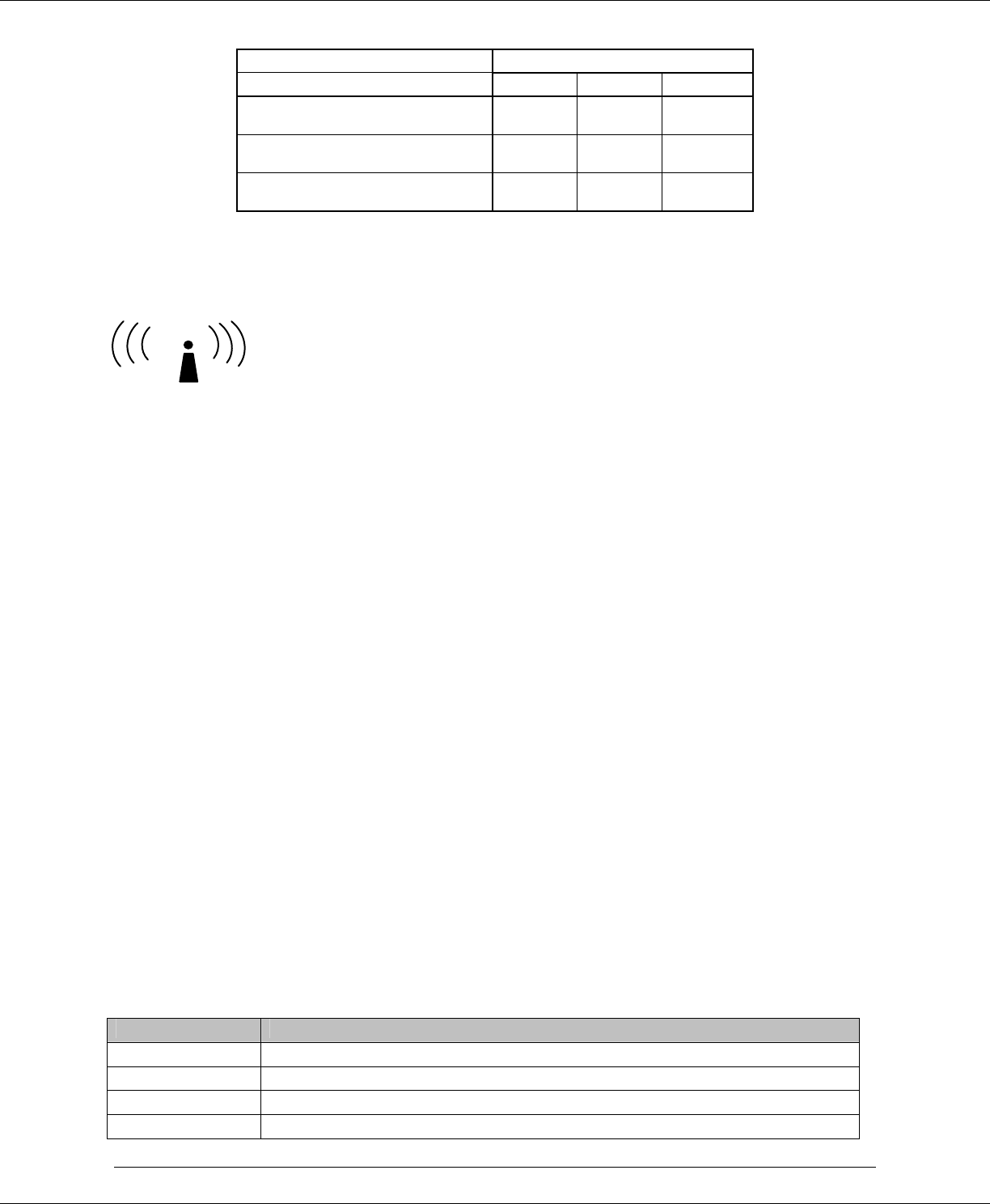
#9 ViPR User Manual_Rev2.doc Page 22
Antenna Gain
5 dBi 10 dBi 15 dBi
Min Safety Distance (VHF @
max power) 123cm 218.8cm 389cm
Min Safety Distance (UHF @
max power) 105.7cm 188cm 334.4cm
Min Safety Distance (900Mhz @
max power) 63.8cm 115 cm 201.7 cm
Note: It is the responsibility of the user to guarantee compliance with the FCC
MPE regulations when operating this device in a way other than described above.
The ViPR radio uses a low power radio frequency transmitter. The concentrated energy from
an antenna may pose a health hazard. People should not be in front of the
antenna when the transmitter is operating.
The installer of this equipment must ensure the antenna is located or pointed such that it
does not emit an RF field in excess of Health Canada limits for the general population.
Recommended safety guidelines for the human exposure to radio frequency electromagnetic
energy are contained in the Canadian Safety Code 6 (available from Health Canada) and the
Federal Communications Commission (FCC) Bulletin 65.
Any changes or modifications not expressly approved by the party responsible for
compliance (in the country where used) could void the user's authority to operate the
equipment.
TERRAIN AND SIGNAL STRENGTH
A line of sight path between stations is highly desirable and provides the most reliable
communications link in all cases. A line of sight path can often be achieved by mounting
each station antenna on a tower or other elevated structure that raises it high enough to
clear surrounding terrain and other obstructions.
The requirement for a clear transmission path depends on the distance to be covered by the
system. If the system is to cover a limited distance, say 3-5 miles, then some obstructions
in the transmission path may be tolerable. For longer-range systems, any obstruction could
compromise the performance of the system, or block transmission entirely.
The signal strength (RSSI) at the receiver must exceed the receiver sensitivity by an
amount known as the fade margin to provide reliable operation under various conditions.
Fade margin (expressed in dB) is the maximum tolerable reduction in received signal
strength, which still provides an acceptable signal quality. This compensates for reduced
signal strength due to multi-path, slight antenna movement or changing atmospheric
losses. CalAmp recommends a 30 dB fade margin for most projects. Table 2.2 shows the
RSSI versus Reliability.
Table 2.2 RSSI Reliability
RSSI Reliability
-100 dBm Approximately 50% reliability. Fading may cause frequent data loss.
-90 dBm Approximately 90% reliability. Fading will cause occasional data loss.
-80 dBm Approximately 99% reliability. Reasonable tolerance to most fading.
-70 dBm Approximately 99.9% reliability with high tolerance to fading.
RF Exposure
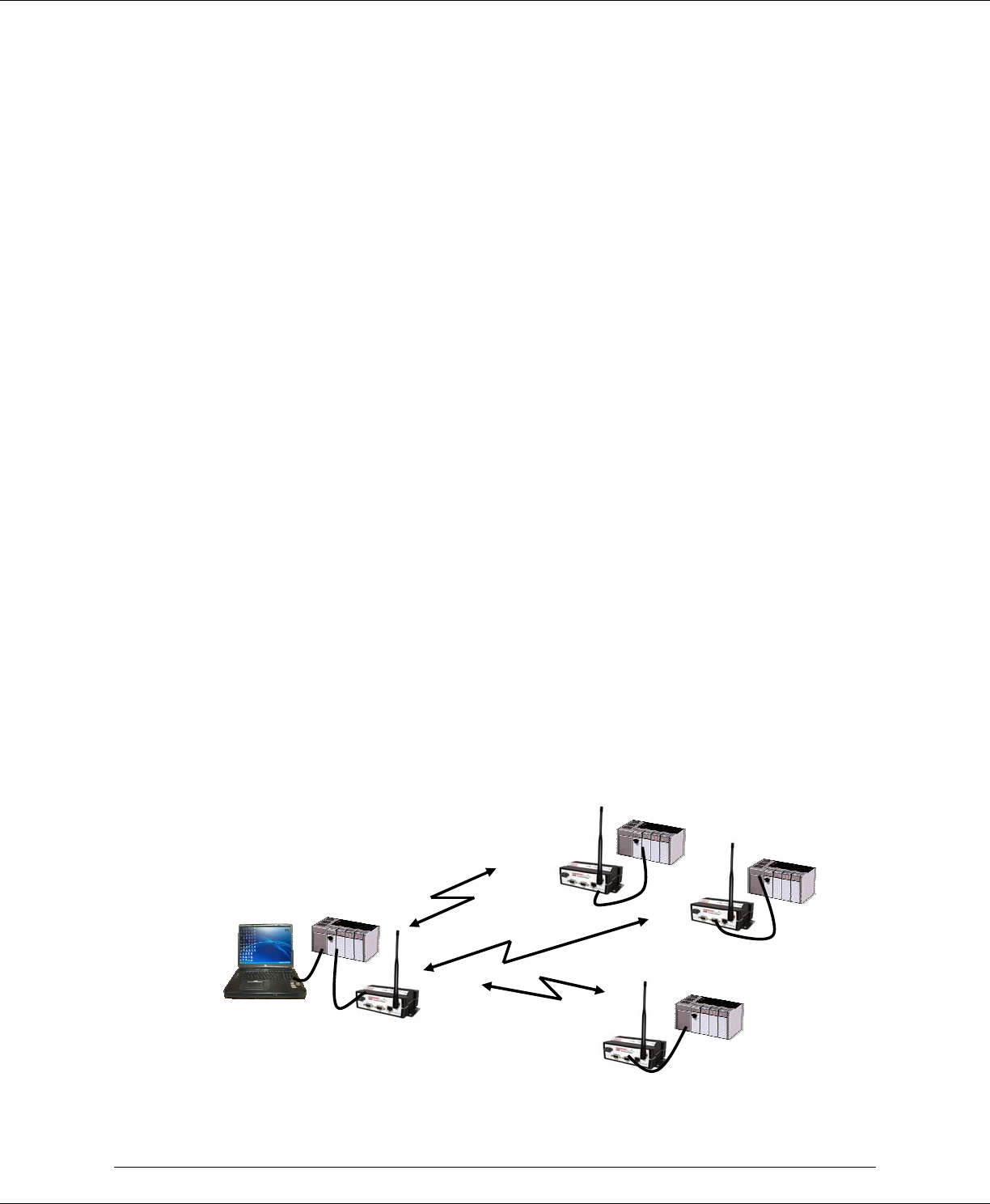
#9 ViPR User Manual_Rev2.doc Page 23
RADIO INTERFERENCE
Interference is possible in any radio system. However, since the ViPR is designed for use in
a licensed system, interference is less likely because geographic location and existing
operating frequencies are normally taken into account when allocating frequencies.
The risk of interference can be further reduced through prudent system design and
configuration. Allow adequate separation between frequencies and radio systems. Keep the
following points in mind when setting up your radio system.
a. Systems installed in lightly populated areas are least likely to encounter interference,
while those in urban and suburban areas are more likely to be affected by other
devices.
b. Directional antennas should be used at the remote end of the link. They confine the
transmission and reception pattern to a comparatively narrow beam, which
minimizes interference to and from stations located outside the pattern.
c. If interference is suspected from another system, it may be helpful to use antenna
polarization opposite to the interfering system’s antennas. An additional 20 dB (or
more) of attenuation to interference can be achieved by using opposite antenna
polarization.
d. Check with your CalAmp sales representative or CalAmp Technical Services for
additional options. The Technical Services group has qualified personnel to help
resolve your RF issues.
IP FORWARDING MODES
Bridge Mode
Bridge mode requires less setup than Router mode. In Bridge mode, the IP Router does not
contain IP/Network properties accessible through the network; they are transparent to the
network. Only the PC Server and the RTU Client’s Network properties need configuration.
The Server’s Gateway will direct the Server to all remote Clients on the network. The PC
Server will broadcast to all the RTU Clients bridged to the PC Server. Bridge mode may be
used when all devices are located on the same Local Area Network (LAN). Figure 2.5 shows
a ViPR Bridge Mode configuration.
Figure 2.5 ViPR Bridge Mode Configuration
ViPR
192.168.205.1
ViPR
192.168.205.3
PLC
192.168.205.40
HMI/PLC
192.168.205.10
HMI/PLC
192.168.205.100
PLC
192.168.205.30
PLC
192.168.205.20
ViPR
192.168.205.2
ViPR
192.168.205.4
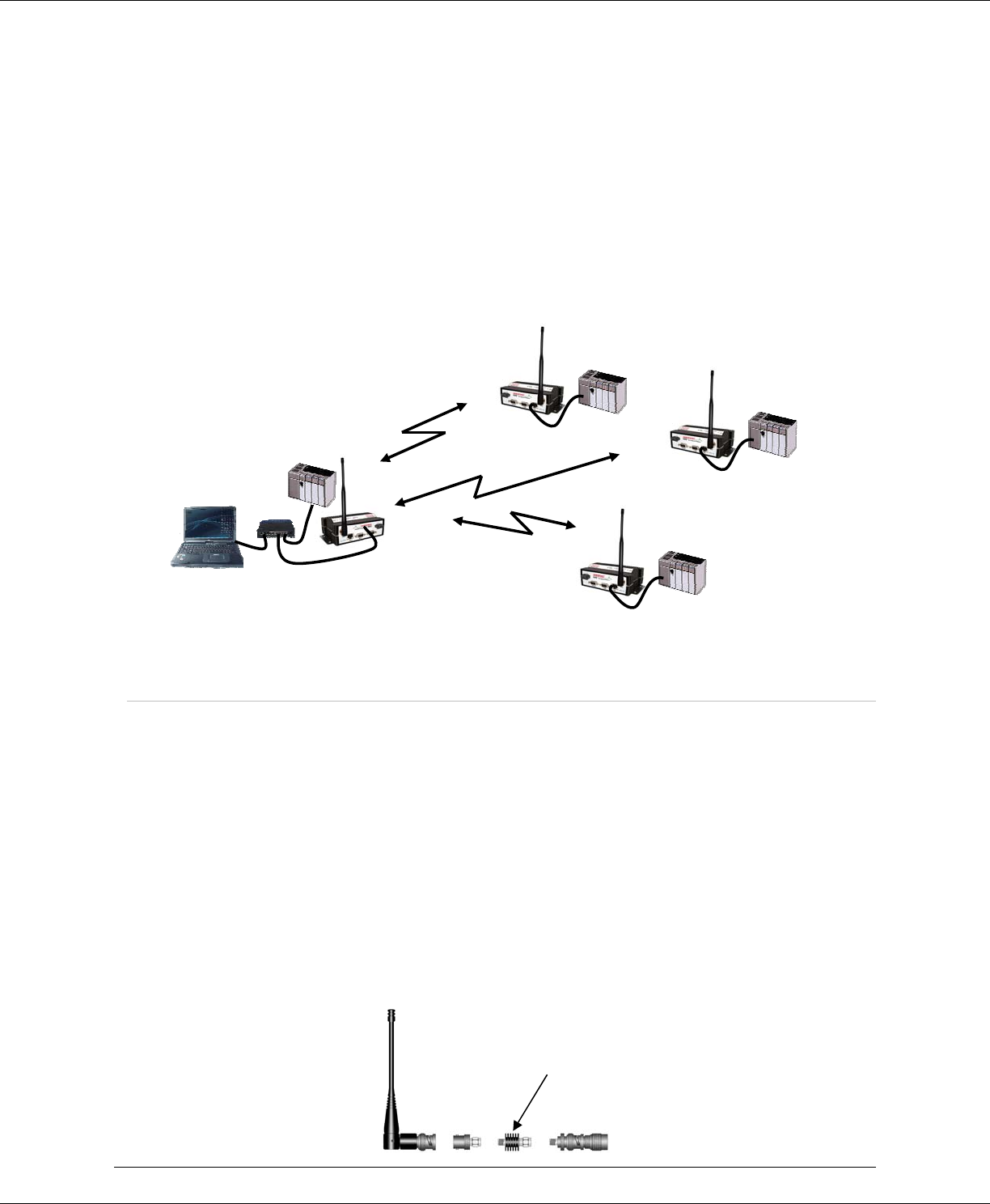
#9 ViPR User Manual_Rev2.doc Page 24
Router Mode
Router mode provides network configuration flexibility and adds RF diagnostics capability for
ViPR wireless modems. Router mode also allows greater flexibility in using different
protocols. Diagnostics can be retrieved through the Ethernet port of the ViPR. This
configuration is recommended for users who have IT/Network support readily available to
them and the authorization required to make changes in the network. Router mode
requires set up of IP/Ethernet and Serial IP addresses. Figure 2.6 shows a ViPR Router Mode
configuration.
F
Fi
ig
gu
ur
re
e
2
2.
.6
6
V
Vi
iP
PR
R
R
Ro
ou
ut
te
er
r
M
Mo
od
de
e
C
Co
on
nf
fi
ig
gu
ur
ra
at
ti
io
on
nD
DA
AT
TA
AR
RA
AD
DI
IO
O
V
VI
IP
PR
R
Q
QU
UI
IC
CK
K
S
ST
TA
AR
RT
T
SETUP AND CONFIGURATION
It is easy to set up a ViPR network to verify basic unit operation and experiment with
network designs and configurations.
It is important to use a network IP subnet address different from others currently in use in
your test area. This will eliminate unnecessary disruption of traffic on the existing network
while you become familiar with the ViPR.
INSTALL THE ANTENNA
An RX/TX antenna is required for basic operation. For demo units only, connect the antenna
as shown in Figure 3.1 to provide stable radio communications between demo devices.
ViPR
192.168.205.1
ViPR
192.168.206.1
PLC
192.168.206.2
ViPR
192.168.207.1
PLC
192.168.207.2
ViPR
192.168.208.1
PLC
192.168.208.2
HMI/PLC
192.168.205.2
HMI/PLC
192.168.205.10
20 dB, 5 watt max, attenuator
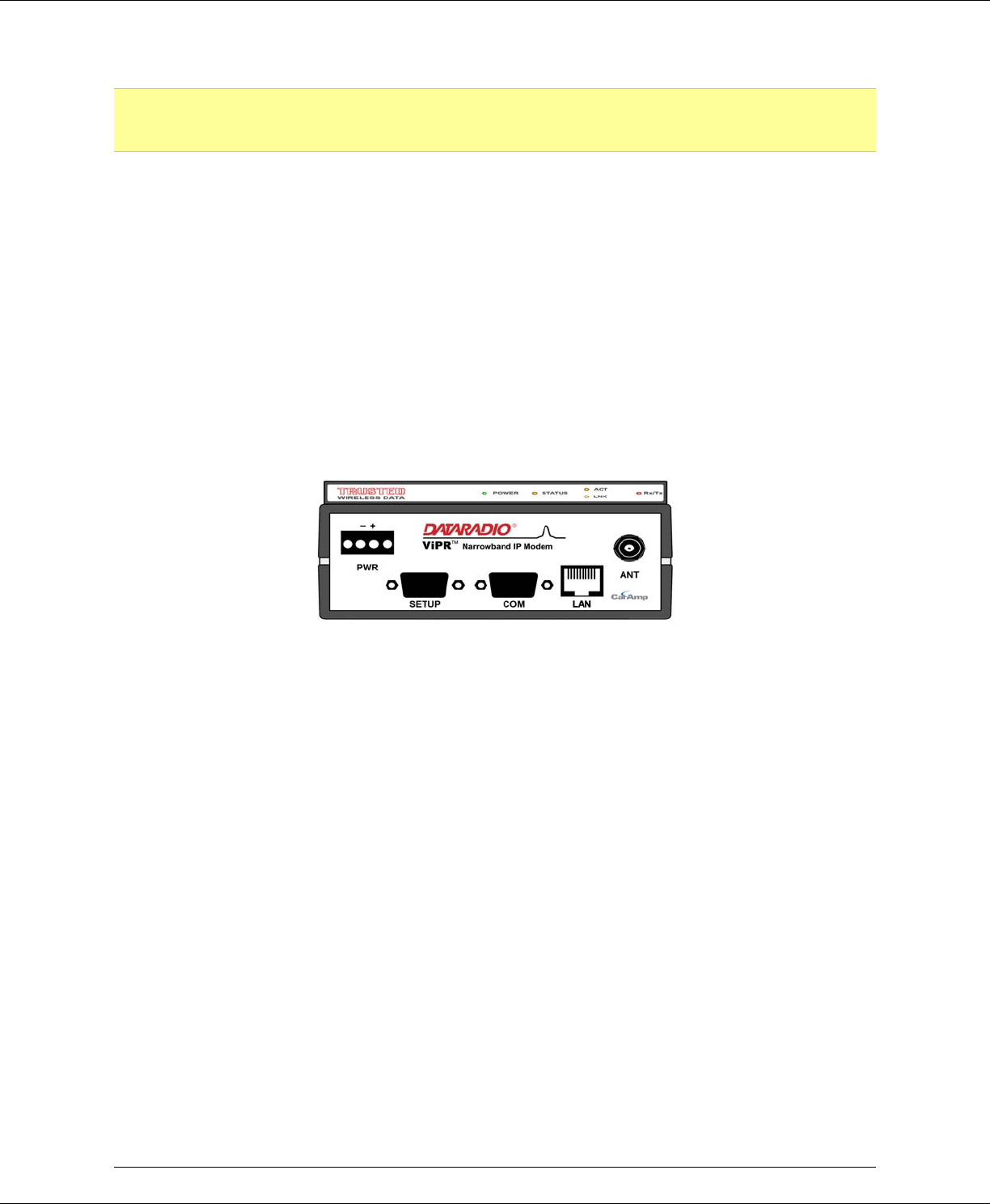
#9 ViPR User Manual_Rev2.doc Page 25
Figure 3.1 -Demo Antenna Assembly
Note:
It is important to use attenuation between all demo units in the test network to reduce the
amount of signal strength in the test environment.
PC LAN SETUP
On a PC running MS-Windows with an existing LAN connection, connect to the Ethernet
input of the ViPR and complete the steps in section 3.3.1
Front Panel Connections
Front panel connections include: (For Dual-port ViPR connections see Section 1.3.6.)
(1) RJ-45 10 BaseT Ethernet Connection
(1) 50-ohm TNC female transmit antenna connector
(1) 50-ohm SMA female receive antenna connector (Dual-port models only)
(1) Right-angle power connector (10-30 VDC)
(2) DE-9F RS-232 ports
Figure 3.2 Front Panel (Standard model shown)
STEP 1: From the Start menu on your PC, select Settings > Control Panel > Network
Connections
STEP 2: Right click the Local Area Connection icon to open the Properties box.
Scroll through the list and highlight Internet Protocol (TCP/IP).
Click Properties to open the TCP/IP Properties box.
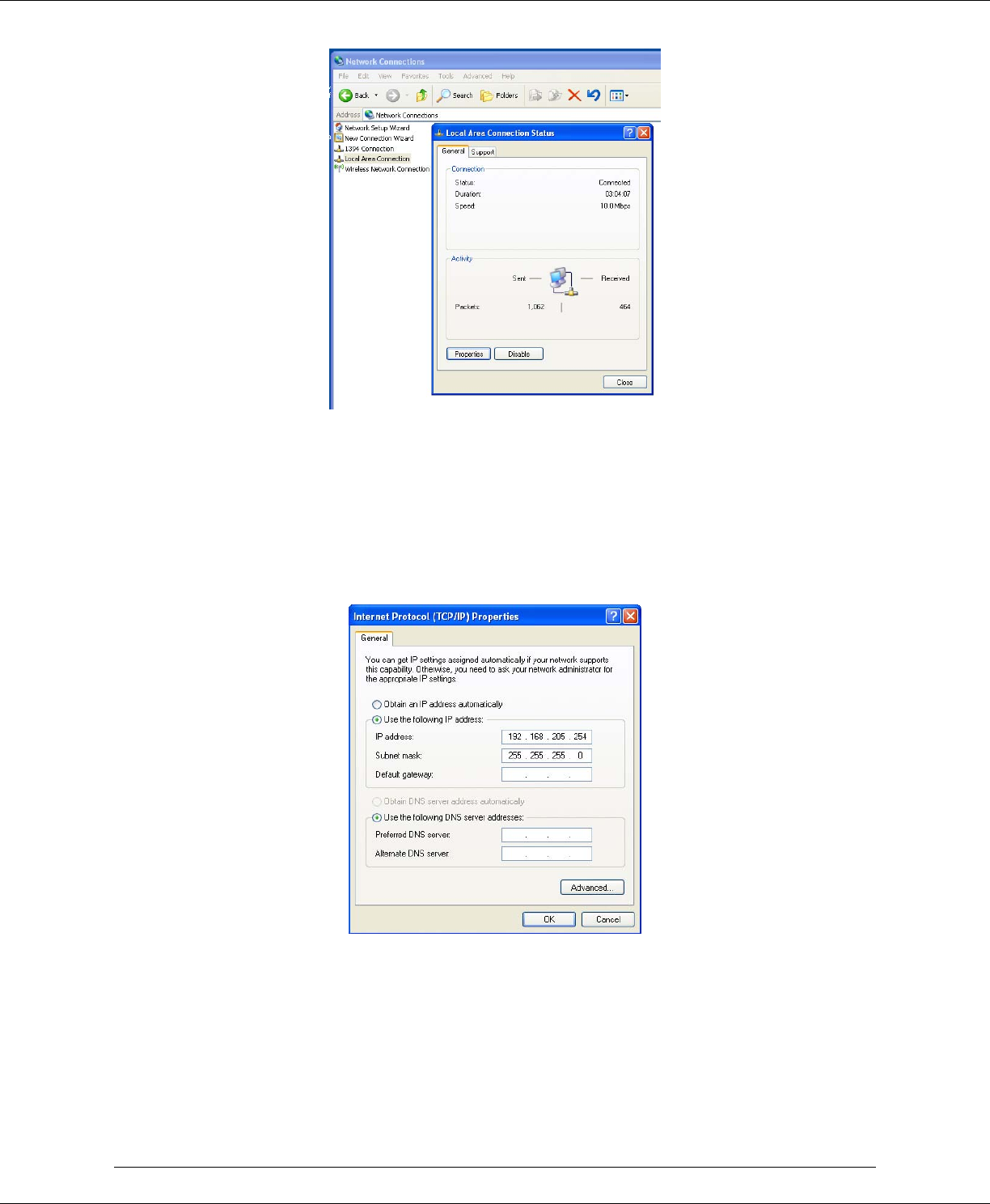
#9 ViPR User Manual_Rev2.doc Page 26
Figure 3.4 PC LAN Setup
STEP 3: Select Use the Following IP Address and enter the following values:
IP Address: 192.168.205.254
Subnet Mask: 255.255.255.0
Default Gateway: (leave empty)
Figure 3.5 PC LAN Setup: Step 3
STEP 4: Click OK to apply your changes and complete the connection process. Some
Operating systems may require a reboot to complete the connection process.
MEASURE AND CONNECT PRIMARY POWER
Primary power for the ViPR must be within 10-30 VDC and be capable of providing a
minimum of 10 watt supply for Tx @ 1W, 40 watt supply for Tx @ 5W, or 60 watt supply for
Tx @ 10 W. (In ViPR Demo Kits, a power connector with screw-terminals is provided with
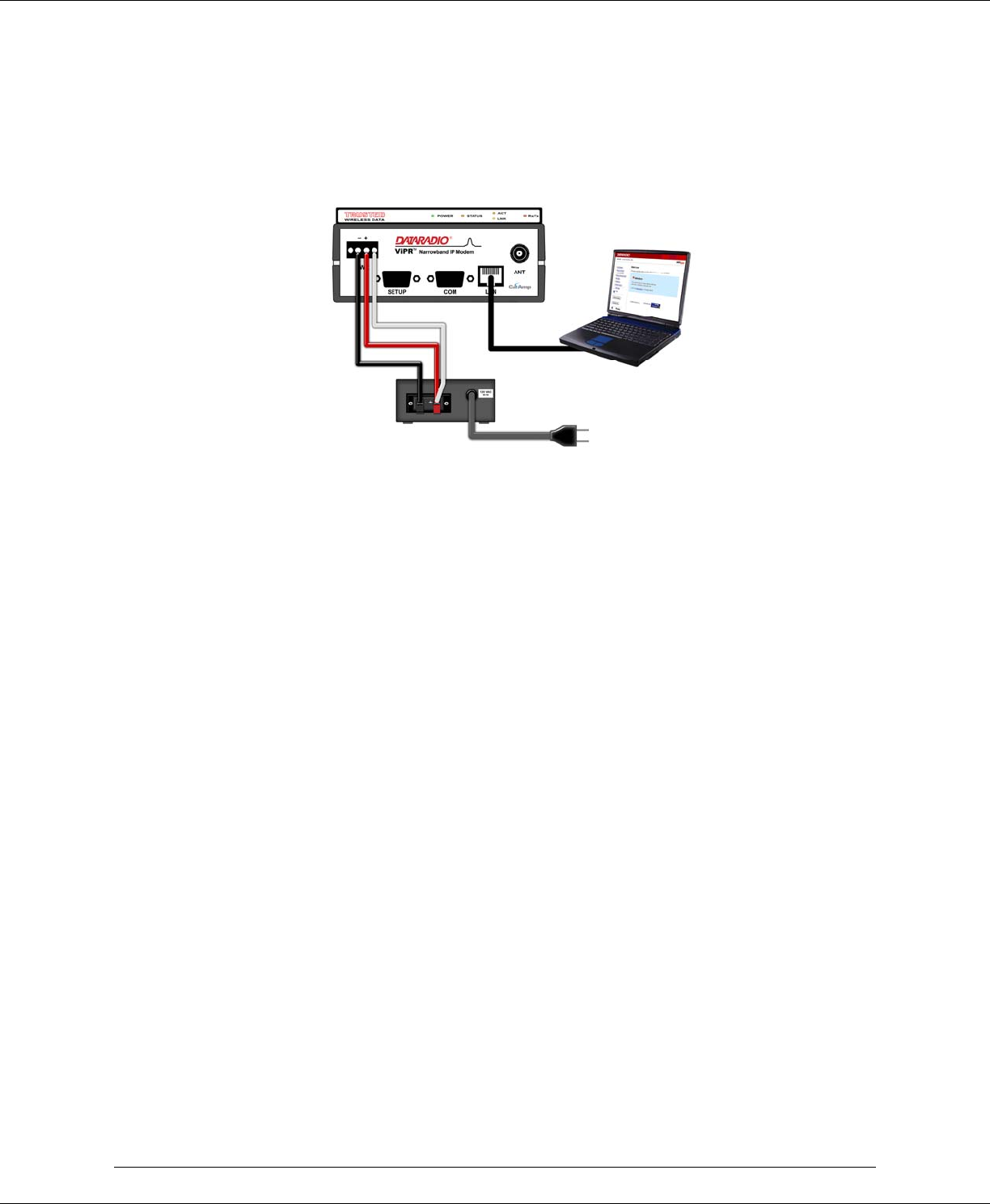
#9 ViPR User Manual_Rev2.doc Page 27
each unit.) Observe proper polarity when connecting the cables to the Power Supply. (White
wire must be connected to red wire.)
CONNECT VIPR TO PROGRAMMING PC
Connect a PC’s Ethernet port to the LAN port using a CAT 5 Ethernet cable. The LINK LED
should light.
Figure 3.6 Connect Power and Ethernet cable to the ViPR.
On your Internet browser address line, type the factory-default IP address: 192.168.205.1.
Press Enter to open the Network Password screen.
Initial Installation Login
For an initial installation, enter any User Name of 1 to 15 characters and the default
Password ADMINISTRATOR (upper case letters). Click OK. The web interface WELCOME
screen opens. Once setup is completed, change the ViPR login password (See Section 8.1).
CONFIGURE YOUR VIPR USING THE SETUP WIZARD
ViPR units are programmed using the web interface. Log into the ViPR web interface as
described in Initial Installation Login. Follow the instructions below to configure the ViPR
using the setup wizard. All units are factory programmed with an IP address of
192.168.205.1. Repeat these steps to program additional ViPR units.
STEP 1: Station Name: Assign a unique Station Name
IP Forwarding Mode: Select Bridge (Mode)
Relay Point: Select No
Access Point: Select No
Click “Apply” Click “Next”
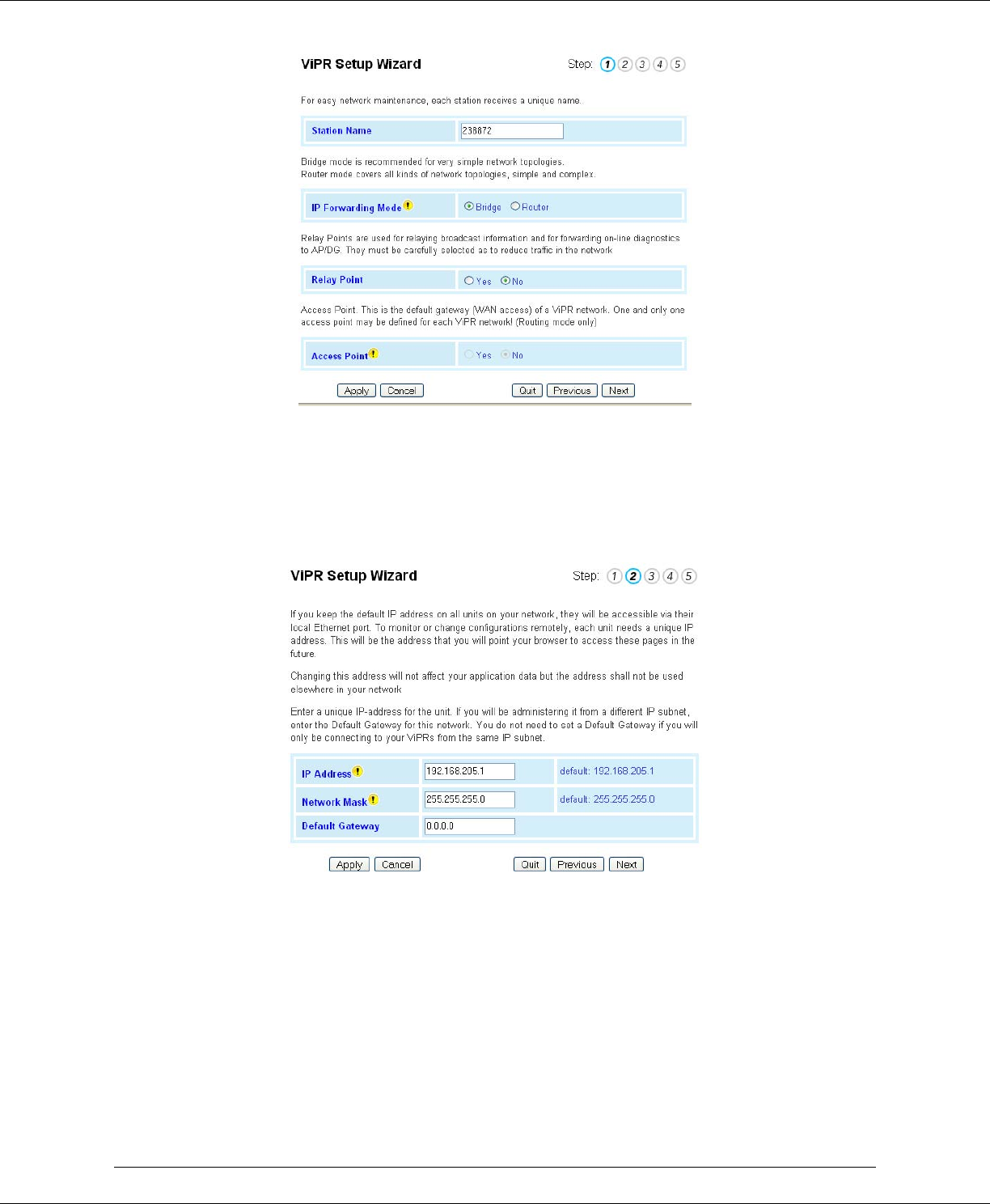
#9 ViPR User Manual_Rev2.doc Page 28
Figure 3.7 Using the Setup Wizard: Step 1
STEP 2: Each ViPR is programmed with these defaults:
IP Address: 192.168.205.1
Network Mask: 255.255.255.0
Default Gateway: 0.0.0.0
Figure 3.8 Using the Setup Wizard: Step 2
To monitor or change configuration remotely, each unit requires a unique IP
Address. When configuring more than one unit, be sure to increment IP addresses.
Click “Apply”. Click “Next”.
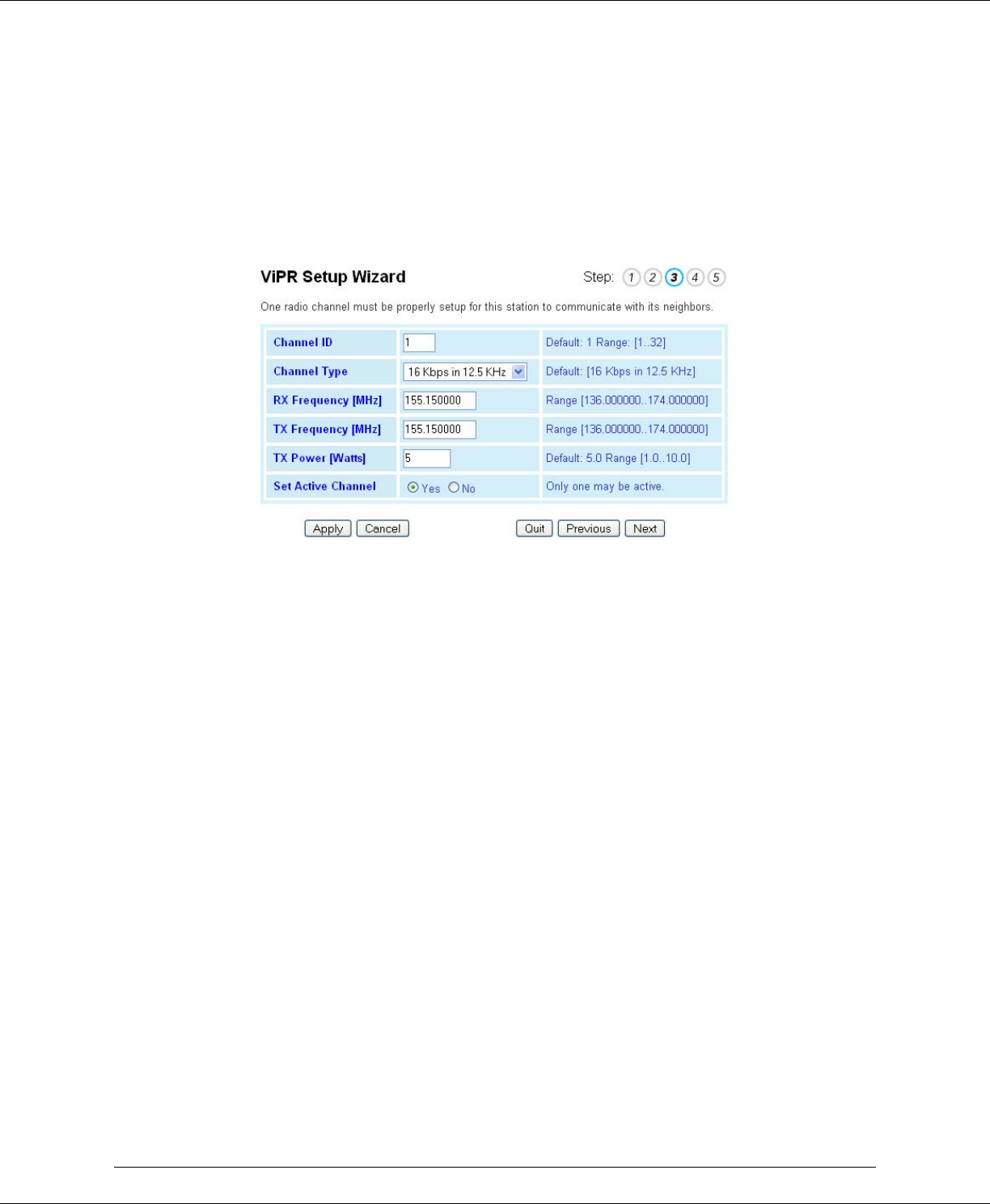
#9 ViPR User Manual_Rev2.doc Page 29
STEP 3: Verify FCC license before completing this step.
Channel ID: Enter 1 for Channel ID
Channel Type: Select Channel Type
RX Frequency: Enter RX Frequency
TX Frequency: Enter TX Frequency
TX Power: Enter 5 W
Set Active Channel: Select Yes
Click “Apply” Click “Next”
Figure 3.9 Using the Setup Wizard: Step 3
STEP 4: The ViPR uses AES-128 bit encryption to protect your data from
intrusion. Use of encryption is optional but we strongly recommend
it for network configuration. The encryption phrase/key must be common
to all units in a network.
Encryption Disabled
Encryption: Click Disabled
Click “Apply”. Click “Next”.
Encryption Enabled
Encryption: Click Enabled
Encryption Pass Phrase: Enter an encryption phrase
Note this phrase for reference later
Click “Apply”. Click “Next”.
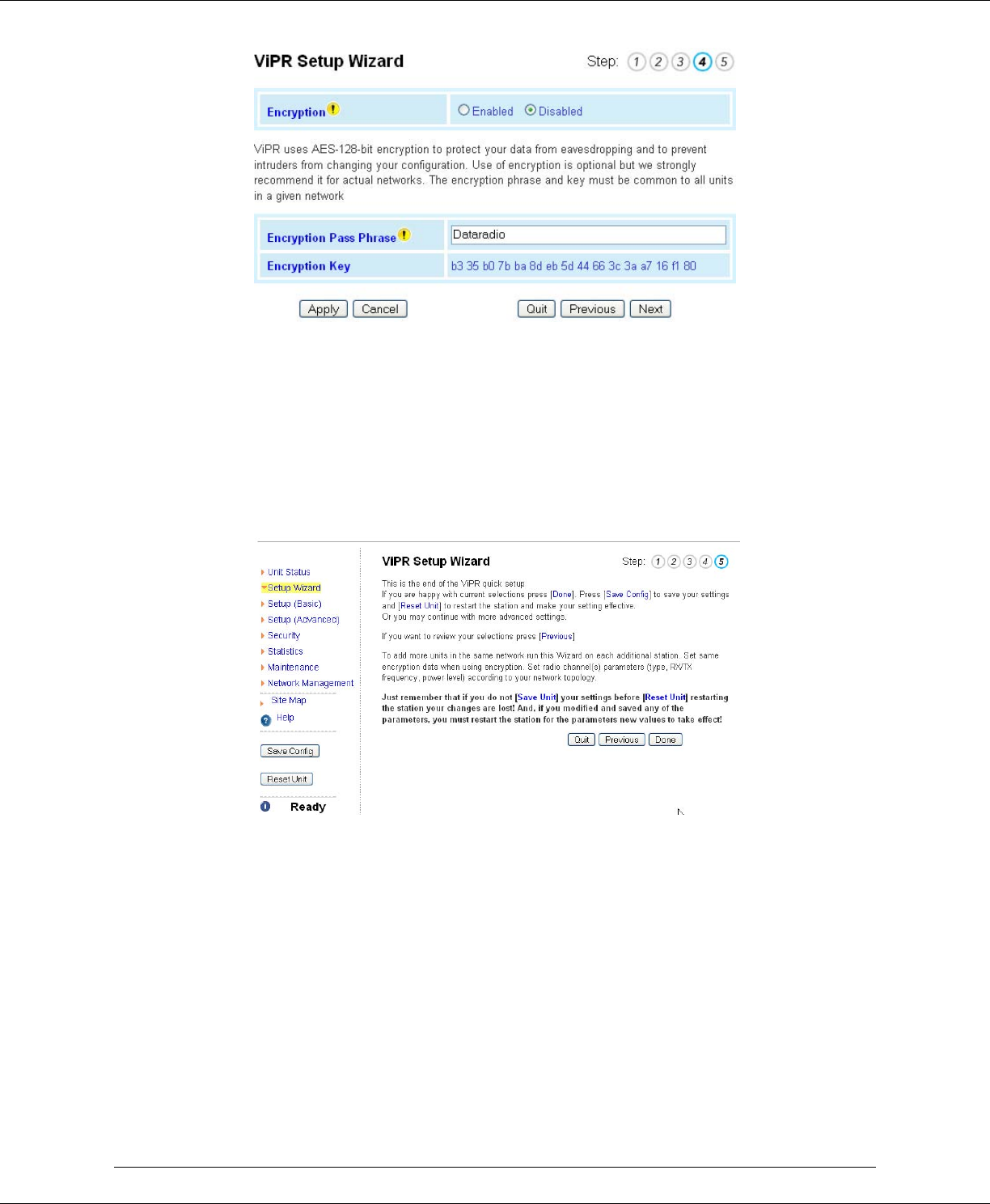
#9 ViPR User Manual_Rev2.doc Page 30
Figure 3.10 Using the Setup Wizard: Step 4
STEP 5: Click “Done” before completing the remaining steps.
Note: If the “Done” button is not clicked on new units, the units will not
transmit.
To save the network configuration parameters of your ViPR, click the
“Save Config” command button. You will see a green success icon on the
bottom left of the page when save is complete.
Figure 3.11 Using the Setup Wizard: Step 5
If you have changed any parameters marked with a yellow “!” icon, you must cycle power to
the unit using the “Reset Unit” button.
Your unit is now functioning in Bridge Mode.
CHECK FOR NORMAL OPERATION
To simulate data traffic over the radio network, connect a PC or LAN to the Ethernet port of
the ViPR and PING each unit in the network multiple times. Refer to section 10.1 to utilize
the ViPR PING utility.
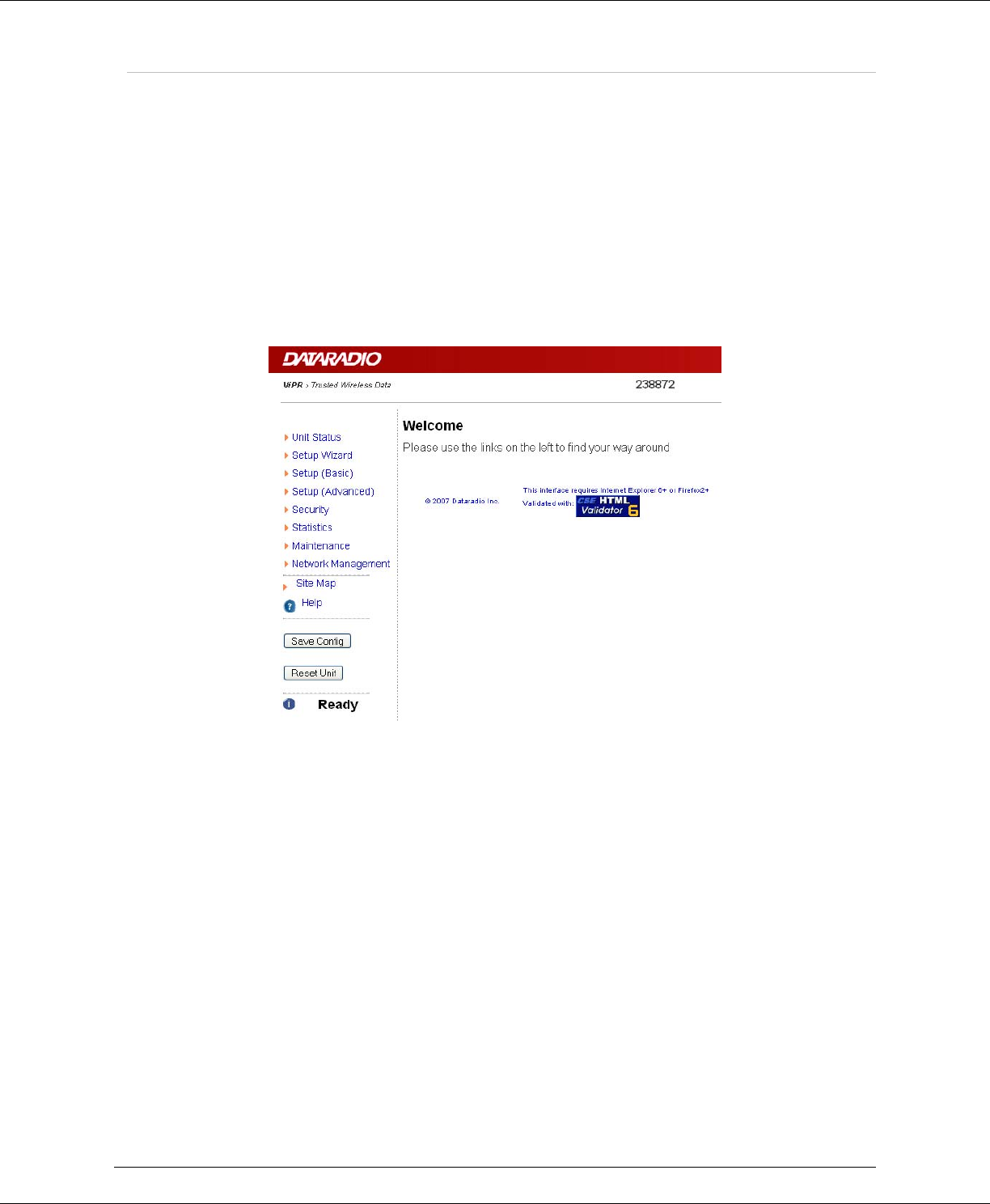
#9 ViPR User Manual_Rev2.doc Page 31
V
VI
IP
PR
R
W
WE
EB
B
M
MA
AN
NA
AG
GE
EM
ME
EN
NT
T
A built-in web server makes configuration and status monitoring possible from any browser-
equipped computer, either locally or remotely. Status, configuration, and online help are
available without requiring special client software. Setup is password-protected to avoid
tampering or unauthorized changes.
Both the configuration parameters and operating firmware can be updated remotely, even
over the RF network itself, using the standard FTP protocol.
NAVIGATING THE NETWORK MANAGEMENT SYSTEM
The Web Interface is subdivided in two frames: the left frame allows the user to navigate
the main menu, while the right main frame displays the selected page.
Figure 4.1 ViPR Welcome Screen
MAIN MENU
VIPR Main menu grants the user access to Unit Status, Setup Wizard, Basic and Advanced
Setup, Security, Statistics, Maintenance, and Network Management.
Network Management System Commands
The remaining buttons on the Navigator frame are used to save your configurations and
reset the unit.
Apply
This command button writes to RAM. When making an entry into a dialog box, click “Apply”
when you are satisfied with the changes to temporarily apply the value(s) entered to the
relevant parameter(s). Failure to use the “Apply” command button before leaving a
web page will result in the loss of entered selections, addresses, and values.

#9 ViPR User Manual_Rev2.doc Page 32
Cancel
The “Cancel” command only affects the dialog boxes or radio buttons in the opened window.
Save Config
This command button saves the ViPR parameters into flash memory. Failure to use this
command button will result in the loss of temporarily entered parameters when the unit is
reset.
Reset Unit
Once satisfied all parameters have been applied and saved, use the “Reset Unit” command
button to make flash changes permanent. When a unit is reset, a 20-second station reset
timer counts down. Status reports Ready when reset is complete.
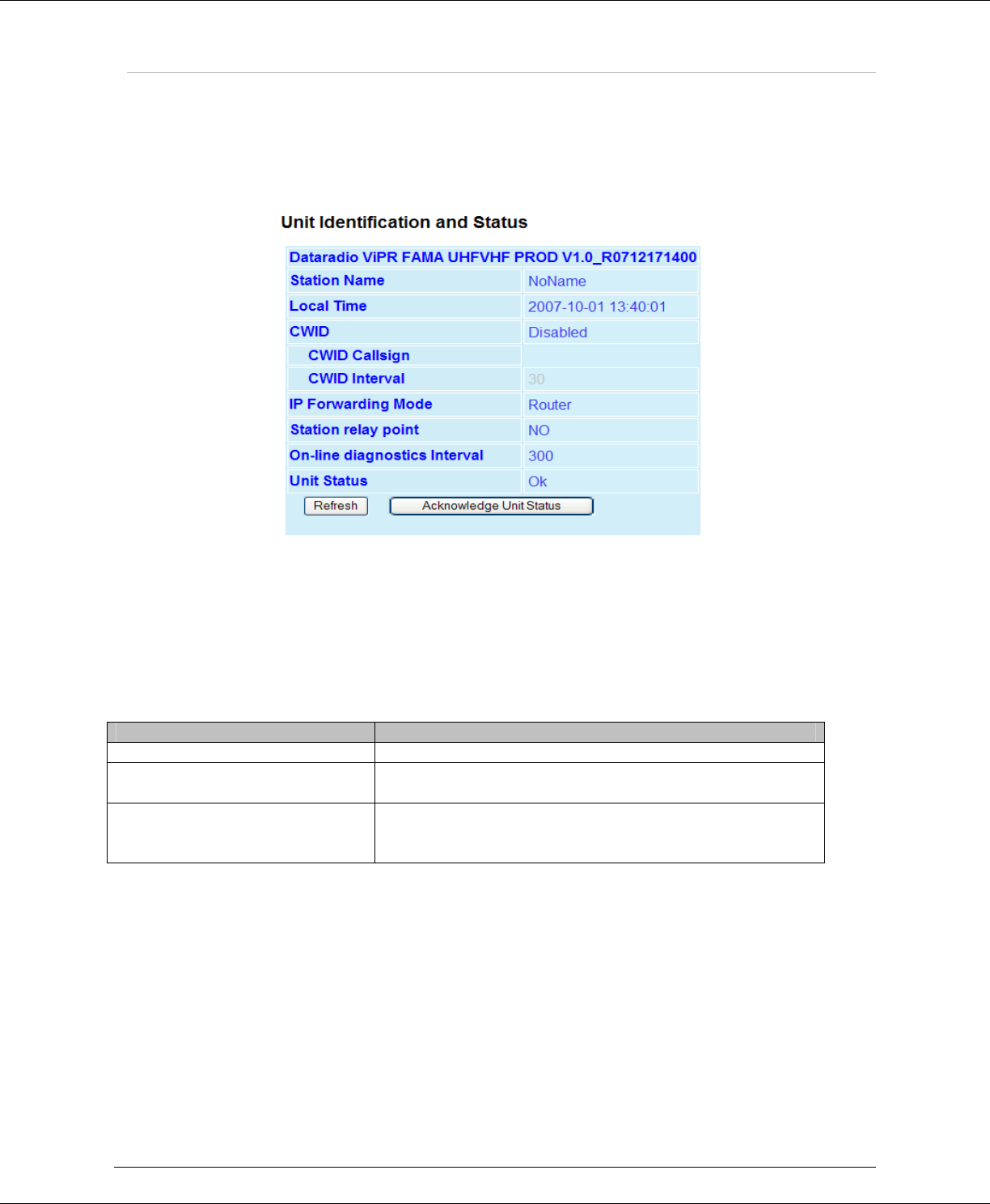
#9 ViPR User Manual_Rev2.doc Page 33
U
UN
NI
IT
T
S
ST
TA
AT
TU
US
S
The Unit Status windows display device General and Diagnostic information.
UNIT IDENTIFICATION AND STATUS
Figure 5.1 – Unit Status
D
General Web Page
Banner
The unit identification and status banner displays ViPR software revision information for the
ViPR device. Have this information available if contacting CalAmp support.
The banner should read: Dataradio ViPR FAMA UHFVHF PROD Vx.y_Rxxx, where:
Product Name ViPR
Protocol Name Licensed
Band(s) of Operation VHF 136-174 MHz, UHF 406.1-512 MHz, 900 928-
960 MHz
Production Build Vx.y Rxxx where
Vx.y is Major.minor version number, and
Rxxx is Sequential Package Release Build Number
Station Name
Displays the name of the connected unit. Configured under Setup (Basic) D General D
Station Name.
Local Time
Displays time zone configuration using UTC time and the configured Time Zone. An SNTP
server can be specified under Setup (Advanced) D Time Source. The time will reset to the
default setting if power is cycled on the ViPR unit and no SNTP server is configured.

#9 ViPR User Manual_Rev2.doc Page 34
CWID
Continuous Wave Identification - Default = Disabled
Allows the user to broadcast their FCC call sign.
CWID Call sign is the user's FCC call sign to be broadcast.
CWID Interval is the time interval in minutes that the call sign will be broadcasted.
CWID can be configured under Setup (Basic) D General.
IP Forwarding Mode
Displays IP forwarding mode (Bridge or Router). The IP Forwarding Mode can be configured
under Setup (Basic) D General D IP Forwarding Mode.
Station relay point
Displays if the unit is being used as a relay point (Yes or No). The Station Relay Point can be
configured under Setup (Basic) D General D Station relay point.
On-line diagnostics Interval
Displays the time interval in seconds when the On-line Diagnostics will be transmitted. This
interval can be configured under Setup (Basic) D General D On-line diagnostics interval.
Unit Status
Displays the status of the ViPR and reports any errors. If you do not receive the OK
indicator (EX. Error: Power On Self Test FAILURE, Warning: Radio TX Synthesizer lock
failure N/A), use the ACKNOWLEGDE UNIT STATUS and REFRESH buttons to reset the
modem. If the problem persists, contact CalAmp Technical Services for additional
information.
Have the displayed Unit Status message available if contacting CalAmp support. This
information is also required if returning a unit for service under RMA.
Refresh
Button will refresh the parameters on the current page.
Acknowledge Unit Status
This button allows the user to acknowledge and clear errors.
Errors remain stored, even after cycling power, to aid in troubleshooting intermittent faults.
Press the "Acknowledge Unit Status" button to return web page displays and Status LED
function to normal operation.
DIAGNOSTICS
ViPR units continually monitor and report on their environmental and operating conditions.
Local Diagnostics
Local Diagnostics can be accessed by loading the Unit Status D Diagnostics web page from
the ViPR.
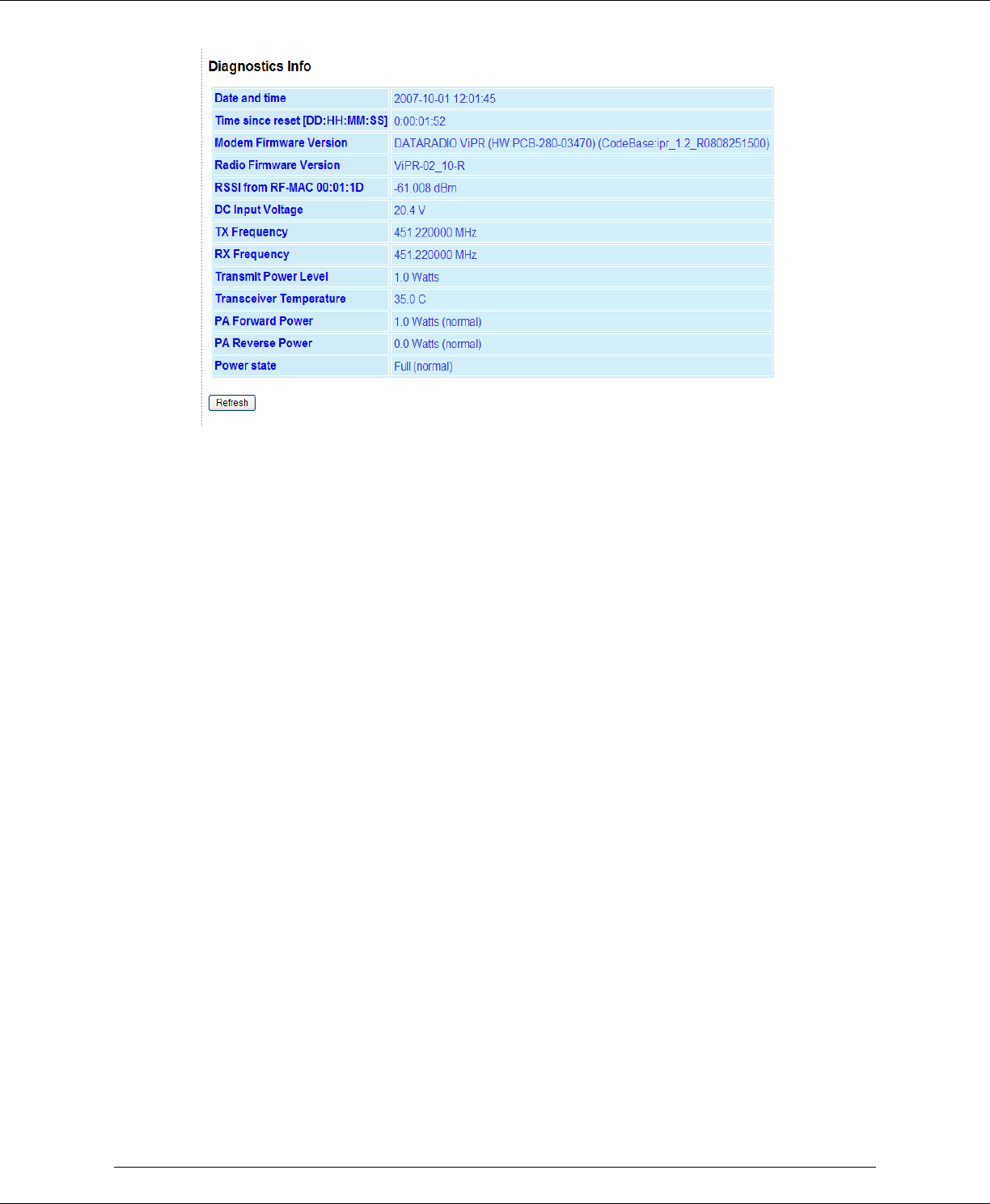
#9 ViPR User Manual_Rev2.doc Page 35
Figure 5.2 – Unit Status
D
Diagnostics Web Page
Date and time
Displays the time and date. To set the time, an SNTP server must be setup under Setup
(Advanced) D Time Source. The SNTP server must also be accessible via the user’s LAN or
Internet connection.
Time since reset
Displays the amount of time since the unit was last reset. [DD,HH,MM,SS], Days, Hours,
Minutes, Seconds
Modem Firmware Version
Displays the modem firmware version of the unit.
Radio Firmware Version
Displays the radio firmware version of the unit.
RSSI from RF-MAC
Displays the Received Signal Strength Indication (RSSI) from the unit with the MAC address
displayed. The RSSI displayed range is from approximately -50 dBm to
-120 dBm. At signal strengths greater than -50 dBm, the radio will still operate but will not
display an accurate RSSI value.
DC Input Voltage
Displays the DC Input Voltage for the unit.
TX Frequency
Displays the current operating transmit frequency for the active channel. Setup (Basic) D
Channel Table D TX

#9 ViPR User Manual_Rev2.doc Page 36
RX Frequency
Displays the current operating receiver frequency for the active channel. Setup (Basic) D
Channel Table D RX
Transmit Power Level
Displays the programmed power level for the active channel. Setup (Basic) D Channel
Table D PA Power
Transceiver Temperature
Displays the transceiver’s internal temperature in Celsius or Fahrenheit. Setup (Advanced)
D User Settings
PA Forward Power
Displays the actual measured forward power of the transmitter. If the measured forward
power drops 1 dB or more below the user configured power level, this line will report
“(fault)”. When the forward power is within range, this line will report “(normal)”. The ViPR
radio can be configured to send an SNMP trap (or alarm) if the Forward Power goes into a
“fault” state.
PA Reverse Power
Displays the actual measured reverse power of the transmitter. If the measured reverse
power increases to within 3 dB of the user configured power level, this line will report
“(fault)”. When the reverse power is within range, this line will report “(normal)”. The ViPR
radio can be configured to send an SNMP trap if the Reverse Power goes into a “fault” state.
Power state
Indicates if the unit is running at full power or at a reduced power. The TX power will
foldback when the temperature is too hot or the Power Amp (PA) current is too high. In
extreme cases of high temperature or high current, the ViPR transmitter will shutdown
completely to protect the radio from permanent damage.
When the ViPR is at Full power this line will report “(normal”). If the ViPR’s PA goes into
Foldback or Shutdown this line will report “(fault)”. The ViPR radio can be configured to
send an SNMP trap if the Power State reports a fault.
Refresh
This button will refresh the current page's parameters.
Online Diagnostics
Transmission of online diagnostics may be enabled or disabled at any station or stations
without affecting their ability to communicate with other stations. Online Diagnostics can be
sent anywhere, including being back-hauled. Back hauling adds to the network traffic flow
and must be taken into account when designing a network. If a return flow is necessary, it
needs to be reduced substantially to have a minimal effect on the network.
ViPR can support up to 4 diagnostics socket connections at once. This may be used, for
instance, to carry out monitoring at a main office and at up to three separate field locations.

#9 ViPR User Manual_Rev2.doc Page 37
It is also possible one of the four connections use a serial port instead by enabling it on the
ViPR’s web browser interface.
Output Format
The online diagnostic output is man/machine readable, ASCII, comma-delimited format. Any
reader program used (or written) must decode the VERSION FIELD and check for type 1 as
more types may be released in the future.
From a Command Prompt window, type telnet nnn.nnn.nnn.nnn 6272 and the unit’s online
diagnostic output will display on the screen (where nnn.nnn.nnn.nnn is your unit’s IP
address in dot decimal format). Note: no overhead is generated in the ViPR unit if no online
diagnostic connection is actually made.
Figure 5.3 – Diagnostic output sample
Table 5.1 – Online Diagnostics Output Sample Definitions
Host MAC address of the station where diagnostic measurements are being collected.
The host will collect diagnostic message from itself and all remote units with IPSD
enabled. IPSD can be enabled/disabled under Setup (Advanced) D IP Services.
Ver Version of the online diagnostics. Different versions may have different
parameters. This document describes Version 1.
# Number of items that follow in the online diagnostic message.
Period PERIOD (Seconds). Specifies the time between the generation of online diagnostic
messages from the source station.
Flags Online Diagnostic Flags. (CalAmp specific)
Source
Source Address. In Bridge mode, this address displays the MAC address of the
source ViPR. In Router mode, this address displays the IP Address of the source
ViPR. The source is the ViPR station generating the diagnostic message. This is
also the source station from the point of view of the RSSI measurements
Destination
Destination Address. In Bridge Mode, this address displays the MAC address of the
destination ViPR. In Router Mode, this address displays the IP Address of the
destination ViPR. This is the destination station from the point of view of RSSI
measurements.
A Temperature of the source ViPR in Celsius or Fahrenheit. Temperature units can
be configured on the source ViPR under Setup (Advanced) User D Settings.
B
Source supply voltage in excess of 8 volts, shown in 10ths of volts.
Supply voltage = (ODM_reading / 10) + 8
A reading of 35 shall be interpreted as 11.5V.

#9 ViPR User Manual_Rev2.doc Page 38
C RSSI measured at the source ViPR for the last message received from the
destination ViPR. This is also referred to as the Local RSSI. The value displayed
shall be interpreted as shown in Table 5.2.
D RSSI measured at the destination ViPR for the last message received from the
source ViPR. This is also referred to as the Remote RSSI. The value displayed
shall be interpreted as shown in Table 5.2.
E Radio/antenna forward power measured in 10ths of watts at the source ViPR. A
value of 51 shall be interpreted as 5.1W.
F Radio/antenna reverse power measured in 10ths of watts at the source ViPR. A
value of 2 shall be interpreted as 0.2W.
G
PER measured at the source. This is calculated as the percentage of packets
rejected due to an invalid header/checksum over the total number of packets
received. To fit a small unsigned integer, this value is multiplied by 1000 and its
max value limited at 255. A reading of 2 means 0.002% of packets were rejected.
Table 5.2 – Online Diagnostics RSSI Display
VALUE RSSI NOTES
0 NA The RSSI Value is not Available
1 > -60.25 dBm The RSSI Value is greater than –60.25 dBm
20 -65.00 dBm
255 < -123.75 dBm RSSI is less than –123.75 dBm
X RSSI = -60 – (X * 0.25), for X not equal to 0
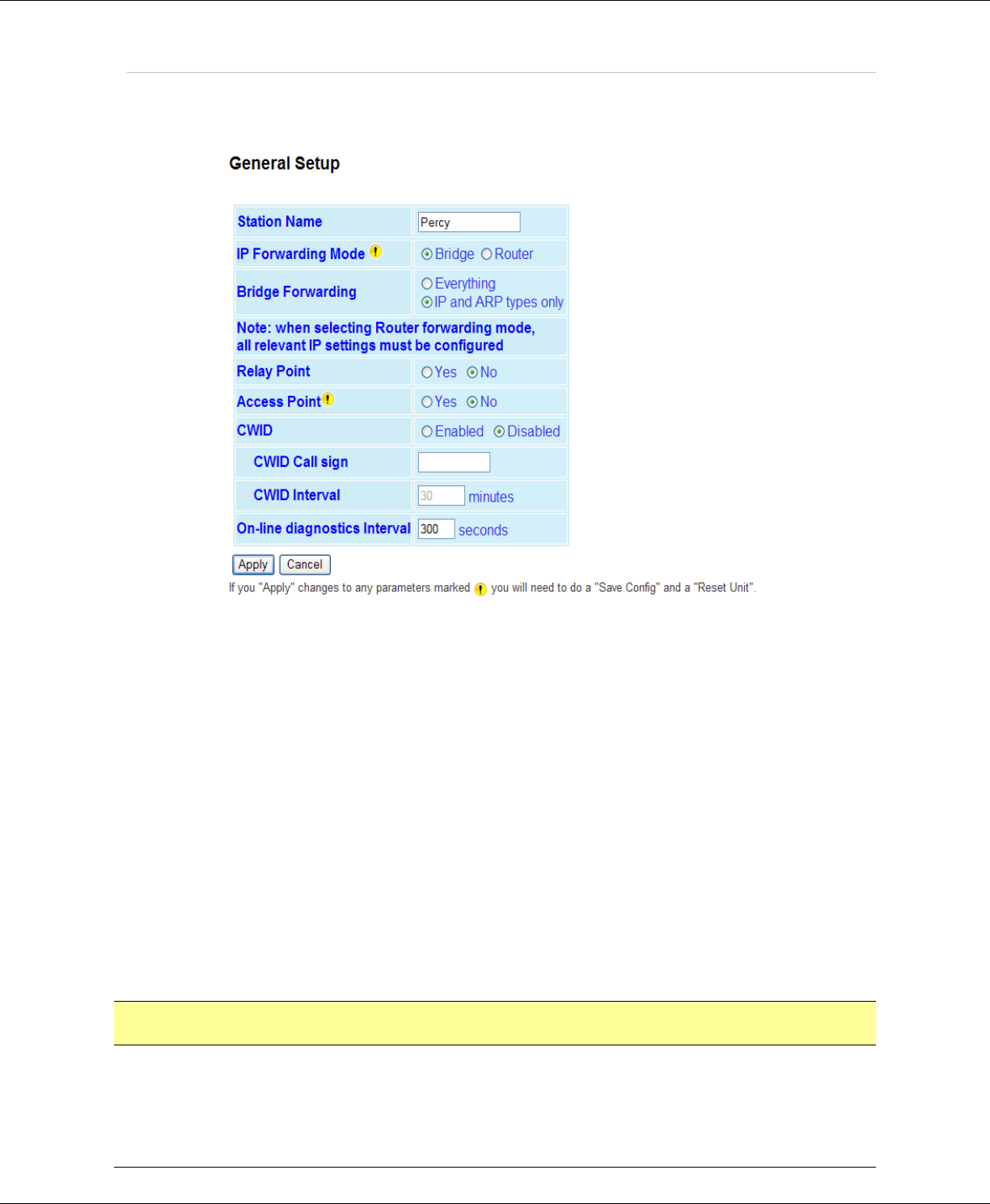
#9 ViPR User Manual_Rev2.doc Page 39
SETUP (BASIC)
GENERAL SETUP
Figure 6.1 Setup (Basic)
Station Name
Station name identifier – Enter a string up to forty characters in length.
IP Forwarding Mode
Bridge / Router, Default = Bridge mode
Bridge Mode: Bridge mode is the simplest configuration for the ViPR radio and should only
be used for small networks. In Bridge mode, all the ViPRs and all the Hosts/PCs connected
to the ViPRs must be on the same IP subnet. Figure 6.2 illustrates ViPR bridge mode
configuration. Ethernet messages are sent over the air as broadcast messages. All the
other ViPRs in the network will receive the message and relay it to their local area network.
If the Com Ports are configured for Serial/RF Bridge mode on all the ViPRs in the network,
then each message that is transmitted into one ViPR’s Com Port will be received by all the
other ViPRs in the network and transmitted out their Com Ports.
Note: This configuration can be substituted for a traditional serial RS232 radio system
configuration. The ViPR in bridge mode is a drop in replacement for a serial radio.
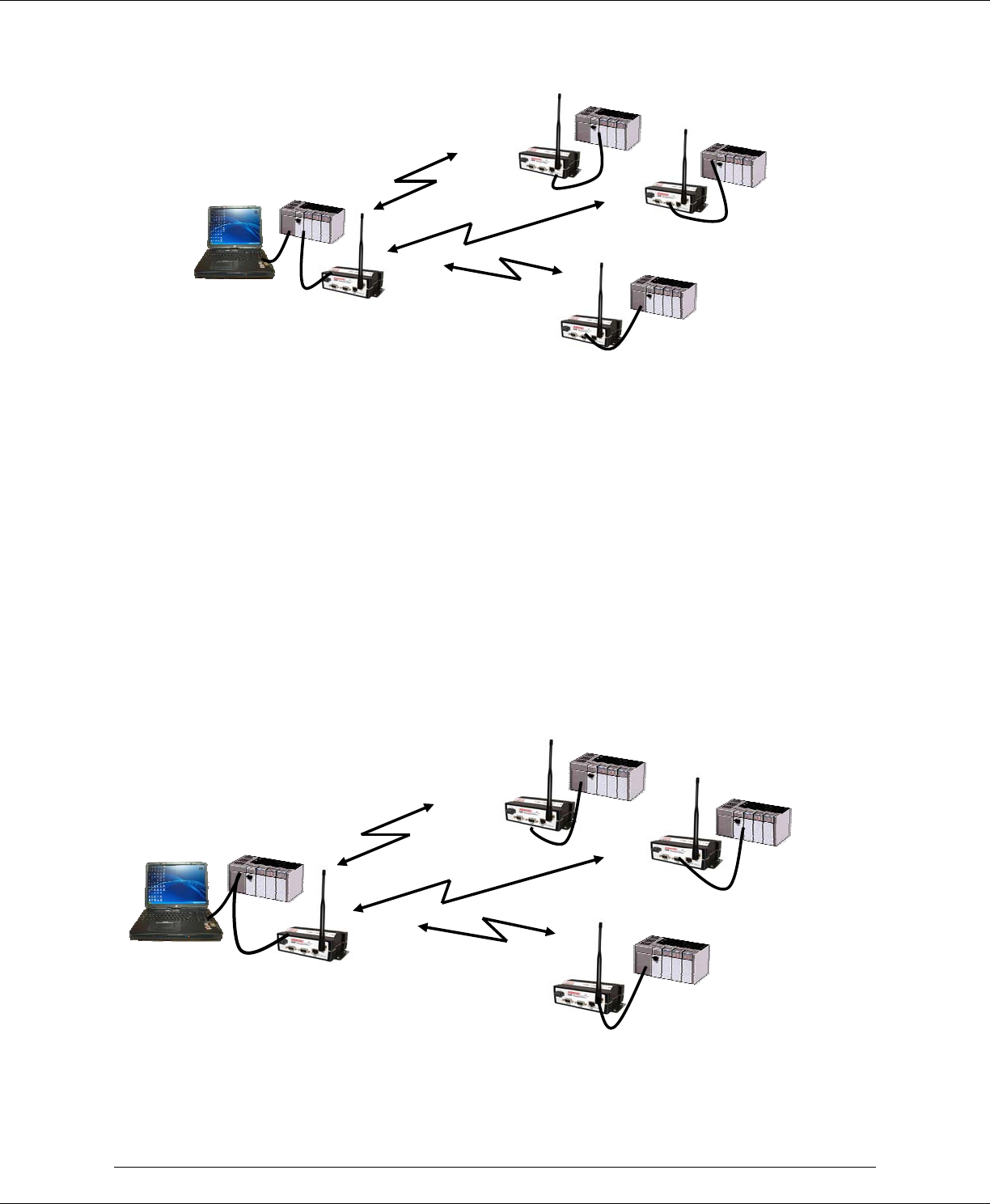
#9 ViPR User Manual_Rev2.doc Page 40
Figure 6.2 ViPR Bridge Mode Configuration.
Router Mode: Router mode offers several advantages over Bridge mode and can be used
for simple or complex networks. In Router mode, each ViPR must be configured for a
unique IP subnet. Figure 6.3 represents a ViPR router mode configuration. Ethernet
messages will be routed to the intended recipient ViPR and will be discarded by other ViPRs
that overhear the message that was not intended for them. The user can specify the route
a multiple hop message will travel and thus can channel the traffic throughout the ViPR
network to give a more reliable connection or perhaps relieve traffic congestion on a large
network. In Router mode, the user has access to the RSSI for each ViPR that is one hop
away. In Router mode, several retry mechanisms can be enabled which often yields a more
stable and reliable link. (See section 12, Network Optimization, for more details.) Also, the
user will have access to more advanced IP configuration settings such as Network Address
Translation (NAT).
Figure 6.3 ViPR Router Mode Configuration
ViPR
192.168.205.1
ViPR
192.168.205.3
PLC
192.168.205.4
HMI/PLC
192.168.205.10
HMI/PLC
192.168.205.10
PLC
192.168.205.30
PLC
192.168.205.20
ViPR
192.168.205.2
ViPR
192.168.205.4
Bridge Mode
Subnet 192.168.205.0
ViPR
192.168.205.1
ViPR
192.168.207.1
ViPR
192.168.208.1
PLC
192.168.208.2
HMI/PLC
192.168.205.2
HMI/PLC
192.168.205.100
PLC
192.168.207.2
PLC
192.168.206.2
ViPR
192.168.206.1
Router Mode, Different Subnets
192.168.205.0, 192.168.206.0,
192.168.207.0, 192.168.208.0

#9 ViPR User Manual_Rev2.doc Page 41
Bridge Forwarding
Everything / IP and ARP types only
By default, the ViPR only forwards IP and ARP packets (Ethernet II types: 0x0800, 0x0806).
By selecting the "Everything" setting, the ViPR will forward all 802.3 Ethernet II packet
types. Use this setting to transport protocols such as IPX, 802.1Q, etc. Note that this option
is not available in Router mode because the ViPR will automatically forward all packets per
its routing table.
Relay Point
Yes/No (default)
For units that are spread over multiple RF coverage areas, the user needs to identify the
ones that will form the backbone between the coverage areas so that any unit can talk to
any other unit in the network regardless of their locations. These units are called Relay
Point units. A Relay Point provides store and forward repeating for all traffic in Bridge mode
and for broadcast packets in Router mode. Selecting this parameter will force the unit to
repeat all necessary information from one coverage area to the next. Multiple Relay Points
can be configured in parallel to provide redundancy in the network; however, having
redundant relay points may slow the flow of traffic.
Access Point
Yes/No (default)
This is the default gateway (WAN access) of a ViPR network. One, and only one, access
point may be defined for each ViPR network. All ViPRs in the network will set their default
route to point towards the Access Point. (An Access Point can only be configured in Router
mode.)
CWID
Enabled/Disabled (default).
Enabling CWID allows the unit to broadcast the FCC Call Sign in Morse code at a certain
interval.
CWID Call sign is the FCC Call sign to be broadcast.
CWID Interval is the time interval after which the call sign will be broadcast.
On-line diagnostics Interval
The on-line diagnostic interval is the time interval in which the unit will broadcast the
diagnostic string. Please refer to section 5.2.2 for detailed information about the format of
the diagnostic string.
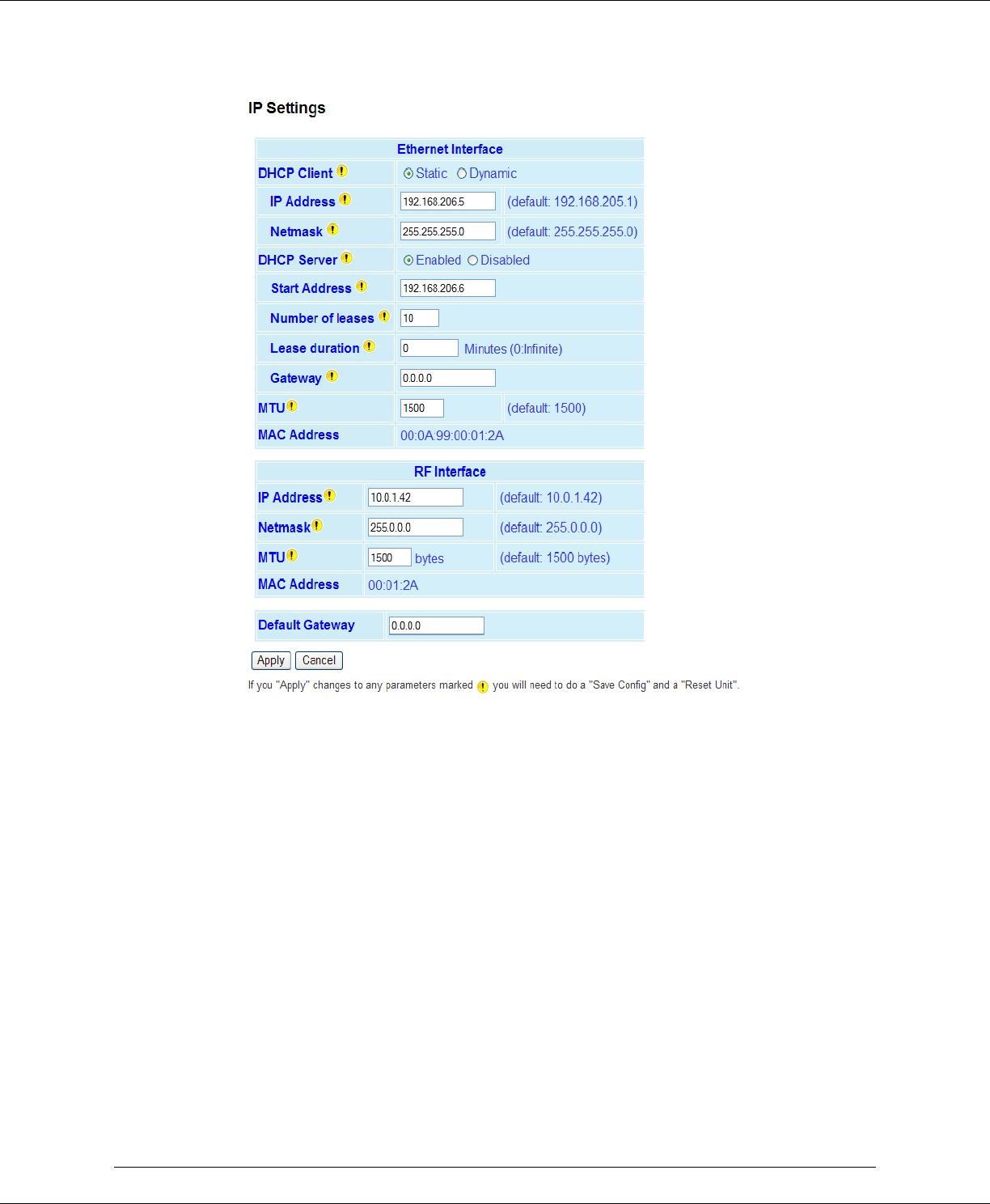
#9 ViPR User Manual_Rev2.doc Page 42
IP SETTINGS
Figure 6.4 – Setup (Basic)
D
IP Settings Web Page
Ethernet Interface
DHCP Client
DHCP Client: Static (default) or Dynamic. When the unit is in Router mode, Static mode
allows the user to set the IP address of the unit. Dynamic mode will set the unit to be a
DHCP client, which will allow the unit to accept an IP address from an external DHCP server.
When the unit is configured for Bridge mode, the Dynamic option is disabled and the user
must enter in a specific IP Address.
NOTE: Activating this option will reset the IP address of the unit. If your network supports
the DHCP Server capability, make sure the IP address assigned by the DHCP server will be
accessible to you. If your network does not support DHCP server capability, the unit will be
reset to the default (192.168.205.1) IP address within the first 2 minutes.
To activate, select the "DHCP Client” radio button, click on the "Apply" button, click on the
"Save Config" button, and reboot the ViPR.

#9 ViPR User Manual_Rev2.doc Page 43
IP Address
Set to a valid unique IP address for each individual unit (default: 192.168.205.1). In Bridge
mode, all the ViPRs must be configured for the same IP subnet. In Router mode, each ViPR
must be configured for a unique subnet.
Netmask
Set to a valid IP Netmask for each individual unit (depends on customer's IP network
topology, default: 255.255.255.0).
DHCP Server
DHCP Server Disabled, Enabled (Default). The Dynamic Host Configuration Protocol provides
a framework for passing configuration information.
E.g.: Assigns IP address to Hosts (i.e. PC/RTU) on a TCP/IP network.
Start Address
Pool of addresses allocated for DHCP purpose. If a unit is configured as a DHCP Server, this
field represents the start IP address pool managed by the DHCP Server. Normally, ViPR
automatically calculates the Lease Start Address (equal to Ethernet IP Address plus one).
Number of Leases
Maximum number of DHCP client(s) a unit can serve.
Lease Duration
The period over which the IP Address allocated to a DHCP client is referred to as a "lease".
Lease Duration is the amount entered in minutes. If 0 (zero) is entered, the lease will not
expire.
Gateway
The Gateway text box displays the IP address of the gateway assigned by the DHCP server.
In Router mode, the default (preset) gateway is the IP address of the unit itself. In Bridge
mode, the default (preset) gateway is 0.0.0.0. To override the default setting, enter a valid
IP address in the text field.
MTU
Maximum Transfer Unit - Default = 1500 bytes. The MTU is the maximum number of bytes
the unit will send in a packet. The input range is from 576 to 1500.
MAC Address
The MAC address (media access control) is the unique address that a manufacturer assigns
to each networking device. AA:BB:CC:DD:EE:FF
RF Interface
IP Address
The RF IP address (default: assigned by factory based on the unit's MAC address) is the RF
IP address that is used when sending data and control packets in a ViPR network.
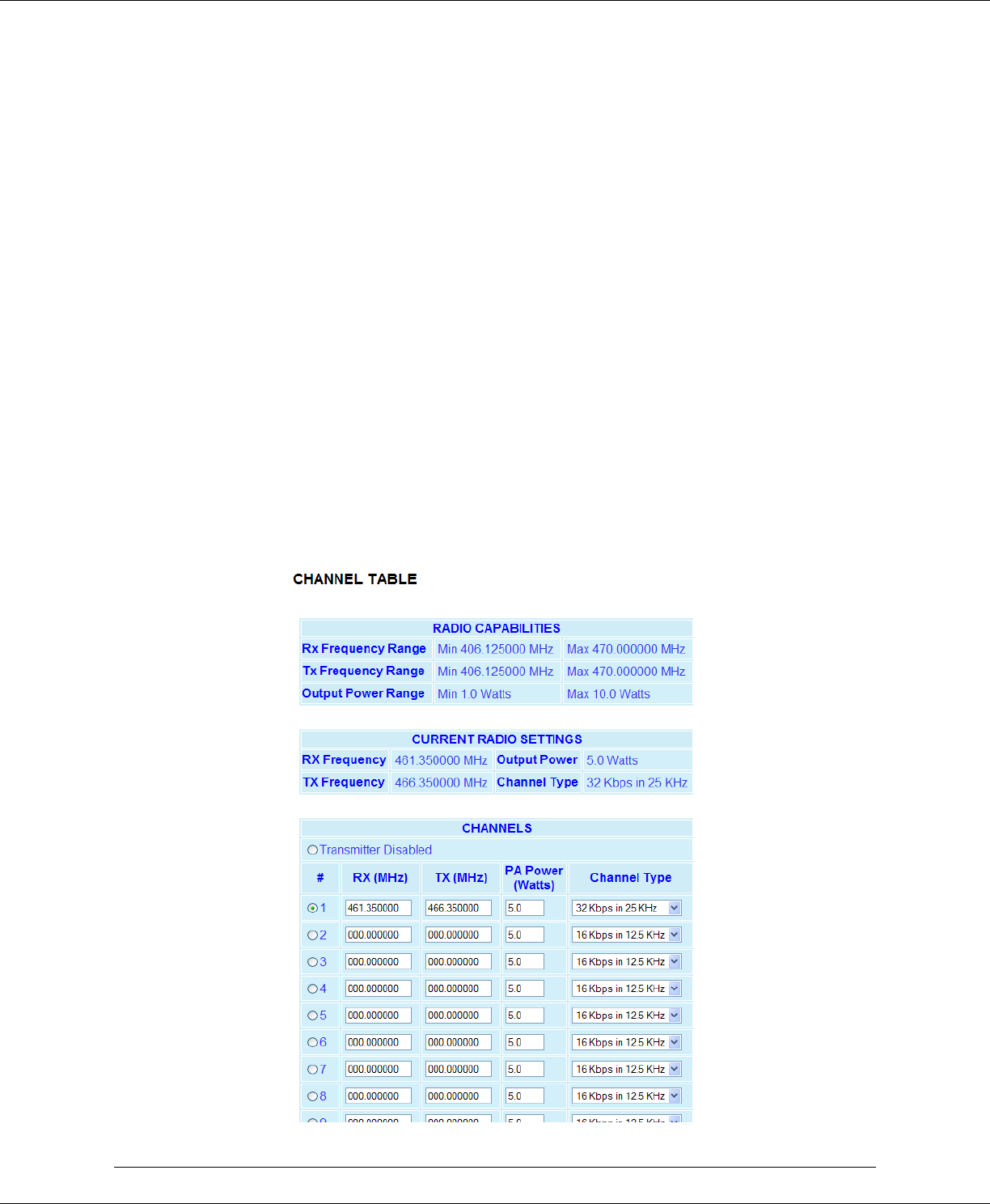
#9 ViPR User Manual_Rev2.doc Page 44
Netmask
The Netmask (default: 255.0.0.0) is set to a valid common RF IP Netmask for all units in a
ViPR network.
MTU
Maximum Transfer Unit - Default = 1500 bytes. The Maximum transfer unit is the
maximum number of bytes the unit will send in a packet. The input range is from 576 to
1500.
MAC
RF MAC Address, assigned by the factory. This cannot be changed.
Default Gateway
The Default Gateway (default: 0.0.0.0) allows the user to enter in the IP address of the
access point to be used as the gateway to the management network. If there is one ViPR
configured as an Access Point in the network, all the other ViPRs will set their Default
Gateway equal to the RF IP address of the Access Point.
CHANNEL TABLE
The Channel Table will display the Transmit Frequency, Receive Frequency, Transmit Power,
and Channel Type for each channel in the unit.
Figure 6.5 – Setup (Basic)
D
Channel Table Web Page

#9 ViPR User Manual_Rev2.doc Page 45
Radio Capabilities
Tx & Rx Frequency Range and Output Power Range is factory set.
140-5018-500/501: VHF, 136.000-174.000 MHz, 1-10W
140-5048-300/301: UHF Range 3, 406.125-470.000 MHz, 1-10W
140-5048-500/501: UHF Range 5, 450.000-511.975 MHz, 1-10W
140-5098-500/501: 900, 928.000-960.000 MHz, 1-8W
Current Radio Settings
Displays the current Rx & Tx Frequencies, Output Power, and Channel Type programmed
into the radio.
Channels
Transmitter Disabled radio button is set at the factory to disable the radio until a valid
frequency has been entered. The radio will not transmit until a valid frequency has been
entered and the transmitter has been enabled.
There are 32 channels available in the ViPR. The radio button beside each channel will
select that channel as the active channel. Each channel can operate in simplex (one
frequency) or half duplex (pair of frequencies) mode. The transmit power output level can
be set for each channel. The channel type can be selected for each channel. All ViPRs in a
network must be set to the same channel type.
Note: It is the installer’s responsibility to check the FCC license to determine the correct
parameters and settings for channel frequencies, power level, and channel type.
SERIAL PORTS SETUP
The ViPR has two serial ports. Either port can be configured to send data over the air,
connect to the CLI (command line interface), report online diagnostics, or be custom
configured to send/receive data on a specific port to/from a specific IP address.
By default the Setup port is configured to connect to the CLI at 19200 baud. The Com port
is configured to send data in DOX mode at 9600 baud. By default the Com port will send
data as a UDP multicast message to all the other ViPRs on the network (10.255.255.255) on
port 6278. When DOX mode is selected on the Setup port, the Setup port will send data as
a UDP multicast message to all the other ViPRs on the network on port 6277. If other
configurations are needed, the ViPR allows for custom configuration of the transport
protocol, IP Addresses, and ports the Setup port and Com port will connect with.
The serial custom configuration will allow the user to program the serial port as a terminal
server. A terminal server will translate the serial protocol to an Internet Protocol (IP). A
terminal server will wrap serial data presented at the serial port in an IP package (IP header
and associated checksums). When an IP message is sent to the terminal server’s
corresponding IP address, the IP package is stripped off.
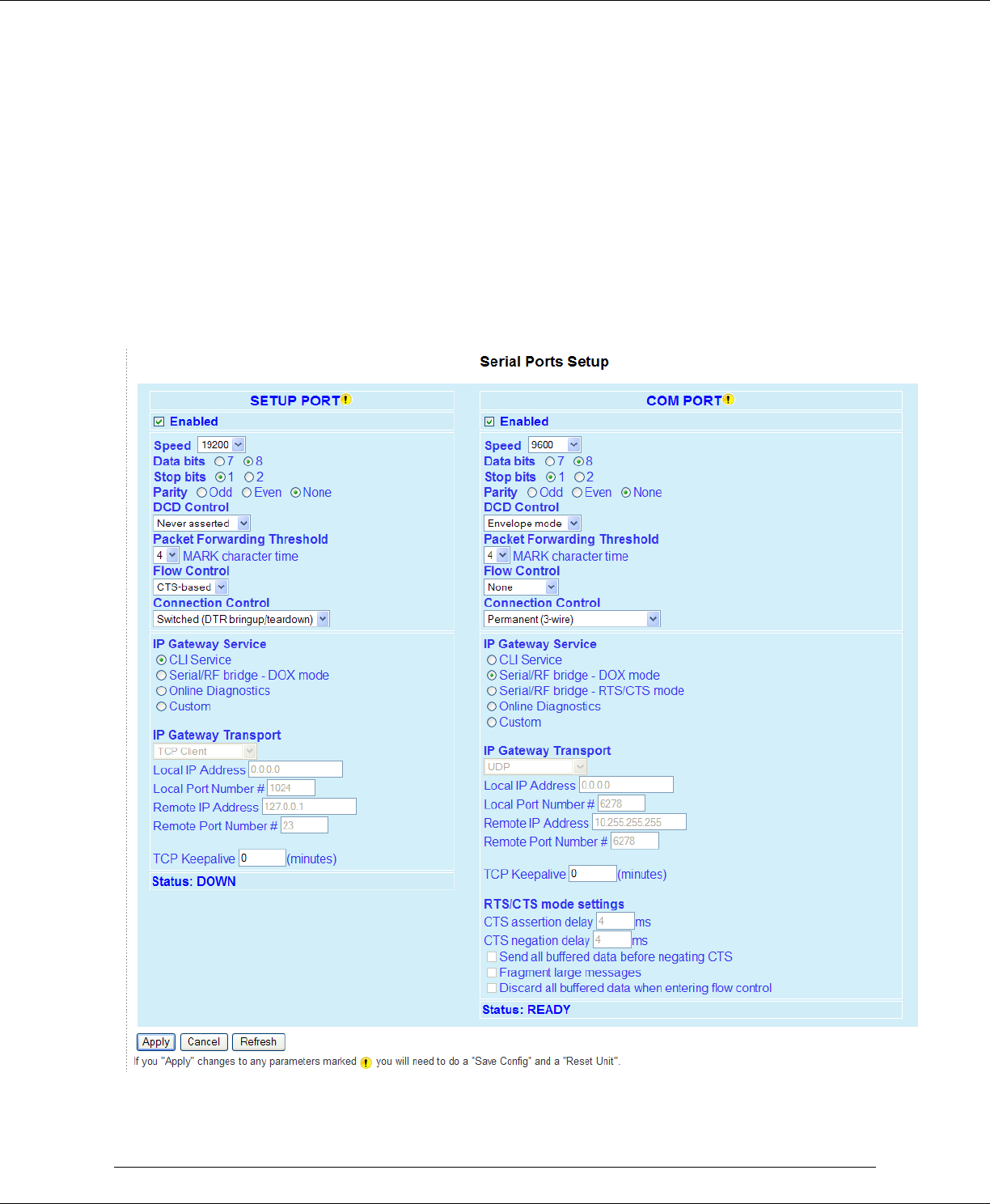
#9 ViPR User Manual_Rev2.doc Page 46
A terminal server will not translate HMI/PLC polling message protocols that are not designed
to be wrapped in an IP package. Most SCADA protocols are not designed to be used with a
terminal server. As an example, the Modbus RTU message is a serial protocol. The Modbus
TCP/IP protocol is an Ethernet IP protocol. The Modbus RTU message cannot be wrapped in
an IP package to form a Modbus TCP/IP polling message. A protocol translation must take
place. A device can be purchased that will perform the translation. Please contact your local
SCADA dealer or CalAmp Tech Support to determine if your SCADA protocol can be used
with a terminal server.
After any settings on this page are updated, press the "Apply" button. Wait for the page to
reload then press the "Save Config" button then the "Reset Unit" button to update the
changed serial port settings.
Figure 6.6 – Setup (Basic)
D
Serial Ports Web Page

#9 ViPR User Manual_Rev2.doc Page 47
Basic Settings
Enabled Checkbox
There are independent check boxes to activate SETUP PORT and/or COM PORT.
Speed
The Setup port can be configured for 300, 1200, 2400, 4800, 9600, or 19200 Baud Rate.
The Com port can be configured for 300, 1200, 2400, 4800, 9600, 19200, 38400, 57600, or
115200 Baud Rate.
The default is 19200 for the SETUP port and 9600 for the COM port. The Baud Rate should
be configured to match the settings of the connected device.
Data bits
Number of bits making up the data word. The default is 8. This should be configured to
match the settings of the connected device.
Stop bits
Marks the end of the serial port data byte. The default is 1. This should be configured to
match the settings of the connected device.
Parity
Added to identify the sum of bits as odd or even. The default is none. This should be
configured to match the settings of the connected device.
DCD Control
The DCD (Data Carrier Detect) line can be set for one of the following: Always Asserted,
Never Asserted, or Envelope Mode (the DCD will be asserted only when data is present at
the serial port).
Packet Forwarding Threshold
Mark Character time allows the user to change time based on the character length to
forward the packet.
Flow Control
Allows the user to implement RTS/CTS flow control or no flow control. Note: Request to
Send and Clear to Send flow control will require a 5 wire connection to the Setup Port or
Com Port.
Connection Control
Select "Permanent (3-wire)" when the serial port is always enabled or "Switched (DTR
bringup/teardown)” when DTR is used to enable/disable the serial connection. This should
be configured to match the settings of the connected device.
IP Gateway Service
The serial ports can be configured to provide several different services as listed below.

#9 ViPR User Manual_Rev2.doc Page 48
CLI Service
Command Line Interface
Access to the Command Line Interface command shell is password protected and is
reserved for authorized Dataradio maintenance personnel.
Serial/RF Bridge - DOX mode
3 wire connection required. Data is sent whenever it is present at the port. Flow control is
not required. The IP Gateway service will use UDP transport protocol to send and receive
messages.
Serial/RF Bridge - RTS/CTS mode
5 wire connection required. Data is sent after the device raises the RTS and the ViPR
returns a CTS signal to the device.
Online Diagnostics
TCP/IP based RF diagnostics for the entire ViPR network will be collected and sent to the
serial port.
Custom
Choosing Custom enables the user to specify the IP Gateway Transport configuration. The
defaults are CLI Service for SETUP port and Serial/RF Bridge for COM port.
IP Gateway Transport
The ViPR allows the user to select between two commonly used protocols for sending data
to/from the serial port. The first method, TCP, provides a reliable method of transmission,
with acknowledgements and retries built into the protocol. The TCP protocol requires
several handshaking messages to open a connection, close a connection, and to
acknowledge that a packet has been received correctly. These handshaking messages will
add some extra traffic to the network.
The second method, UDP, is a simpler method of sending data. Connections do not need to
be opened or closed before sending data, as in TCP. Therefore, no extra handshaking is
needed. However, there is no acknowledgements or retries built into the UDP protocol.
Note: The ViPR can be configured to use RF acknowledgements and will retransmit a failed
message over the air that does not successfully reach the next ViPR. This
acknowledgement/retry scheme is built into the ViPR and is independent of any TCP or UDP
retries and will operate no matter which protocol is being used (TCP, UDP, or others).
TCP Overview
The TCP protocol uses a client/server model. A connection must be established between the
client and the server before any data is sent. The TCP client is responsible for initiating the
connection between the client and server. The TCP server will listen for any TCP clients that
want to connect. Neither the client nor the server can send data before the connection is
opened. Once the connection is open, data can flow freely in either direction.
TCP Server
In TCP Server mode the ViPR will listen on the Local IP Address and Port Number for any
requests to open a TCP connection. The TCP Server can have up to 255 clients connected at

#9 ViPR User Manual_Rev2.doc Page 49
one time. Data received from any client will be forwarded to the serial port. Data received
from the serial port will be forwarded to every client with an open connection. If no open
connections exist the data will be discarded.
The ViPR TCP server will leave the TCP connection open indefinitely, whether or not data is
being sent. However, if the ViPR is unable to send data successfully to the TCP Client (ie.
no TCP acknowledgements are received from the remote endpoint) the ViPR’s terminal
server will close the faulty TCP connection.
TCP Client
In TCP Client mode, the ViPR will try to establish a connection with a remote TCP Server.
Once the connection is established, data can flow freely in either direction. If the
connection is closed for any reason, the ViPR will try to reestablish the TCP connection.
TCP Client mode can be used with the Connection Control set to “Switched (DTR
bringup/teardown). In this mode, the DTR line on the serial port can be used to open and
close the TCP connection.
UDP
In UDP mode, the ViPR will always be listening on the Local IP address and Port Number.
Received data that is addressed to this IP address and Port will be immediately output on
the serial port. Any data received from the serial port will be sent to the Remote IP address
and Port Number.
TCP CLIENT/SERVER MODE
In this mode of operation, the unit acts as a TCP server and a TCP client. Data received
from any remote endpoint is sent over the serial port. Data received from the serial port is
sent to every remote endpoint connected to the TCP client/server.
The unit will try to establish a TCP connection to the remote endpoint defined by these two
parameters when there is data received on the serial port AND there is no TCP connections
already established.

#9 ViPR User Manual_Rev2.doc Page 50
IP Gateway Transport Parameters
UDP
MODE TCP CLIENT
MODE TCP SERVER
MODE TCP
CLIENT/SERVER
MODE
LOCAL
PORT
REQUIRED
Value
1-65535
UNUSED
Value
IP stack decides
the value.
REQUIRED
Value
1-65535
Do not use: 20,
21, 23, 123, 520,
5002, 6254 to
6299, 7000 to
7100
REQUIRED
Value
1-65535
LOCAL
IP
ADDRESS
REQUIRED
Value
0.0.0.0 (let IP
stack decide)
OR
• IP address of
ETH/RF
interface
REQUIRED
Value
0.0.0.0 (let IP
stack decide)
OR
IP address of
ETH/RF interface
REQUIRED
Value
0.0.0.0 (let IP
stack decide)
OR
IP address of
ETH/RF interface
REQUIRED
Value
0.0.0.0 (let IP
stack decide)
OR
IP address of
ETH/RF interface
REMOTE
PORT
REQUIRED
Value
1-65535
REQUIRED
Value
1-65535
UNUSED
Value
N/A
REQUIRED
Value
• 1-65535
REMOTE
IP
ADDRESS
REQUIRED
Value
Unicast,
Broadcast, or
Multicast IP
address
REQUIRED
Value
Unicast IP address
UNUSED
Value
N/A
REQUIRED
Value
• Unicast IP
address
TCP
Keepalive UNUSED OPTIONAL
Value
0 - 1440 (min)
(0: TCP Keepalive
disabled).
OPTIONAL
Value
0 - 1440 (min)
(0: TCP Keepalive
disabled).
OPTIONAL
Value
0 - 1440 (min)
(0: TCP Keepalive
disabled).
Table 6.1 TCP/UDP Parameter Usage

#9 ViPR User Manual_Rev2.doc Page 51
Local IP Address
The local IP address can be set to one of three values as shown in the table below:
Ethernet IP address, RF IP address, or either (0.0.0.0).
Local IP
Address Receiving Description Sending Description
Ethernet IP
Address Any IP message received over the RF or
Ethernet interface with a destination
address and port equal to the Ethernet
IP address and the local port # will be
received and sent to the serial port. IP
messages matching the RF IP address
will be ignored.
All messages received by the
serial port are sent over the RF
or Ethernet interface with the
Ethernet IP address as the
source address.
RF IP Address Any IP message received over the RF or
Ethernet interface with a destination
address and port equal to the RF IP
address and the local port # will be
received and sent to the serial port.
Messages matching the Ethernet IP
address will be ignored.
All messages received by the
serial port are sent over the RF
or Ethernet interface with the RF
IP address as the source
address.
0.0.0.0 Any IP message received over the RF or
Ethernet interface with a destination
address and port equal to the RF IP
address or the Ethernet IP address and
the local port # will be received and
sent to the serial port.
Messages sent over the Ethernet
interface will have a source
address equal to the Ethernet IP
address. Messages sent over the
RF interface will have a source
address equal to the RF IP
address.
Table 6.1 Local IP Address Description
Local IP Port #
For TCP Client and UDP socket connections, set to any value between 1 and 65535. For TCP
Server socket connections, set to any value between 1 and 65535, but must not be set to
one of the following values or fall within the following ranges of values: 20, 21, 23, 123,
520, 5002, 6254 to 6299, 7000 to 7100. If a reserved port is selected, the parameter
configuration will be accepted, but no socket connection will be established to accept
connections from remote endpoints. Note: Firewalls are set to block certain ports such as
6666. Please check your firewall settings to determine which ports will be blocked.
Remote IP Address
Enter a valid unicast (TCP Client & UDP modes) or multicast/broadcast IP address (UDP
mode only) that the unit can connect to.
Remote IP Port #
For TCP Client and UDP modes, set to any value between 1 and 65536.

#9 ViPR User Manual_Rev2.doc Page 52
TCP Keepalive
The TCP Keepalive feature will transmit a short Keepalive message to test the TCP
connection if there is no data transferred through an open TCP connection after X number of
minutes. If the keepalive message is received successfully by the remote endpoint the TCP
connection will remain open. If the keepalive message is not received successfully the ViPR
will close the existing TCP connection.
To disable this feature, set the TCP Keepalive to "0". With the TCP Keepalive feature
disabled, the ViPR will leave the TCP connection open indefinitely. An existing TCP
connection will only close if the remote endpoint closes the connection, the ViPR's serial port
is disabled, or if the ViPR is unable to successfully communicate with the remote endpoint
during a data transmission.
RTS/CTS Mode Settings
CTS Assertion Delay
The time in milliseconds the data will be delayed after the CTS has been sent.
CTS Negation Delay
The time in milliseconds the CTS will be kept asserted after the last character has been
transmitted.
Send all buffered data before negating CTS
All the data will be sent before the ViPR drops the CTS control line.
Fragment large messages
Allows the user's data to be fragmented into smaller messages.
Discard all buffered data when entering flow control
The data in the serial port buffer will be discarded and only new data will be processed
under the flow control.
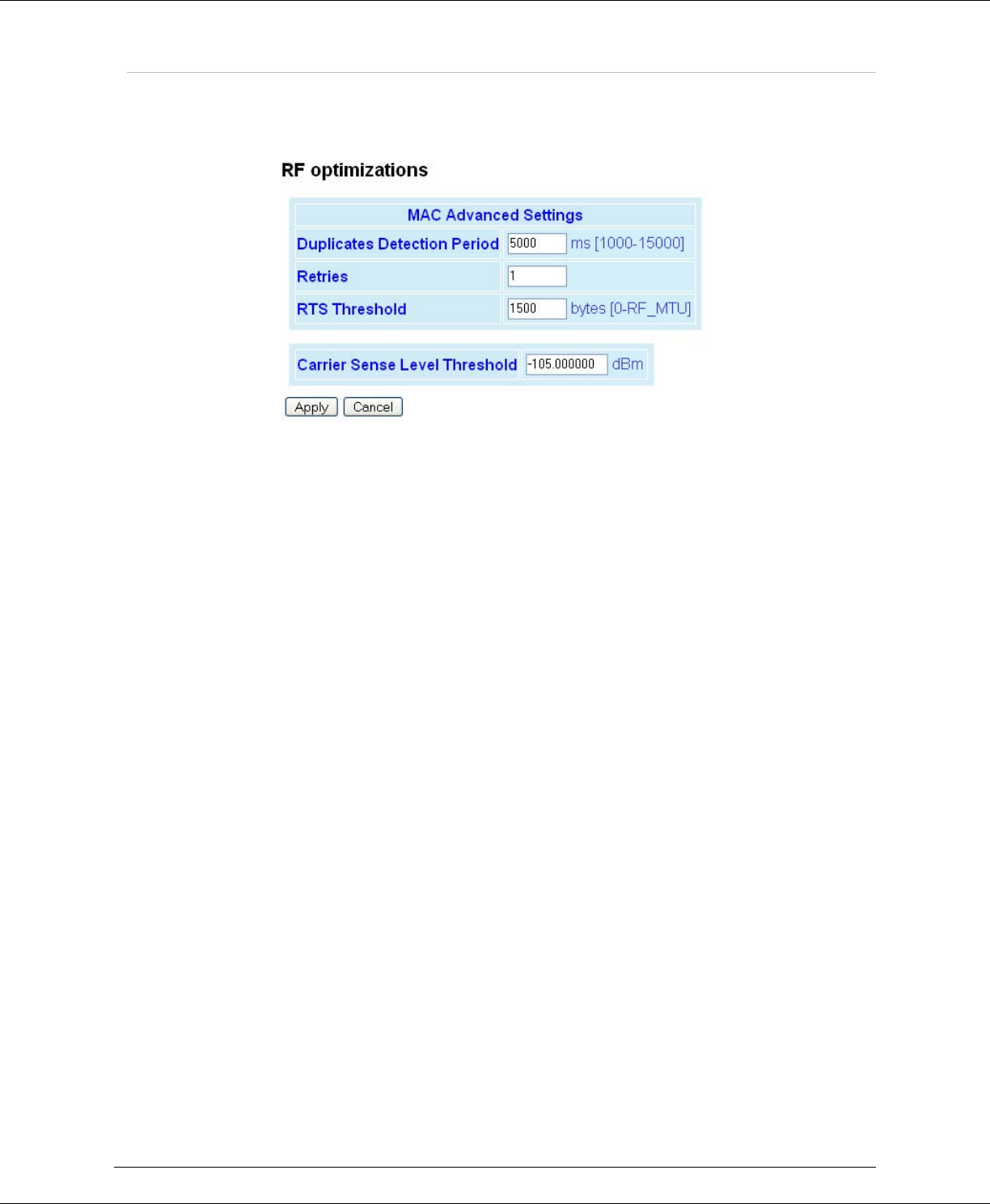
#9 ViPR User Manual_Rev2.doc Page 53
S
SE
ET
TU
UP
P
(
(A
AD
DV
VA
AN
NC
CE
ED
D)
)
RF OPTIMIZATIONS
Figure 7.1 Setup (Advanced)
D
RF Optimizations Web Page
MAC Advanced Settings
Duplicates Detection Period
Default = 5000 ms. The time period in milliseconds the ViPR will look for a duplicate
message being sent, such as control and relay messages. If a duplicate message is
detected it will not be forwarded. Certain protocols such as Modbus cannot tolerate hearing
duplicate messages (echoes). The duplicate messages will not be sent to the Serial ports or
forwarded to the Ethernet connection. Larger values should be used for lower over-the-air
(OTA) speeds and longer path networks.
Retries
Default = 1. This parameter specifies the number of times the MAC layer in the ViPR will try
to resend a packet if the unit does not receive an acknowledgement reply from the receiving
ViPR. Increasing the retries may improve marginal RF paths. For retries to be enabled, RF
Acknowledgments must be enabled and can be configured under Setup (Advanced) D IP
Optimization.
RTS Threshold
Default = 128.
The ViPR utilizes the FAMA-NCS (for floor acquisition multiple access with non-persistent
carrier sensing) protocol. The FAMA-NCS protocol tries to assure that a single ViPR is able
to send data packets free of collisions to a given receiver at any given time. FAMA-NCS is
based on a three-way handshake between the sender and receiver in which the sender uses
non-persistent carrier sensing to transmit a request-to-send (RTS) and the receiver sends a
clear-to-send (CTS). RTS/CTS handshaking protocol enables the ViPR network to avoid
collisions in networks with multiple coverage areas. Before transmitting an RTS frame, a
ViPR listens to the channel to determine if it is already in use. If the channel is busy, the
unit calculates a random back off period to wait before sensing the channel again.

#9 ViPR User Manual_Rev2.doc Page 54
The RTS threshold parameter specifies how large a packet must be before the unit will use
RTS/CTS handshaking in the over-the-air protocol. A value of 0 means the ViPR will always
use over-the-air RTS/CTS handshaking. A value equal to the RF_MTU (OTA maximum
transmit unit) means the ViPR will never use RTS/CTS handshaking. A value of 128 means
the ViPR will use RTS/CTS for packets larger than 128 bytes.
Note: This should not be confused with RTS/CTS for RS232 Serial ports.
Carrier Sense Level Threshold
Default = -110 dBm. This is the threshold the ViPR uses to determine whether a received
RF signal is a valid message or unwanted noise. If an RF level higher than the Carrier
Sense Level Threshold is detected, the ViPR will attempt to decode the signal and will not
transmit until the RF level drops. Outgoing data will be buffered until the channel is
available. The carrier sense may be raised to prevent false carrier sense detection if the
network is installed in a noisy environment. In certain situations where the ambient RF
noise level is very low, the carrier sense level threshold can be lowered to gain extra receive
sensitivity. (The ViPR's specified receive sensitivity depends upon the channel
bandwidth/speed being used. Refer to the product specification in Appendix A for details.)
IP SERVICES
RIPV2
Enabled, Disabled (default). Router Information Protocol v2 is a dynamic IP routing
protocol based on the distance vector algorithm and is only used in Router Mode. RIPV2
is responsible for passing router information to other routers in the network.
IPSD
Enabled (default), Disabled. I/P Services Delivery allows the generation of locally
provided I/P Services such as online diagnostics, etc.
NAT
Enabled, Disabled (default). Network Address Translation (NAT) is a method by which IP
addresses are mapped from one address space to another. In a ViPR, it is normally
used on the WAN side of an IP network to hide local IP addresses from an external IP
network (example: the Internet).
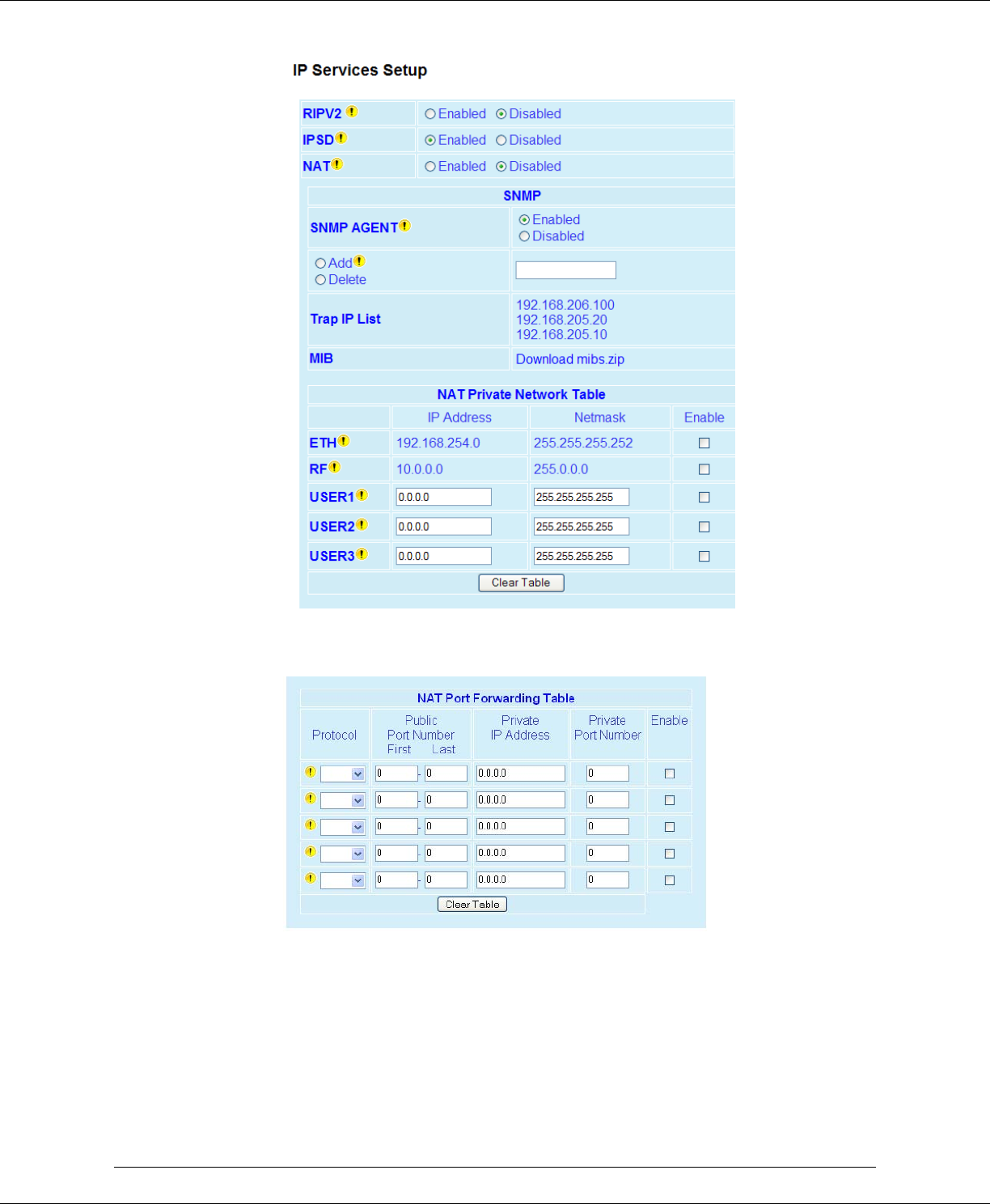
#9 ViPR User Manual_Rev2.doc Page 55
Figure 7.2 Setup (Advanced)
D
IP Services Web Page
Figure 7.3 Setup (Advanced)
D
IP Services Web Page (NAT Port Forwarding)
SNMP
This section is only available when the appropriate feature key is installed in the ViPR.
Contact CalAmp for information about obtaining and installing the SNMP feature.
SNMP (Simple Network Management Protocol) is used by network management systems to
manage and monitor network-attached devices. SNMP is based on the manager/agent
model consisting of a manager, an agent, a database of management information, managed
objects, and the network protocol. The manager provides the interface between the human
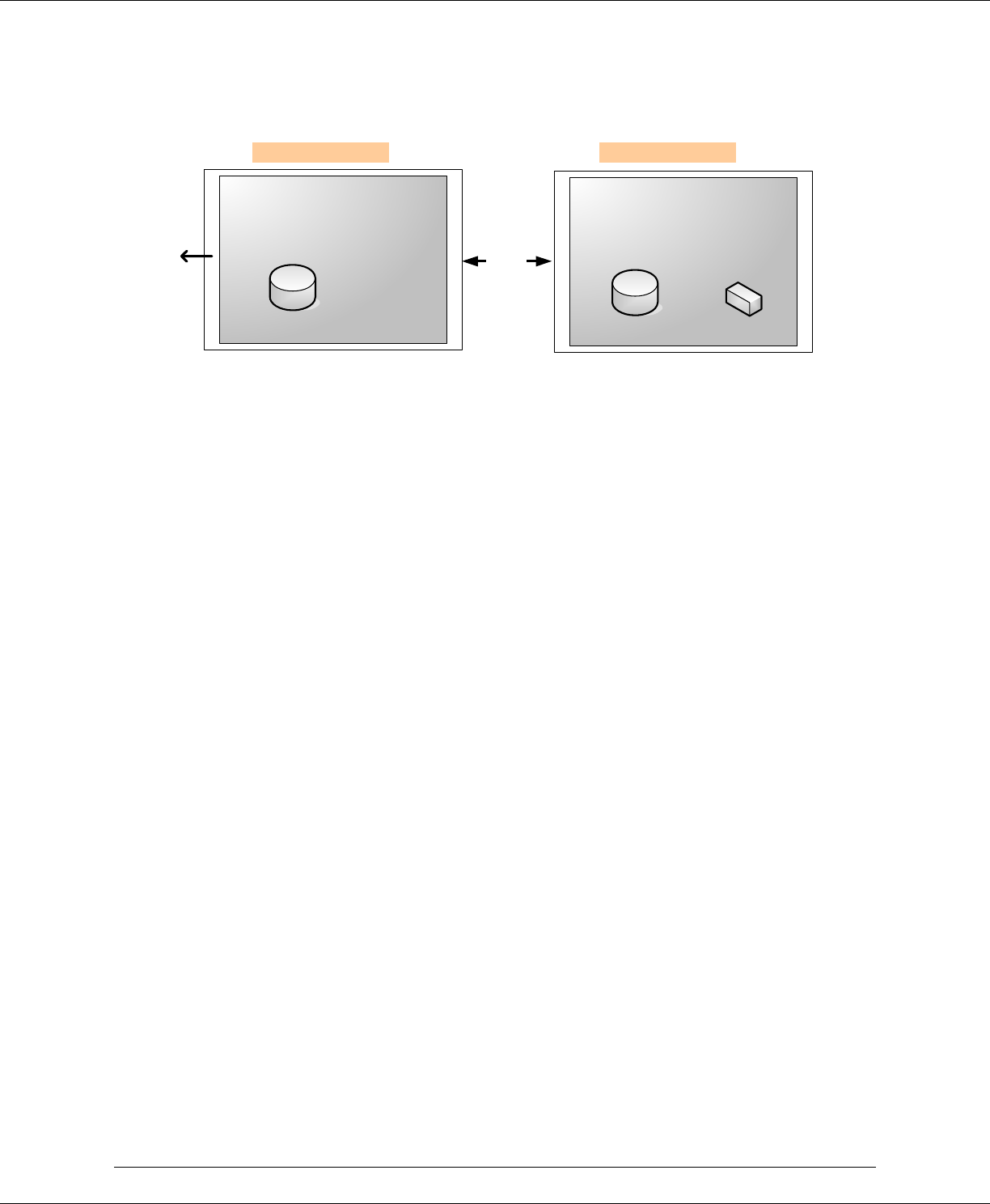
#9 ViPR User Manual_Rev2.doc Page 56
network manager and the management system. The agent provides the interface between
the manager and the physical devices being managed (7.4). SNMP uses basic messages
(such as GET, GET-NEXT, SET, and TRAP) to communicate between the manager and the
agent.
MANAGER AGENT
Management Database Management Database Managed Object
Messages
Network
Protocol
Management System Managed Element
Human Network
Manager
Figure 7.4 - SNMP: manager/agent model
Traps: Traps (or alarms) can be automatically generated by the ViPR radio modem
whenever the forward or reverse power goes out of specification. These traps can be sent to
a user specified IP address or addresses. Use the following steps to enable traps:
1) Enable SNMP (Setup (Advanced) – IP Services)
2) Enter IP Addresses into Trap IP List. (Setup (Advanced) – IP Services)
3) Enable Individual Traps. (Setup (Advanced) – Alarm Reporting)
Trap IP List: This list shows the user programmed IP addresses where the ViPR will send
SNMP traps. To add an IP Address to the list, select the 'Add' radio button, enter the IP
Address into the text box, and then click the 'Apply' button at the bottom of the page.
When the page is refreshed the new IP address will appear in the Trap IP List. To delete an
IP Address from the list, select the 'Delete' radio button, enter the IP Address to delete into
the text box, and then click the 'Apply' button at the bottom of the page.
The ViPR is compatible with SNMP version 2.
MIB
The manager and agent use a Management Information Base (MIB), a logical, hierarchically
organized database of network management information. MIB comprises a complete
collection of objects used to manage entities in a network. A long numeric tag or object
identifier (OID) is used to distinguish each variable uniquely in the MIB and SNMP
messages.
ViPR MIB File
Each ViPR unit firmware package is bundled with three MIB files (found inside mibs.zip file):
• dataradio-regs.mib: contains a top level set of managed object definitions aimed at
managing Dataradio products
• 1213.mib: contains a set of managed object definitions aimed at managing TCP/IP-
based internets
• ipr.mib: contains a set of managed object definitions aimed at managing Dataradio
ViPR modems
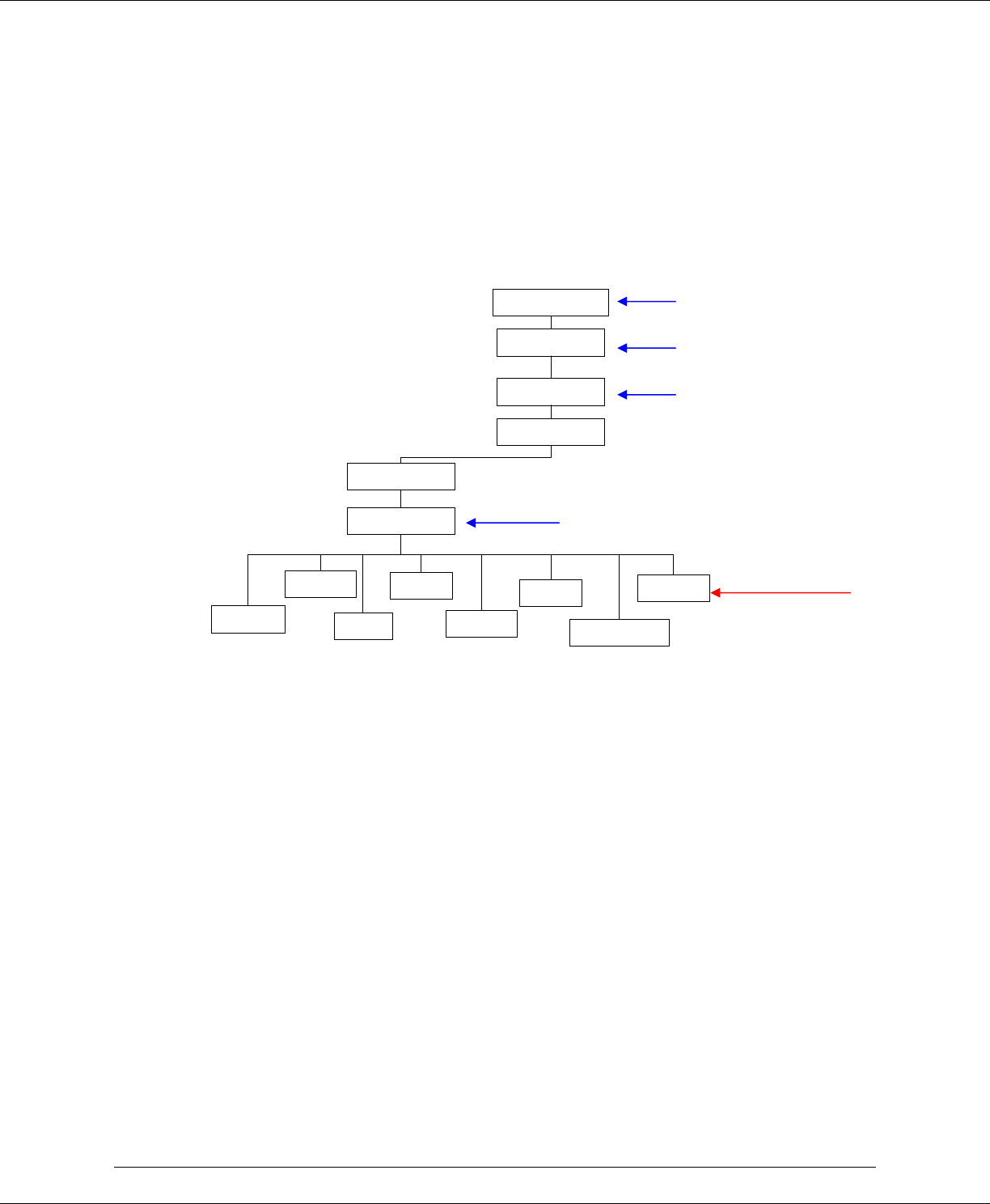
#9 ViPR User Manual_Rev2.doc Page 57
OID
In SNMP, each object has a unique OID consisting of numbers separated by decimal points.
These object identifiers naturally form a tree. Figure 7.5 illustrates this tree-like structure
for 1213.mib, which comes bundled the ViPR unit package. A path to any object can be
easily traced starting from the root (top of the tree). For example, object titled “SNMP” has
a unique OID: 1.3.6.1.2.1.11. The MIB associates each OID with a label (e.g. “SNMP”) and
various other parameters. When an SNMP manager wants to obtain information on an
object, it will assemble a specific message (e.g. GET packet) that includes the OID of the
object of interest. If the OID is found, a response packet is assembled and sent back. If
the OID is not found, a special error response is sent that identifies the unmanaged object.
Figure 7.5 - Branch of the 1234.mib OID tree
MIB Browser
CalAmp recommends opening all MIB files with a MIB browser. For simple networks, a
basic, free application such as ”iReasoning MIB browser” could be used. However, for
managing complex networks CalAmp recommends a more advanced software application,
such as “Castle Rock SNMPc Network Manager”. In a MIB browser, each object (or node)
can be selected and its properties (including its OID) can be observed.
Note: Both “Read Community” and “Write Community” passwords are required to
operate SNMP MIB. For all ViPR radio modems the same password is used for both
read and write. This password is the same password used to access the ViPR web
pages.
ipr.mib
Figure 7.6 shows top-level objects of the ipr.mib file:
• viprIdentity
• viprSettings
• viprStatistics
• viprDiagonistics
• viprNeighbors
org (3)
iso(1)
ip(4)
icmp(5) SNMP (11)
udp(7)
system (1)
interfaces (2)
dod (6)
internet (1)
mgmt (2)
mib-2 (1)
tcp (6) transmission (10)
1.3.6.1.2.1
1.3.6.1.2.1.11
1
1.3.6
1.3

#9 ViPR User Manual_Rev2.doc Page 58
• viprControl
• viprOptions
These seven branches expand into additional branches and leaves. Again, all ipr.mib objects
can be accessed through a MIB browser.
Figure 7.6 - ViPR OID Tree
NAT Overview
The purpose of the NAT protocol is to hide a private IP network from a public network. The
mechanism serves both as a firewall and to save IP address space.
The NAT enabled device translates the source address of packets transiting from the private
network to the public network. The original IP source address gets replaced by the NAT
enabled device’s IP address (address of the outgoing interface). The NAT module creates
an address translation table that is used when traffic is coming back from the public
network to the private network.
ViPR
Module
(
1
)
ViPR
Identity
(
2
)
ViPR
Settings
(
3
)
ViPR
Diagnostics (5)
ViPR
Neighbors (6)
ViPR
Control (7)
ViPR
Options (8)
V
iPR (2)
ViPR
Statistics (4)
1
.
3
.
6
.
1
.
4
.
1
.
3732
.
4
...
...
...
...
...
...
viprSetRelay Point (3)
viprSetIPFwdMode (4)
viprSetBridgeFwd (5)
viprSetGroup (1)
viprSetAccessPoint (2)
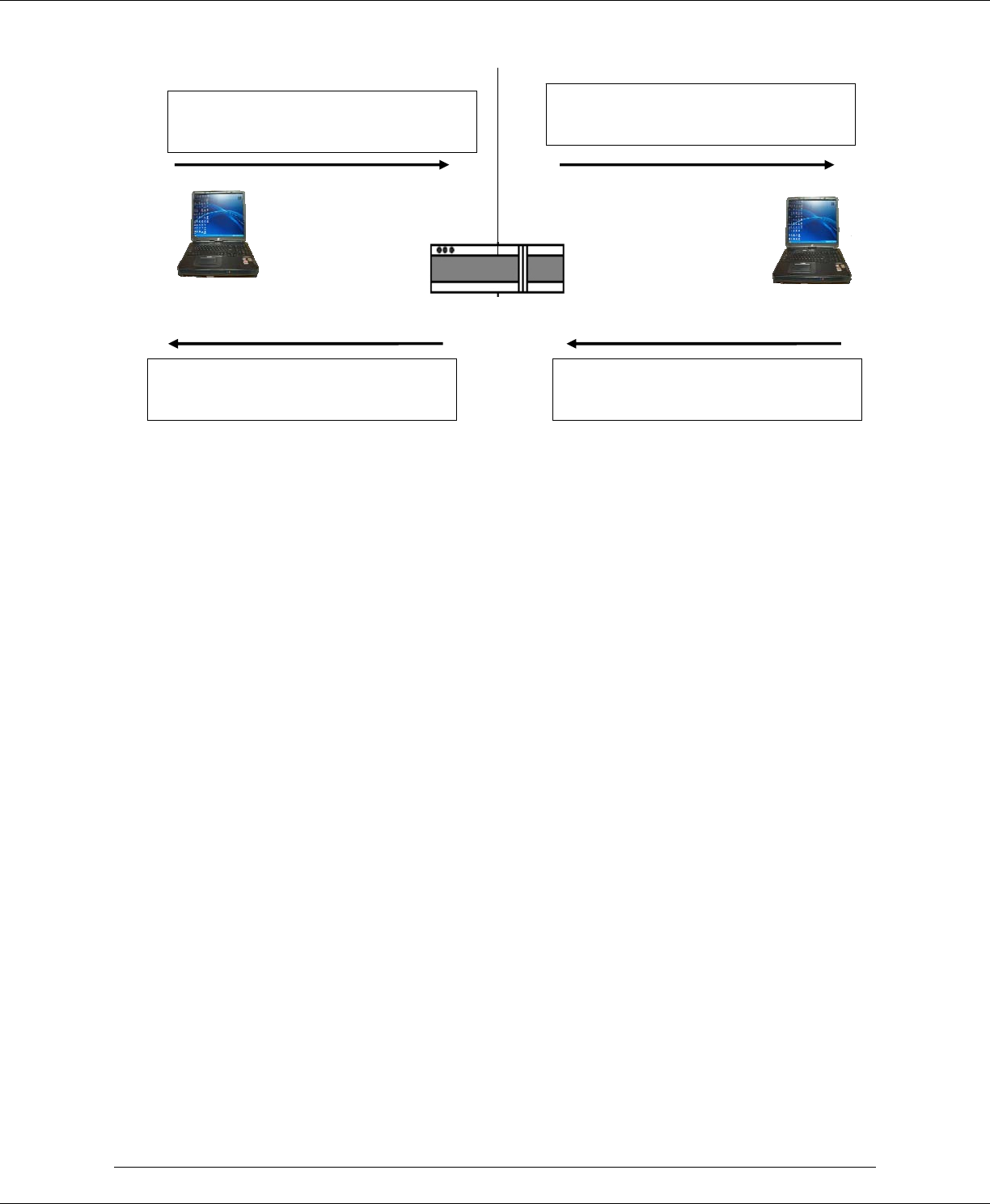
#9 ViPR User Manual_Rev2.doc Page 59
Figure 7.7 Basic NAT Operation
In our example, Host 1 sends a packet to Host 2. The Host 2 device does not see the private
IP address of Host 1. When Host 2 sends a reply to Host 1, Host 2 uses the destination IP
address 172.31.5.1, which is translated back to the appropriate destination IP address by
the NAT enabled device. (See Figure 7.7)
NAT does a lot more than just translation of the source IP address. For the UDP and TCP
protocol, NAT will also translate the source port numbers. Special handling is also done for
more specific protocols like FTP (port 21) and Modbus (port 502).
NAT on ViPR
The user can select which of two interfaces (Ethernet or RF) will be considered private. The
following examples illustrate how to configure the ViPRs. The examples use a private
network of 192.168.205.X and a public network of 172.31.5.X.
Ethernet Interface Private
Figure 7.8 shows the NAT enabled for the Eth interface.
Packet (1)
Source Address 192.168.205.2
Destination Address 172.31.5.2
Packet (1)
Source Address 172.31.5.1
Destination Address 172.31.5.2
NAT Enabled Device
Packet (2)
Source Address 172.31.5.2
Destination Address 192.168.205.2
Packet (2)
Source Address 172.31.5.2
Destination Address 172.31.5.1
Host 1
192.168.205.2 Host 2
172.31.5.2
192.168.205.1 172.31.5.1
Public Network 172.31.5.0
Private Network 192.168.205.0
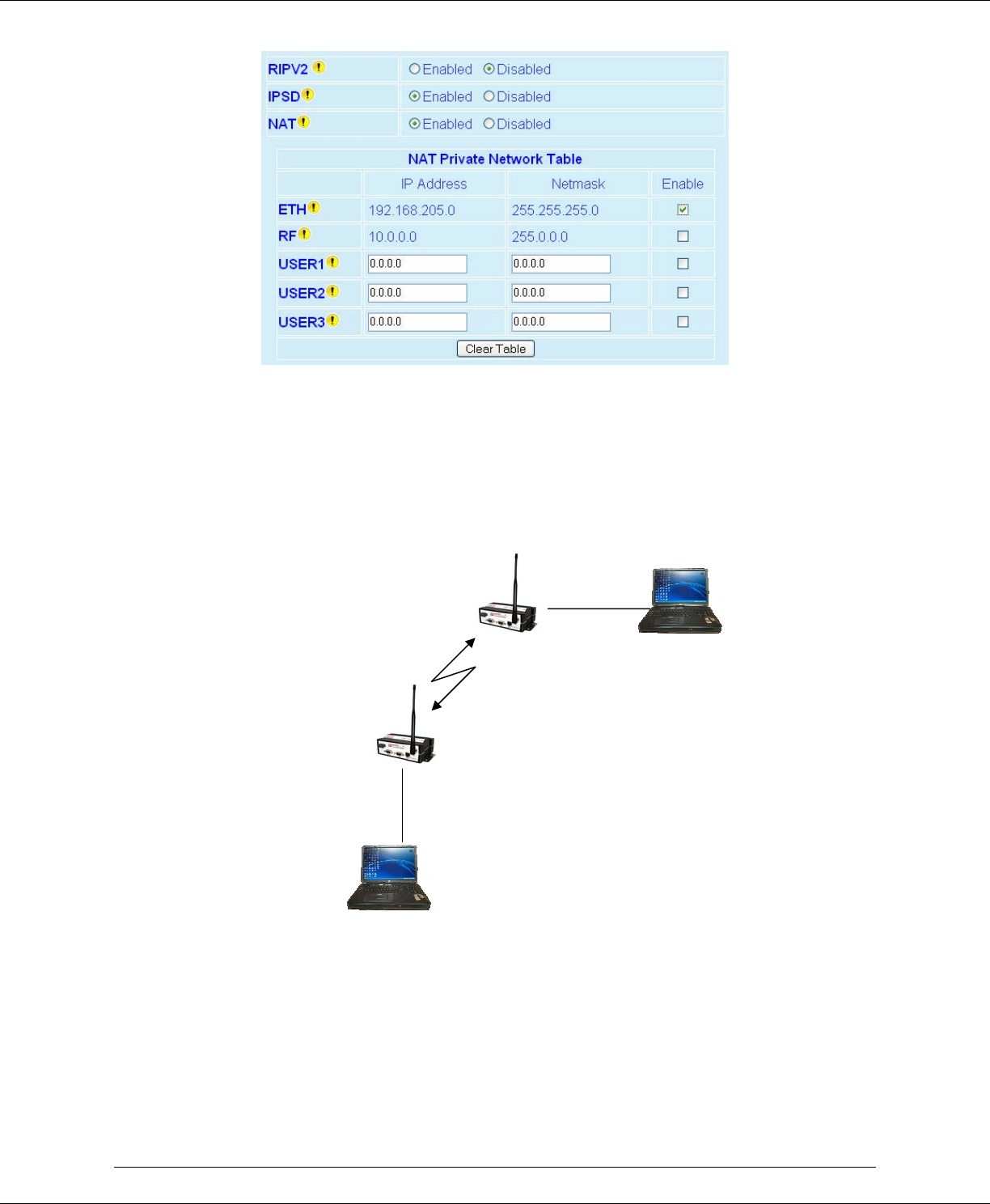
#9 ViPR User Manual_Rev2.doc Page 60
Figure 7.8 Nat on ViPR: NAT enabled, Eth interface considered private
Figure 7.9 shows a ViPR configuration protecting ViPR (1) Ethernet interface IP address from
hosts located on a public network.
Figure 7.9 ViPR NAT Enabled, Ethernet interface considered private
An IP packet whose source IP address originates from the Ethernet network and is sent
towards the RF network, will have its source IP address replaced by the RF IP address of
ViPR(1) as shown in Figure 7.10.
Eth: 172.31.5.1
ViPR (2)
(NAT disabled) Public Network
RF: 10.0.14.203
RF: 10.0.14.186
Eth: 192.168.205.1
Host 2
Eth: 172.31.5.2
ViPR (1)
(NAT enabled, 192.168.205.0/24
Ethernet Interface is private)
Private Network
Host 1
Eth: 192.168.205.2
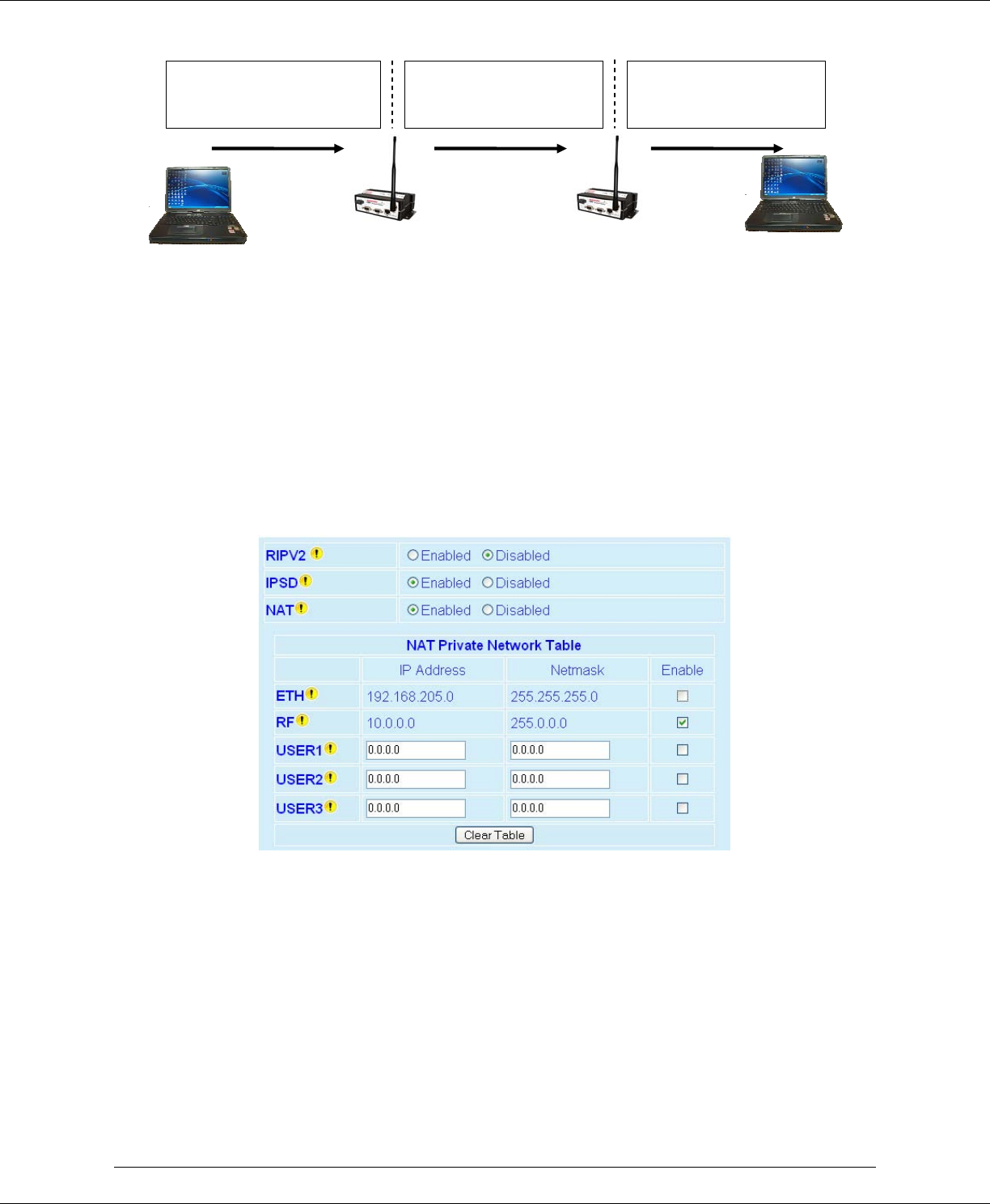
#9 ViPR User Manual_Rev2.doc Page 61
Figure 7.10 Private to Public Packet flow
Note: Host 1 will be able to ping Host 2, however Host 2 will not be able to ping or
originate a message to Host 1 when NAT Eth enabled.
RF Interface Private
Figure 7.11 shows the NAT enabled for the RF interface.
Figure 7.11 NAT on ViPR: RF interface considered private
Packet (1)
Source Address 192.168.205.2
Destination Address
172.31.5.2
Packet (1)
Source Address 10.0.14.203
Destination Address
172.31.5.2
Packet (1)
Source Address 10.0.14.203
Destination Address
172.31.5.2
Host 1
192.168.205.2
Host 2
172.31.5.2
V
iPR 1
NAT enabled, 192.168.205/24,
Eth is private
V
iPR 2
NAT disabled
Private Network RF Network Public Network
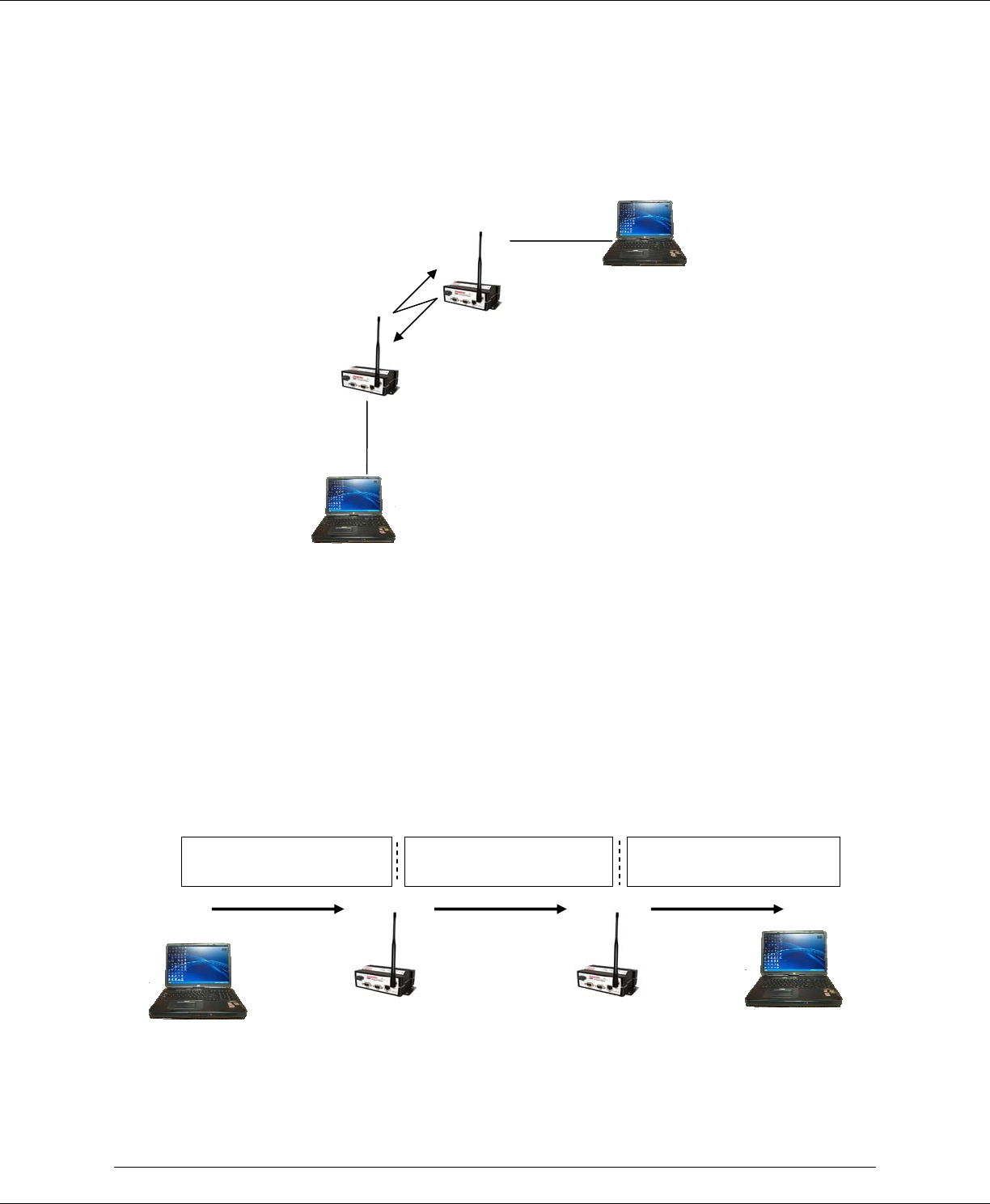
#9 ViPR User Manual_Rev2.doc Page 62
Figure 7.12 shows a ViPR configuration protecting ViPR (2) RF interface and ViPR (1)
Ethernet interface from hosts located on a public network.
Figure 7.12 NAT on ViPR: Private RF interface and Private Eth interface
An IP packet whose source IP address originates from the RF network and is sent towards
the Ethernet network will have its source IP address replaced by the Ethernet IP address of
ViPR (2). Notice in this configuration the Ethernet IP address for ViPR (1) is considered
private and the RF IP address for ViPR (2) is considered private. Figure 7.13 shows how the
packets will be modified as the packets pass through the network.
Figure 7.13 Packet flow Private Eth and RF interface
In example Figure 7.14, the RF interface of ViPR (2) is considered private. NAT is disabled
for ViPR (1).
Eth: 172.31.5.1
RF: 10.0.14.203
RF: 10.0.14.186
Eth: 192.168.205.1
Host 2
Eth: 172.31.5.2
ViPR (1)
(NAT enabled,
Ethernet Interface is private)
ViPR (2)
(NAT enabled,
RF interface private)
Private Network
Host 1
Eth: 192.168.205.2
Public Network
Pubic
Network
RF Private Network
Packet (1)
Source Address 192.168.205.2
D
est
in
at
i
o
n A
dd
r
ess
172.
3
1.
5
.2
Packet (1)
Source Address 10.0.14.203
D
est
in
at
i
o
n A
dd
r
ess
172.
3
1.
5
.2
Packet (1)
Source Address 172.31.5.1
D
est
in
at
i
o
n A
dd
r
ess
172.
3
1.
5
.2
Host 1
192.168.205.2
Host 2
172.31.5.2
V
iPR 1
NAT enabled, Eth is private
V
iPR 2
NAT enabled, RF is private
Private Network Private RF Network Public Network
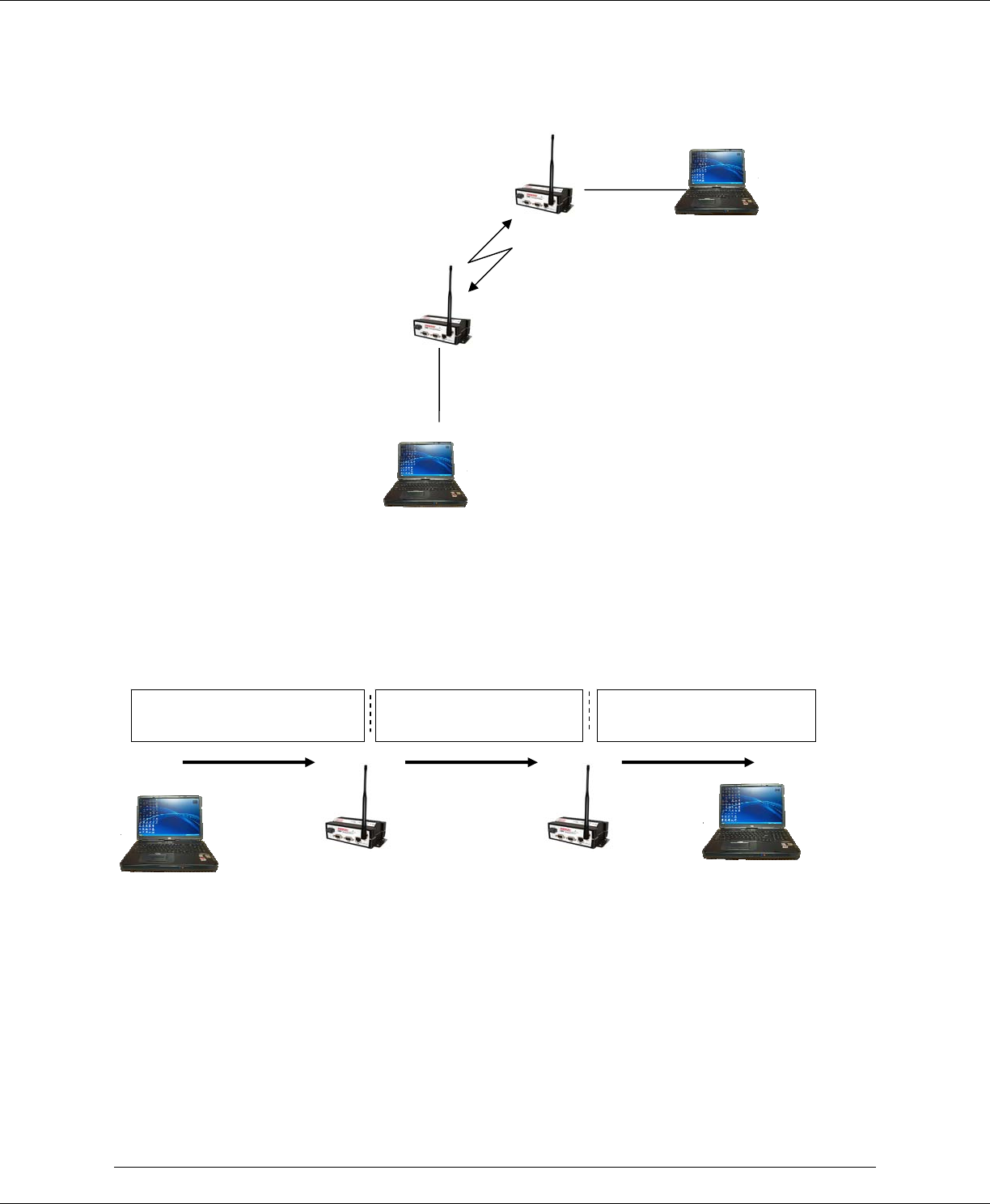
#9 ViPR User Manual_Rev2.doc Page 63
Figure 7.14 NAT on ViPR: RF interface considered private
Notice in Figure 7.15 that when Host 1 sends a packet, the source IP address is not changed
by ViPR (2) because the source does not originate from the private RF network.
Figure 7.15 Packet flow, RF interface considered private
In the previous example, ViPR (1) was changing the source IP address of the packet,
making the ViPR (2) believe that the packet was originating from the RF network.
User NAT Entries
The user can add three USER IP addresses that will be considered private. Figure 7.16
shows USER1 192.168.205.125 and USER2 192.168.205 will be considered private. If
Eth: 172.31.5.1
RF: 10.0.14.203
RF: 10.0.14.186
Eth: 192.168.205.1
Host 2
Eth: 172.31.5.2
ViPR (1)
(NAT disabled)
ViPR (2)
(NAT enabled,
RF interface private)
Network
Host 1
Eth: 192.168.205.2
Public Network
Private RF Network
Packet (1)
Source Address 192.168.205.2
Destination Address 172.31.5.2
Packet (1)
Source Address 192.168.205.2
Destination Address 172.31.5.2
Packet (1)
Source Address 192.168.205.2
Destination Address 172.31.5.2
Host 1
192.168.205.2
Host 2
172.31.5.2
V
iPR 1
NAT disabled,
V
iPR 2
NAT enabled, RF is private
Public Network Private RF Network
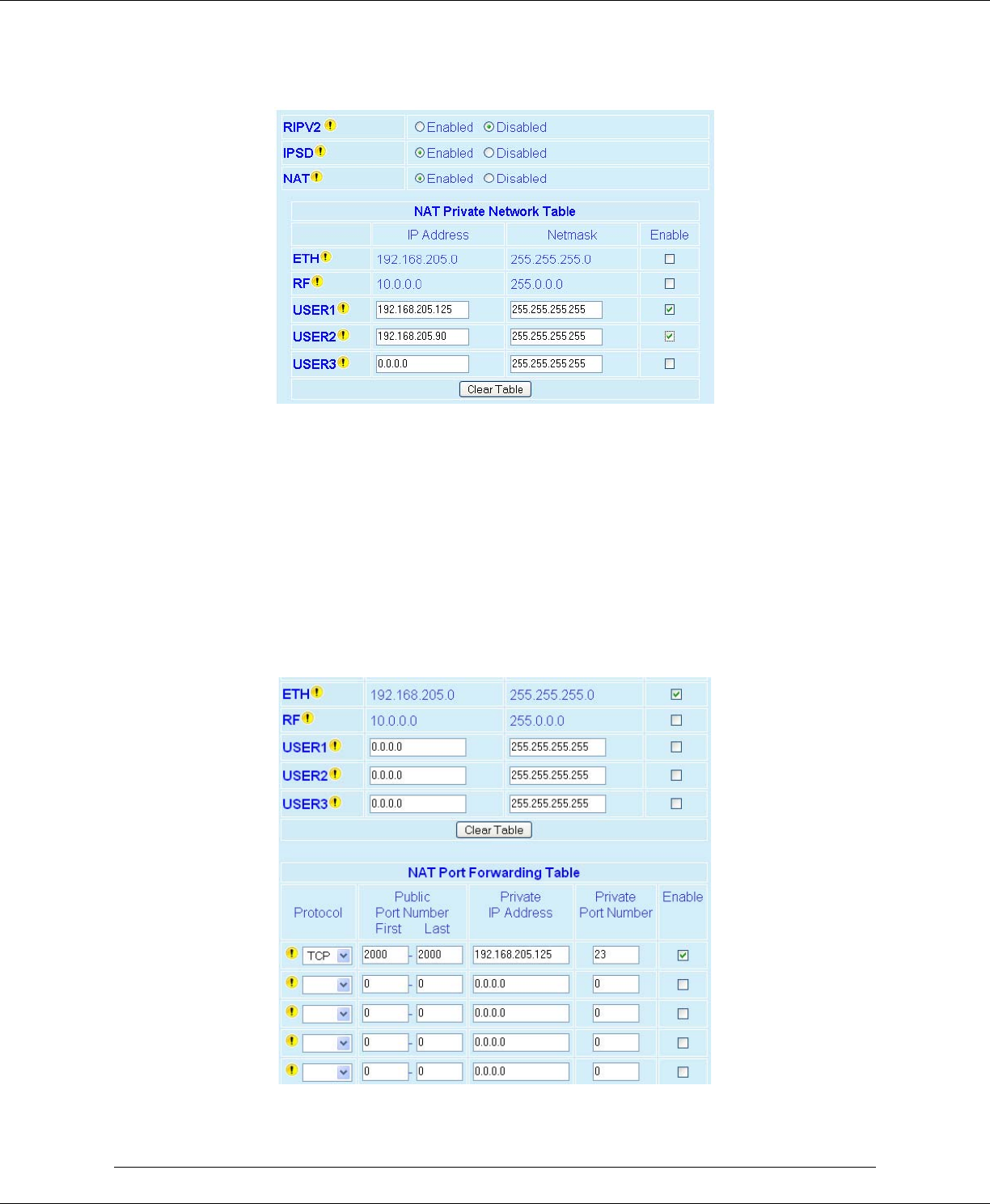
#9 ViPR User Manual_Rev2.doc Page 64
USER3 192.168.205.87 is connected to the ViPR, but not added to the table, USER3
192.168.205.87 would not be considered private.
Figure 7.16 NAT on ViPR: USER1 and USER2 considered private
NAT Port Forwarding
The NAT Port Forwarding table allows the user to specify a particular public port or range of
ports to be forwarded to the private network hidden by the Network Address Translation
Table. The user can also select between TCP and UDP protocols. Figure 7.17 shows the NAT
Eth IP subnet 192.168.205.0 will be hidden from the Public Network. Any TCP packets sent
to the ViPR with port number 2000 will be redirected to the Private IP Address and Private
Port Number entered in the NAT Port Forwarding Table as shown in Figure 7.17.
Figure 7.17 NAT on ViPR: Port 2000 is redirected to 192.168.205.125:23
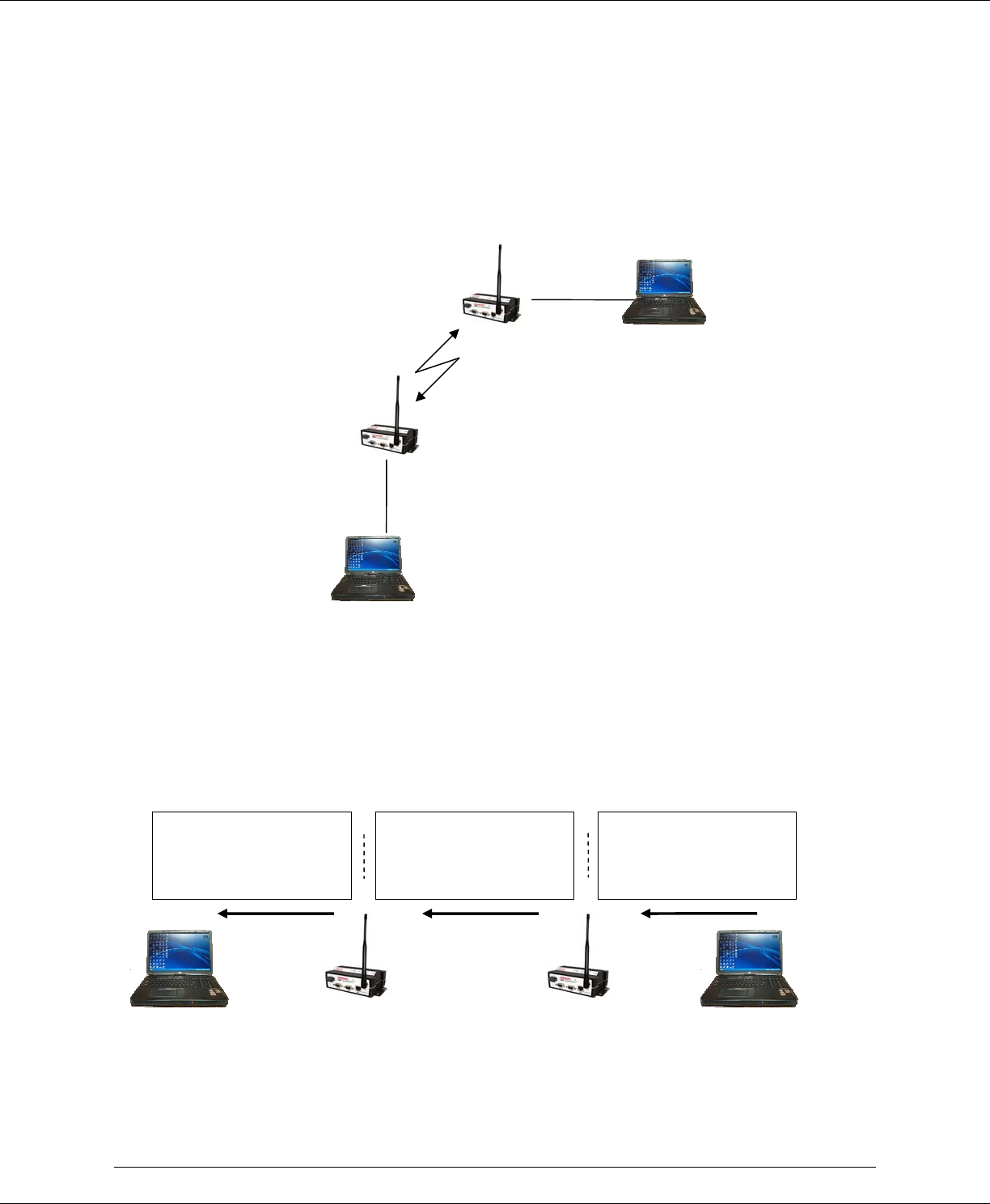
#9 ViPR User Manual_Rev2.doc Page 65
Figure 7.18 shows the Private Network 192.168.205.0 being protected from the Public
Network 172.31.5.0. ViPR (1) NAT Eth interface is enabled and ViPR (2) NAT is disabled.
The Host 172.31.5.2 cannot send packets directly to the Private Network because it is
hidden. In this example, remember that Host 172.31.5.2 thinks the IP packets are coming
from 10.0.14.203.
Figure 7.18 NAT on ViPR: Port 2000 is redirected to 192.168.205.125:23
When Host 172.31.5.2 wants to send packets to Host 192.168.205.2 the packets are sent to
10.0.14.203. NAT port translation allows Host 172.31.5.2:1435 (port 1435) to send TCP
packets to 192.168.205.5:23 (port 23) by sending the packets to 10.0.14.203:2000 (port
2000). Figure 7.19 shows how the packets would be modified as they moved through the
network.
Figure 7.19 Packet flow, Port redirection
Packet (1)
Source Address
172.31.5.2:1435
Destination Address
192.168.205.2:23
Packet (1)
Source Address
172.31.5.2:1435
Destination Address
10.0.14.203:2000
Packet (1)
Source Address
172.31.5.2:1435
Destination Address
10.0.14.203:2000
Host 1
192.168.205.2
Host 2
172.31.5.2
V
iPR 1
NAT enabled, Eth is private
Port 2000 translate to Port 23
V
iPR 2
NAT disabled
Private Network RF Network
Eth: 172.31.5.1
RF: 10.0.14.203
Port 2000
RF: 10.0.14.186
Eth: 192.168.205.1
Host 2
Eth: 172.31.5.2
Port 1435
ViPR (2)
(NAT disabled)
Private Network
Host 1
Eth: 192.168.205.2
Port 23
Public Network
RF Network
ViPR (1)
(NAT enabled,
Ethernet Interface is private, Port redirected)
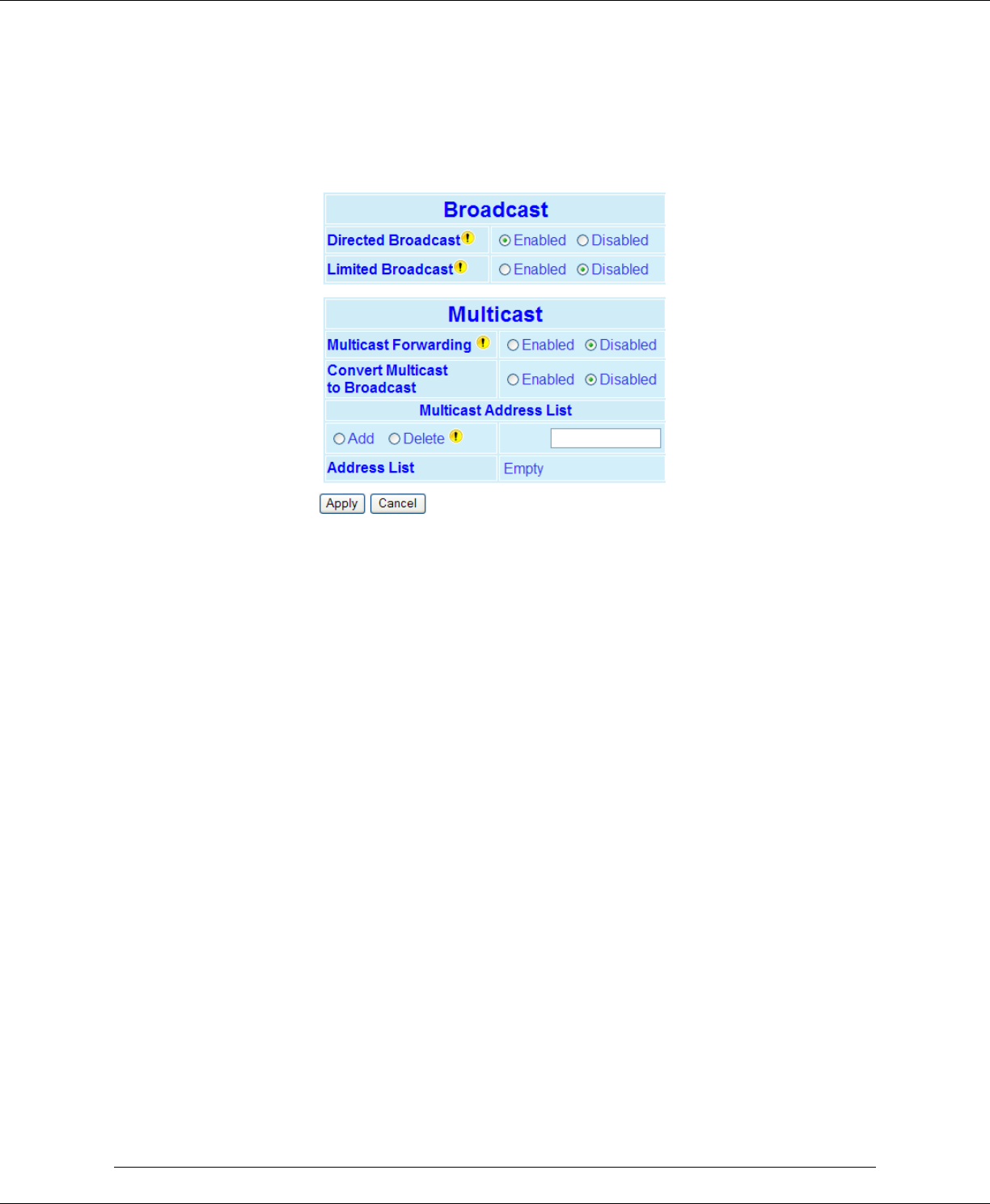
#9 ViPR User Manual_Rev2.doc Page 66
IP ADDRESSING
There are some SCADA PLC protocols that use different IP addressing modes. GE’s Global
Data protocol has the ability to send out a group message command to remote PLCs. The
group message is actually a multicast message. The Multicast feature allows the user to
add or delete a remote’s IP address.
Figure 7.20 Setup (Advanced)
D
IP Addressing Modes Web Page
Broadcast Mode
Directed Broadcast
Select: Enabled, Disabled; Default: Enabled.
Controls forwarding of Directed Broadcast packets
Limited Broadcast
Select: Enabled, Disabled; Default: Disabled.
Controls forwarding of Limited Broadcast packets
Convert Multicast to Broadcast
Select: Enabled, Disabled; Default: Disabled.
Multicast Mode
Multicast
Select: Enabled, Disabled; Default: Disabled.
Controls forwarding of Multicast packets (based on the MULTICAST ADDRESS LIST).
Multicast can be used when one-to-many communications is required.
Address List
ADD or DELETE IP Address of the device to be added or removed. Only valid multicast
addresses are accepted and displayed in the ADDRESS LIST.
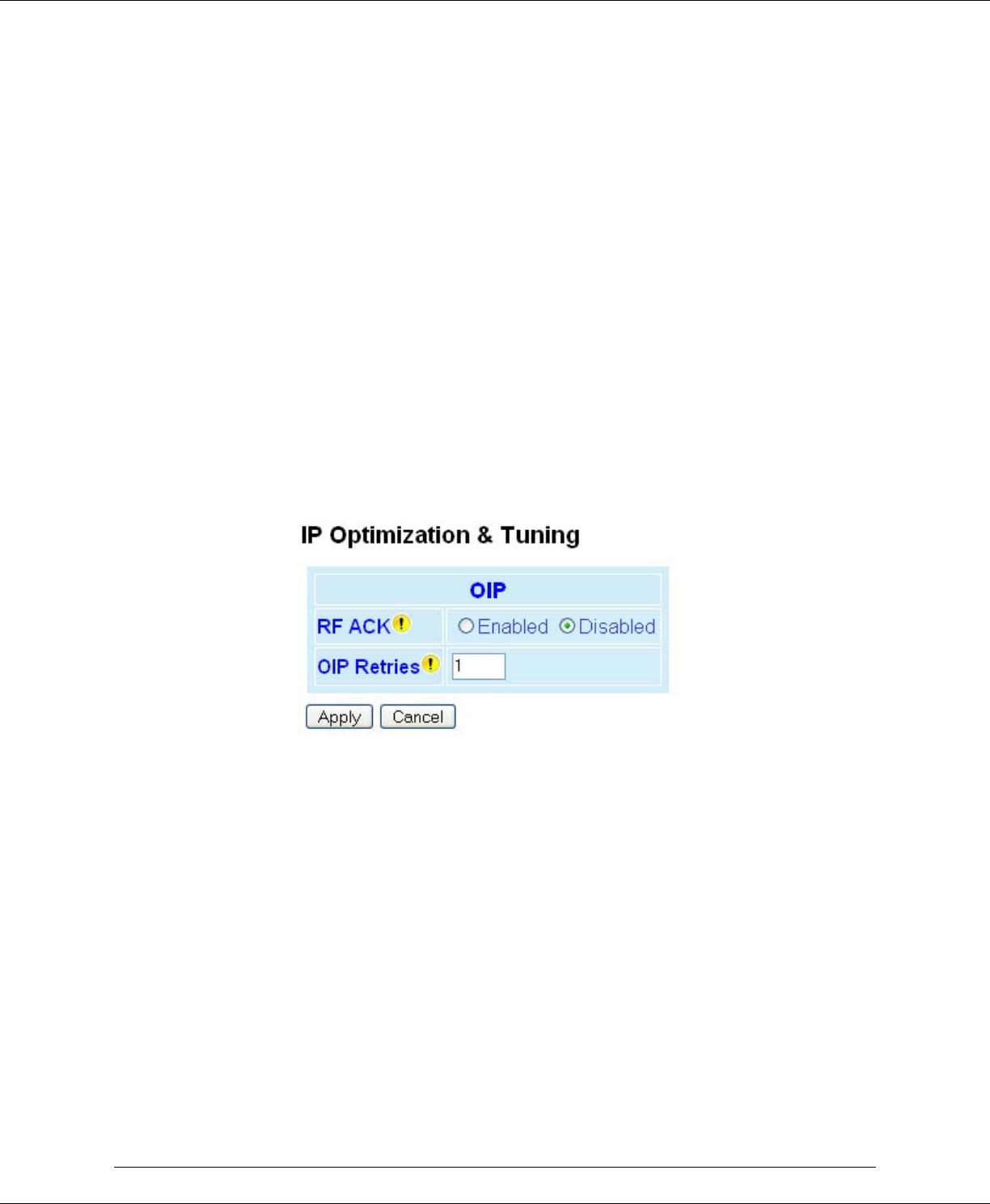
#9 ViPR User Manual_Rev2.doc Page 67
When an IP packet is received via the Ethernet LAN and the destination IP address matches
one of the multicast IP address in the list, it is forwarded over the RF network. Remote
units will then send it over the remote LAN to the appropriate device(s).
IP OPTIMIZATION
IP Optimization is only available in Router Mode.
Router Mode - RF ACK
RF Acknowledgements - Default = Disabled.
If RF ACK is enabled, the receiving ViPR will reply with a quick acknowledgement message
to the sending ViPR to indicate that it has received the packet successfully. If the sending
ViPR does not receive the acknowledgement, it will assume the message was lost and will
try to resend the message. The number of retries can be specified.
Router Mode - OIP Retries
Number of OIP retries - Default = 2.
This parameter specifies the number of retries that the OIP layer will attempt if an
acknowledgement message is not received from the destination ViPR. Retries are only
enabled if Router mode is selected and RF ACK is turned on. The number of retries should
be increased if a there is a marginal RF path to another unit.
Figure 7.21 Setup (Advanced)
D
IP Optimization Web Page
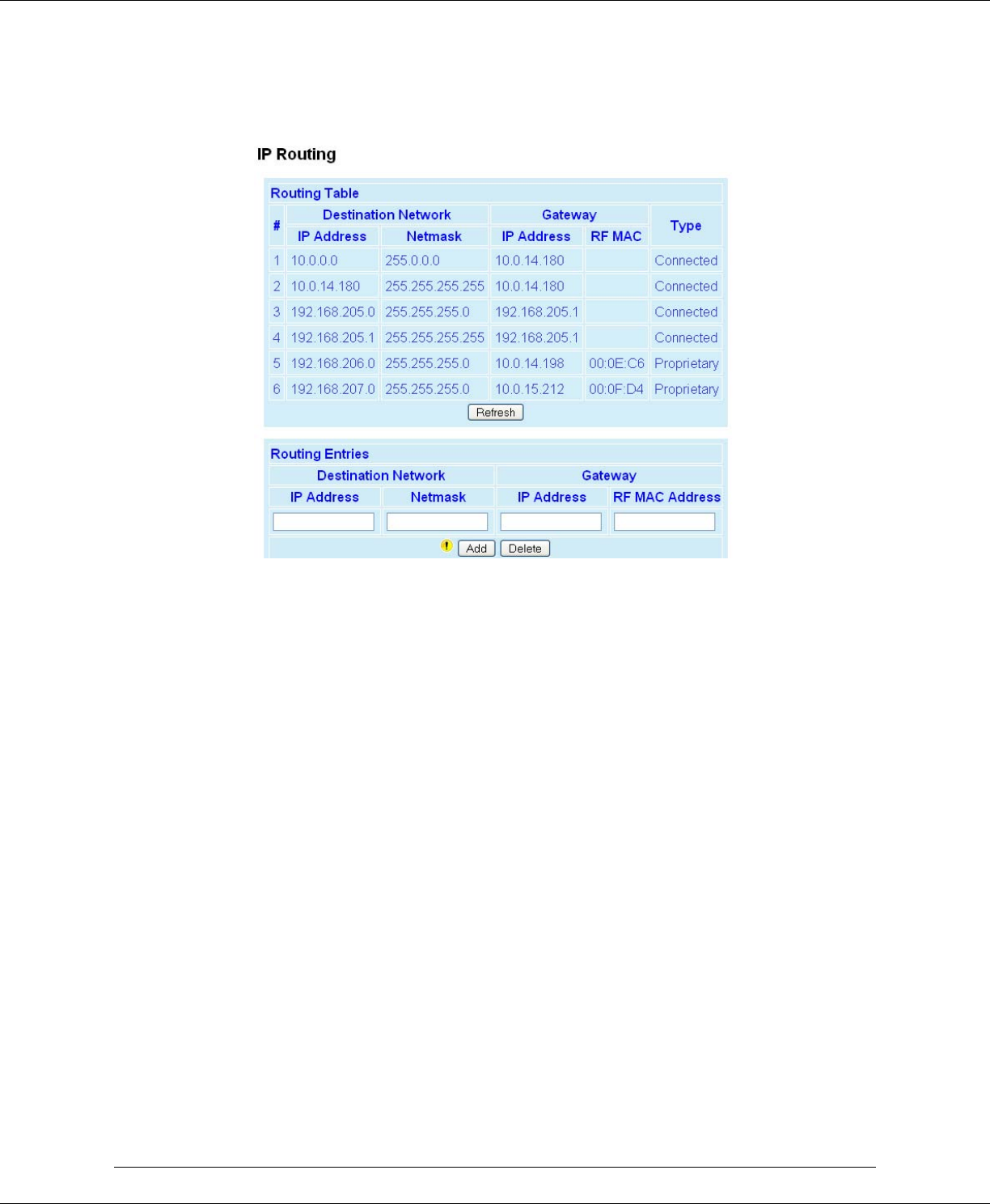
#9 ViPR User Manual_Rev2.doc Page 68
IP ROUTING (TABLE/ENTRIES)
Figure 7.22 Setup (Advanced)
D
IP Routing Web Page
Routing Table
Displays the table of IP routes that are active in the ViPR. The routing table will be
populated by the Neighbor Discovery process and/or by manual entries.
Destination Network
Displays the IP Address and Netmask of a route.
Gateway
Displays the IP Address and the RF MAC address (if route is pointing to another ViPR) of the
destination gateway.
Type
There are three different types of routes:
Connected: Direct physical connection on the Ethernet port.
Static: User-defined routes.
Proprietary: Routes learned by the ViPR unit that point to over-the-air destinations.
Routing Entries
This section allows the user to manually enter new routes or delete existing routes.

#9 ViPR User Manual_Rev2.doc Page 69
TIME SOURCE
SNTP
Simple Network Time Protocol (SNTP) is a protocol for synchronization of clocks of computer
systems (ViPRs) over the Internet. When SNTP client is enabled the ViPR will poll the time
server for the time information update.
Client
Select: Enabled, Disabled; Default: Disabled
Server Address
Default: 0.0.0.0
Enter the IP Address of the SNTP Server in dot decimal format.
Period
Default: 64
Enter the period (in seconds) at which the SNTP Server is polled.
SNTP UTC Time
0 (default)
Displays the last update received from the SNTP Server (in seconds).
Time Zone
Time Zone
Select from List: local time zone; Default: (GMT) Greenwich Mean Time
Daylight Saving
Select: Enabled, Disabled; Default: Disabled
ALARM REPORTING
The ViPR radio can be enabled to report several different types of alarms using the SNMP
protocol. If SNMP is enabled (Setup (Advanced) – IP Services) and reporting is enabled for
a specific alarm, the ViPR will send an SNMP Trap to each of the IP addresses listed in the
Trap IP List (Setup (Advanced) – IP Services) whenever an alarm occurs.
If the condition that caused the alarm clears, the ViPR will send a second SNMP Trap to each
of the IP addresses listed in the Trap IP List, indicating that the error has cleared.
Forward Power Alarm & Notification
The Forward Power Alarm will trigger when the measured forward power drops 1 dB or more
below the user configured transmit power. The Forward Power Alarm SNMP trap is
generated when this condition occurs. When the forward power returns to within 0.8 dB of
the wanted power the error is cleared and a second notification is sent indicating the error
has cleared.
For example, assume the ViPR is programmed to transmit at 10W. If the measured forward
power drops below 7.9W then the error is detected and the SNMP Trap or Alarm is

#9 ViPR User Manual_Rev2.doc Page 70
generated. If the forward power then rises above 8.3W the error is cleared and a second
SNMP Trap or Notification is generated.
Reverse Power Alarm & Notification
The Reverse Power Alarm will warn the user of a major problem with the Power Amplifier or
Antenna, such as the antenna becoming disconnected. The alarm will trigger when the
measured reverse power increases to within 3 dB of the user configured transmit power.
The Reverse Power Alarm SNMP trap is generated when this condition occurs. When the
reverse power drops 5 dB below of the wanted power the error is cleared and a second
notification is sent indicating the error has cleared.
For example, assume the ViPR is programmed to transmit at 10W. If the measured reverse
power increases above 5.0W then the error is detected and the SNMP Trap or Alarm is
generated. If the reverse power then drops below 3.1W the error is cleared and a second
SNMP Trap or Notification is generated.
PA Power Alarm & Notification
The PA Power Alarm & Notification will warn the user when the power amplifier goes into
either a Foldback or Shutdown State. The power amplifier will first go into the Foldback
state if the PA temperature gets too hot. In the foldback state, the ViPR will cut the
transmit power in half every 4 minutes until the PA has cooled off. The transmit power will
not be reduced further if the power is originally set for 1W or reaches 1W due to foldback.
If the temperature continues to increase, the PA may go into Shutdown mode. If this
happens, another SNMP trap will be generated, indicating that the PA is Shutdown. The
ViPR will not transmit until the unit cools down. This trap will not be sent over the air and
will only be sent out the Ethernet interface.
When the temperature drops back to a safe level, the ViPR will resume transmitting at full
power and the PA Power Notification SNMP Trap will be generated to indicate that the ViPR
is operating at full power again.
USER SETTINGS
Temperature Display
Select Celsius, Fahrenheit; Default: Celsius
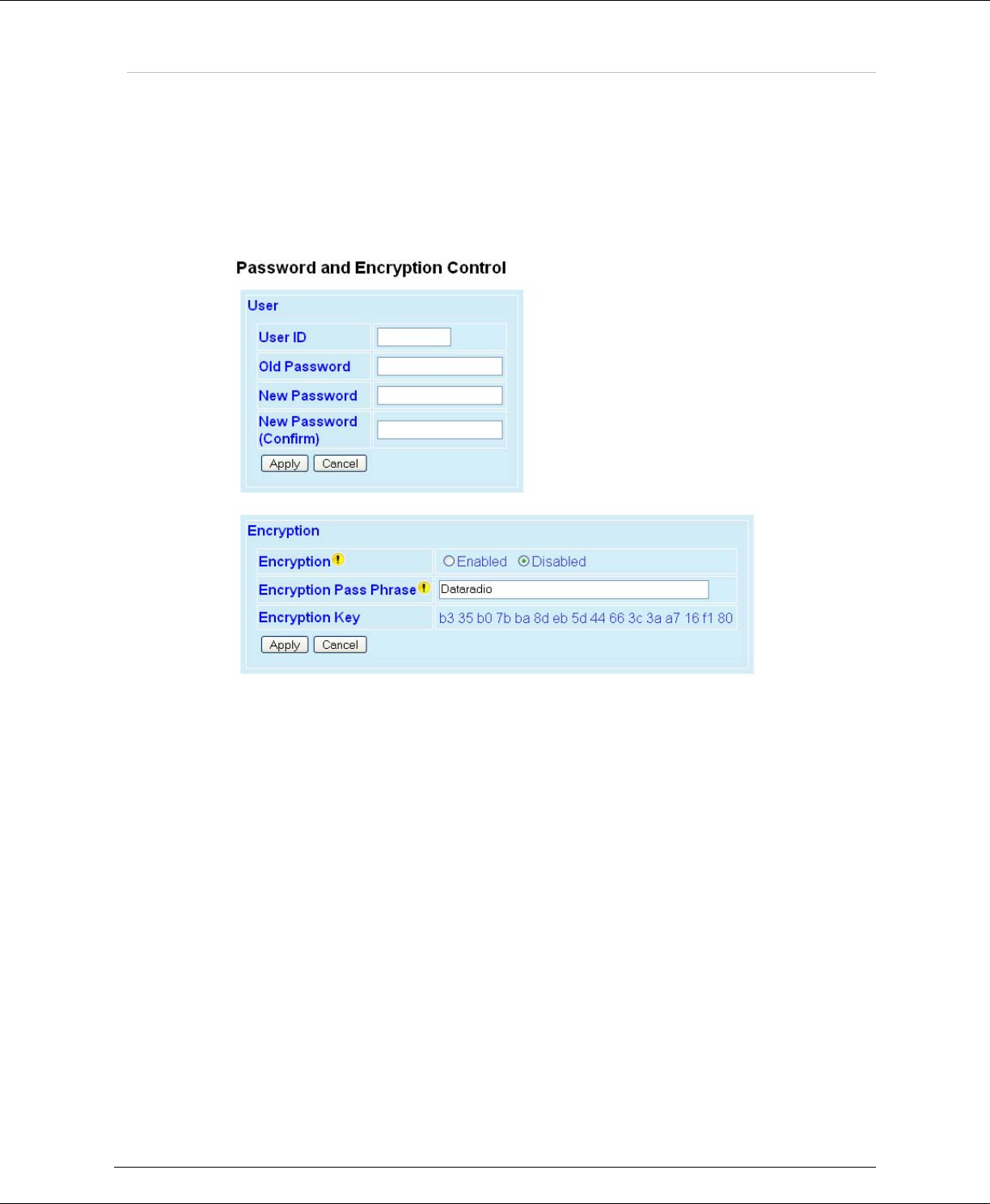
#9 ViPR User Manual_Rev2.doc Page 71
S
SE
EC
CU
UR
RI
IT
TY
Y
Password Control and Access Control options offer user access to passwords, encryption
settings, and access control tables.
The ViPR uses Advanced Encryption Standard (AES) 128 encryption. AES 128 is a block
cipher adopted as an encryption standard by the government. The encryption is applied to
the data passing through the Ethernet port and the serial ports.
Figure 8.1 Security Web Page
USER ID AND PASSWORD
User ID
Enter a string up to 15 alphanumeric characters.
Old Password
Default: ADMINISTRATOR
(Case sensitive)
New Password
Passwords are case sensitive and must be 8-15 characters in length.
Warning: Ensure the passwords are recorded for future reference. If your
password is lost, contact CalAmp Technical Services to obtain a backdoor
password.

#9 ViPR User Manual_Rev2.doc Page 72
ENCRYPTION
Encryption
Select: Enabled, Disabled; Default: Enabled.
ViPR offers 128-bit AES encryption.
Encryption Pass Phrase
Default: Dataradio
Enter an encryption key composed of a string of up to 160 characters that will serve as the
encryption pass phrase.
Encryption Key
The encryption key generated is for display only and does not need to be recorded.
Ex. b3 35 b0 7b ba 8d eb 5d 44 66 3c 3a a7 16 f1 80
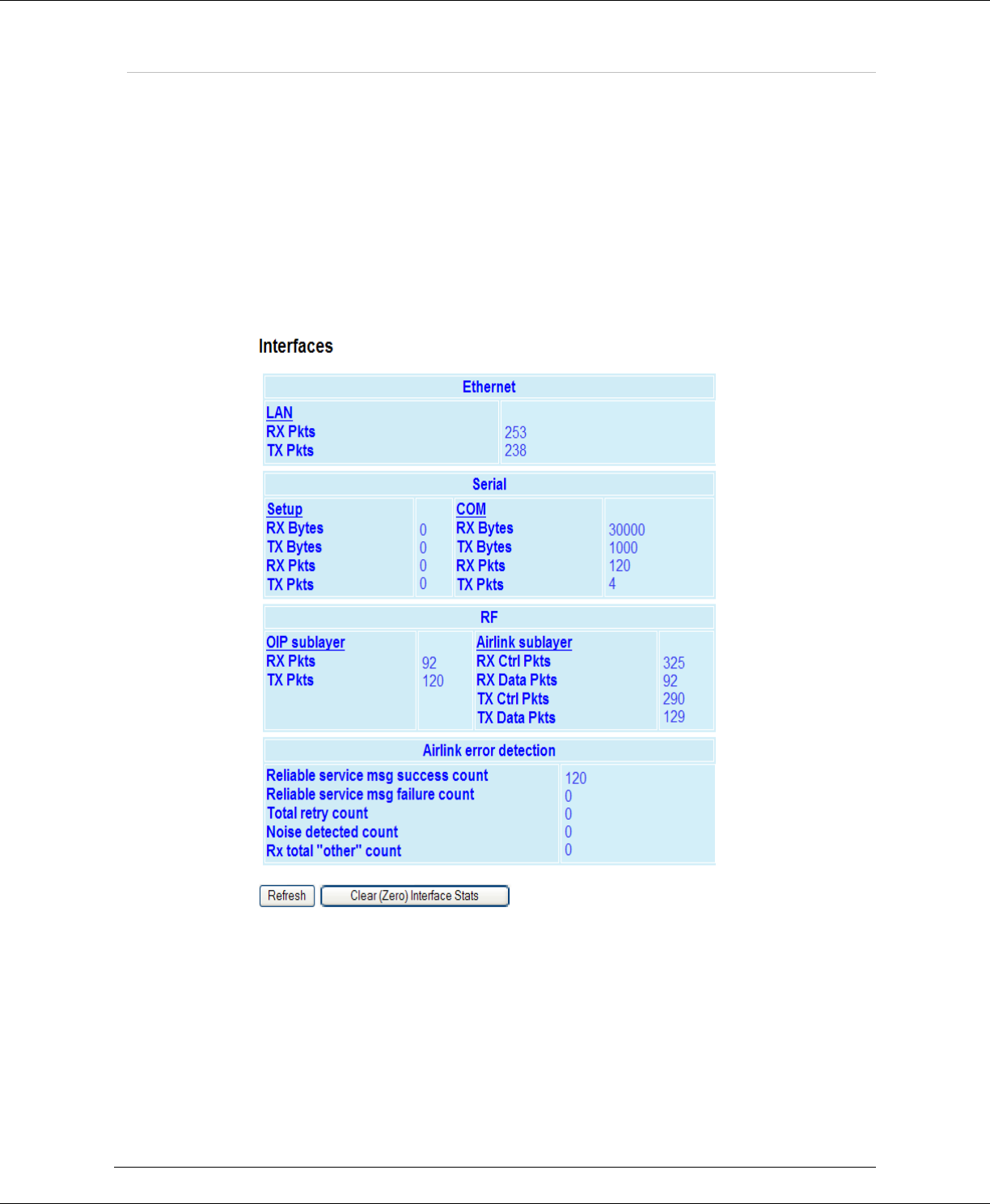
#9 ViPR User Manual_Rev2.doc Page 73
STATISTICS
The statistics page reports the amount of traffic received and sent by each of the three
interfaces: Ethernet, Serial, and RF. This page also reports statistics gathered from the
airlink that can indicate the quality of the RF links.
Note: All definitions given below use the following convention:
RX (or Input) = data received from a lower network layer
TX (or Output) = data transmitted to a lower network layer
Cycling power to the ViPR or pressing the "Clear (Zero) Interface Stats" button will reset all
statistics to zero.
Figure 9.1 – Statistics Web Page
ETHERNET (LAN)
RX Pkts (LAN)
The total number of input packets received by the Ethernet interface.

#9 ViPR User Manual_Rev2.doc Page 74
TX Pkts (LAN)
The total number of output packets transmitted by the Ethernet interface.
SERIAL
RX Bytes
The total number of input bytes received by the port.
TX Bytes
The total number of output bytes transmitted by the port.
RX Pkts
The total number of input packets received by the port.
TX Pkts
The total number of output packets transmitted by the port.
RF
RX Pkts (OIP Sublayer)
The total number of input packets received by RF-OIP interface.
TX Pkts (OIP Sublayer)
The total number of output packets transmitted by RF-OIP interface.
RX Ctrl Pkts (Airlink Sublayer)
The total number of control packets received over-the-air. These packets may be RTS/CTS
messages or RF Acknowledgements.
RX Data Pkts (Airlink Sublayer)
The total number of input data packets received over-the-air.
TX Ctrl Pkts (Airlink Sublayer)
The total number of output control packets transmitted over-the-air. These packets may be
RTS/CTS messages or RF Acknowledgements.
TX Data Pkts (Airlink Sublayer)
The total number of output data packets transmitted over-the-air.
AIRLINK ERROR DETECTION
Airlink parameters provide the user with RF link quality information.

#9 ViPR User Manual_Rev2.doc Page 75
Reliable Service Msg Success Count
The number of service messages that succeeded. RF Acknowledgements must be enabled
in order to generate a Reliable Service Message. RF Acknowledgements can be configured
under Setup (Advanced) D IP Optimization (Router Mode Only).
Reliable Service Msg Failure Count
The number of service messages that failed.
Total Retry Count
The total number of retries for service messages.
Noise Detected Count
The number of noise (non ViPR carrier) detected instances above the carrier sense level. If
the Noise detected count is high, it may be an indication the Carrier Sense Threshold should
be raised.
RX Total "Other" Count
This is the total number of messages the ViPR overheard that were intended for another
station. These messages are discarded.
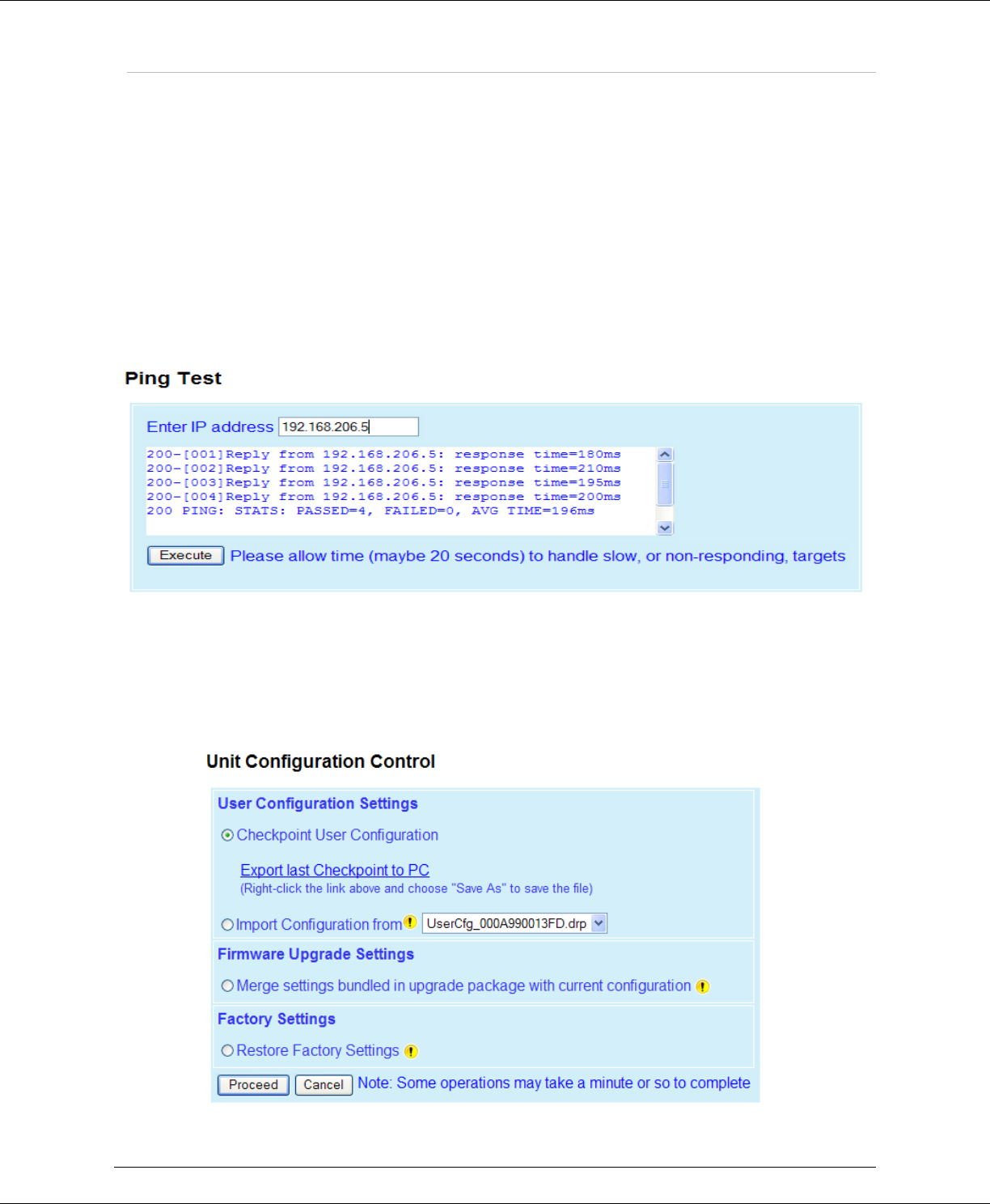
#9 ViPR User Manual_Rev2.doc Page 76
MAINTENANCE
PING TEST
The ping command is a network tool used to test whether a particular host is reachable on
the IP network. It works by sending an ICMP packet (echo request) to a target host and
listening for the ICMP echo response. Ping estimates the round trip time (in ms) and records
any packet loss.
a. Enter IP Address
b. Press EXECUTE button
c. Allow up to 20 seconds to handle slow, or non-responding targets
Figure 10.1 – Maintenance
D
Ping Test Web Page
UNIT CONFIGURATION CONTROL
The Config Control web page grants the user access to the configuration settings below. A
user must click “Proceed” to execute the commands available on this screen.
Figure 10.2 – Maintenance
D
Config Control Web Page

#9 ViPR User Manual_Rev2.doc Page 77
User Configuration Settings
Checkpoint User Configuration
Select “Checkpoint User Configuration” radio button to create a checkpoint of all the user
configurable settings in the ViPR. Click “Proceed” to save these settings into the
configuration file. The configuration settings of the ViPR will be written to the
UserCfg_macaddress.drp file (where macaddress is the ViPR’s Ethernet MAC address.
Example: UserCfg_000A990013FD.drp). The new configuration set overwrites previously
saved settings.
The configuration file contains all user settings that can be configured on any of the web
pages as well as several additional parameters that can only be configured using the CLI
(command line interface.) Also, portions of the Routing Table and portions of the Neighbor
Table are saved into the configuration file as described below. The ViPR’s password is not
saved into nor restored from the configuration file.
Neighbor Table
Dynamic Neighbors: Not Saved. Dynamic neighbors are created and deleted
automatically by the neighbor discovery algorithm and are not saved in the configuration
file.
Locked Neighbors: Saved and Restored. Locked neighbors are created automatically by
the neighbor discovery algorithm but are not deleted automatically. These entries are
saved into the configuration file.
Static Neighbors: Saved and Restored. Static neighbors are created manually by the
user. These entries are saved into the configuration file.
Routing Table
Connected Route: Not Saved. These routes point to a direct physical connection on the
Ethernet port and are created dynamically based on the ViPR’s Ethernet IP address.
Proprietary Route: Not Saved. Routes added due to an entry in the neighbor table.
These routes will be automatically recreated for each remote ViPR in the neighbor table.
Static Route: Saved and Restored. Static routes are created manually by the user. These
routes are saved into the configuration file.
Export Config from Last Checkpoint to PC
Right Click this link, then select “Save Target As” to save the configuration file to a PC. A
save dialog box will appear. Select the file name and folder to save the configuration file to
and click save.
The configuration file may be renamed, if desired, (must keep the .drp extension) then
reloaded back into the original ViPR or into another ViPR by using an FTP client program.
Do not load more than 5 separate configuration files into a single ViPR. Loading many
configuration files into a ViPR may use up an excessive amount of memory and may cause
the ViPR to malfunction. After saving the configuration file back into the ViPR with an FTP
Client, select "Restore User Configuration Checkpoint" and follow the instructions below.
Restore User Configuration Checkpoint
To restore a user configuration file, click the "Restore User Configuration Checkpoint" radio
button. The drop down combo box will show all the .drp files (configuration files) in the
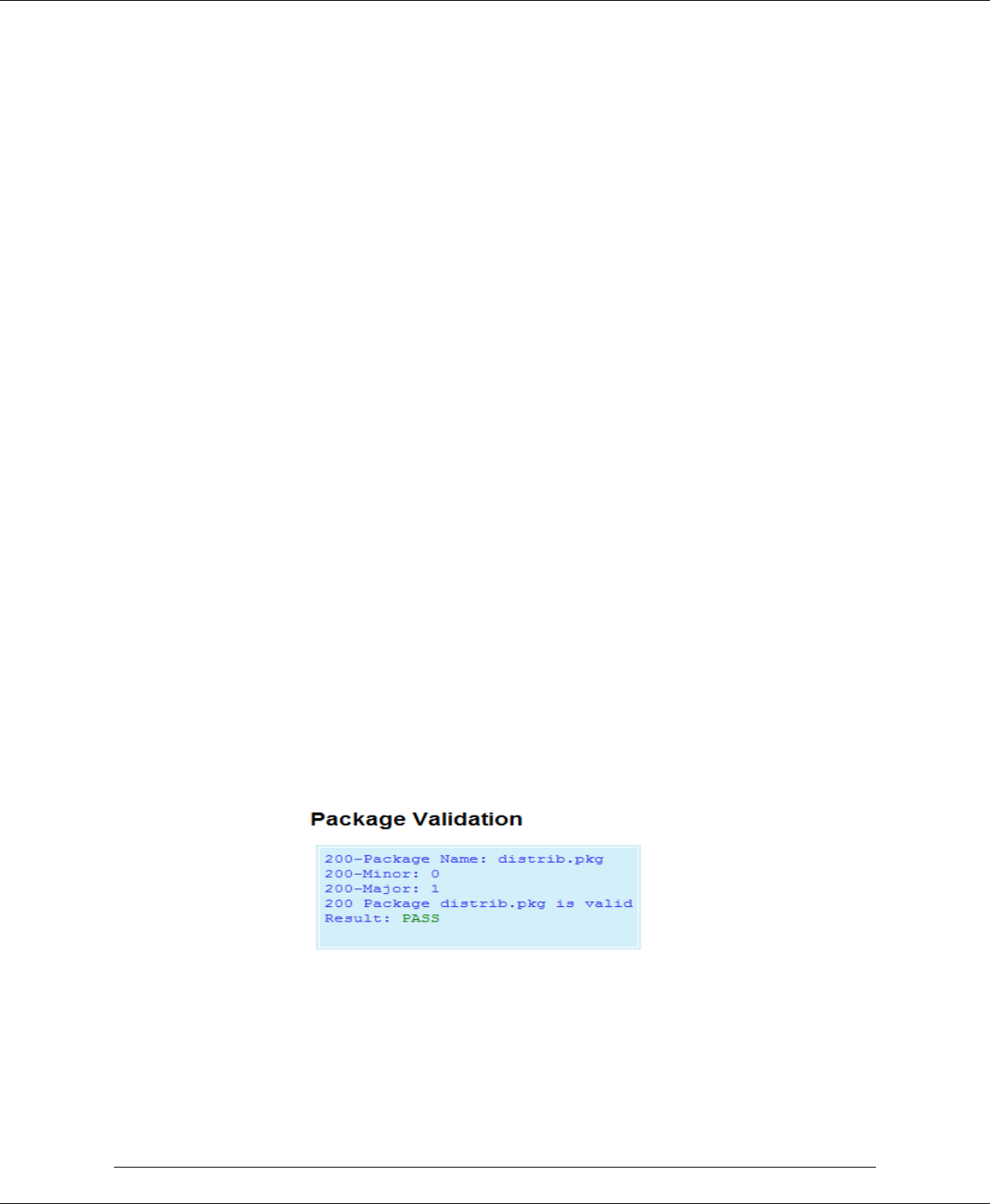
#9 ViPR User Manual_Rev2.doc Page 78
ViPR. Select the configuration file to load and click on "Proceed". Click "Save Config" then
"Reset Unit" to complete the process and store these settings to the unit.
Firmware Upgrade Settings
Merge settings bundled in upgrade package with current configuration - merges upgraded
settings with the current configuration. Select the "Merge Settings..." radio button and click
"Proceed". Click "Save Config" then "Reset Unit" to complete the process.
Note: The "firmware upgrade" process will replace the ViPR existing configuration with the
firmware bundled with the upgrade package.
Factory Settings
Restore Factory Settings restores all settings to the default factory configuration.
If at any time you wish to restore factory settings, simply select the "Restore Factory
Settings" radio button and click "Proceed". Click "Save Config" then "Reset Unit" to
complete the process.
Important note:
Activating "Restore Factory Settings" will reset the IP address of the unit.
Review your record of the original ViPR factory settings before proceeding with the Restore
Factory Settings.
PACKAGE CONTROL
The Package Control web page is used for verifying a field upgrade of the ViPR radio modem
firmware. If the installation was successful, the web page will indicate "Pass". If the
installation is unsuccessful, the web page will indicate "Fail" and an error message will
specify which files are missing/corrupt.
If an upgrade problem arises, click the "Package Control" once more and have the results
available when contacting CalAmp Technical Support.
The Package Validation window is for reference only. No user configuration is available on
this page.
Figure 10.3 – Maintenance
D
Package Control Web Page
NET TESTS
The Net Tests web page allows the user to test the reliability of the RF link. Test packets
are generated and transmitted with a special ViPR specific test bit set in the header to
identify the packet as a test packet. The receiving ViPR listens for these test packets and
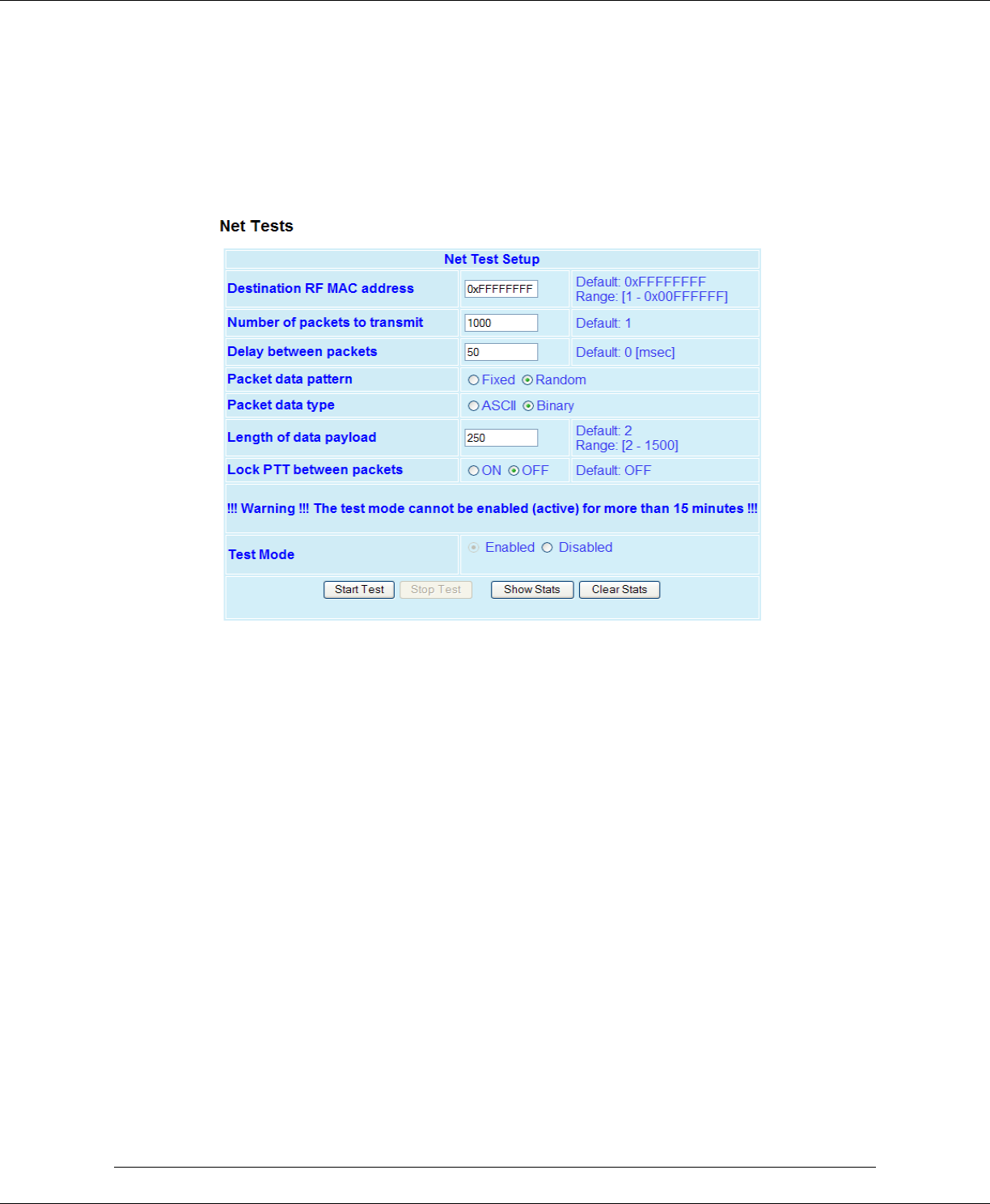
#9 ViPR User Manual_Rev2.doc Page 79
counts the number of packets it receives successfully. The test results can be viewed on the
receiving ViPR.
Warning: When the unit is in test mode, it will not respond to RF activity from
other ViPR units. Test mode cannot be enabled (active) for more than 15 minutes.
After 15 minutes, test mode will be automatically disabled and normal
communications will resume.
Figure 10.4 – Maintenance
D
Net Tests Web Page
Net Test Setup
Destination RF MAC address
The user enters the RF MAC address of the ViPR unit they wish to connect to. Format
0x00000FD4. The default RF MAC address is 0xFFFFFFFF, which will send a broadcast
packet to all ViPRs listening for the test packets.
Number of packets to transmit
This is the total number of packets transmitted during the test.
Delay between packets
The user can enter a delay in milliseconds between the packets being sent. Note: If a delay
is not present between packets, it may appear the transmitter does not unkey and is only
sending one long continuous packet.
Packet data pattern
The user can choose between a Fixed or Random data pattern. Fixed data is highly
compressible; random data is not. Note: The ViPR has a data compression algorithm that
compresses the data before transmitting it.

#9 ViPR User Manual_Rev2.doc Page 80
Packet data type
Choose from ASCII or Binary (Hex) formats. ASCII data type is also highly compressible.
Note: Random Binary data best simulates PLC SCADA data.
Length of data payload
Enter the length of the data to be transmitted. Note: A typical SCADA value would be
between 10 to 250 bytes. The maximum value is equal to the MTU set in each ViPR unit.
Lock PTT between packets
If the "Off" option is chosen and enough delay has been added between packets, the ViPR
will stop transmitting between packets. If "On" is selected the ViPR will continuously
transmit between packets.
Test Mode
Clicking the "Enable" radio button will put the ViPR into test mode and the ViPR will
immediately begin listening for test packets transmitted from a remote unit. As the unit
receives test packets, the statistics will be updated. The statistics can be viewed by clicking
the "Show Stats" button. Click the "Start Test" button to have the ViPR start transmitting
test packets to a remote unit.
Start Test
Starts the test. When this button is clicked, the ViPR will begin transmitting test packets.
The “Start Test” button does not need to be clicked on the receiving ViPR. The ViPR will
start listening for test packets as soon as the Test Mode “Enabled” radio button is selected.
Stop Test
Stops the test. When this button is clicked, the ViPR will stop transmitting test packets.
Show Stats
Clicking the "Show Stats" button will cause a pop up window that displays the test statistics.
Note: The user should use this feature on the receiving unit to monitor the Net test. This
window will also display the RSSI value from the transmitting unit.
Clear Stats
Clears the results of the test.
Net Test Results
Click on the “Show Stats” button to display the test results. A typical results page with the
results from the transmitting ViPR is shown below. The left column lists current results.
The right column shows results from the last time the stats were refreshed.
Stats from Transmitting Unit
In this example, 1000 of 1000 packets were successfully transmitted. (Note: This doesn’t
imply how many packets were successfully received. Check the stats on the receiving ViPR
for this information.)
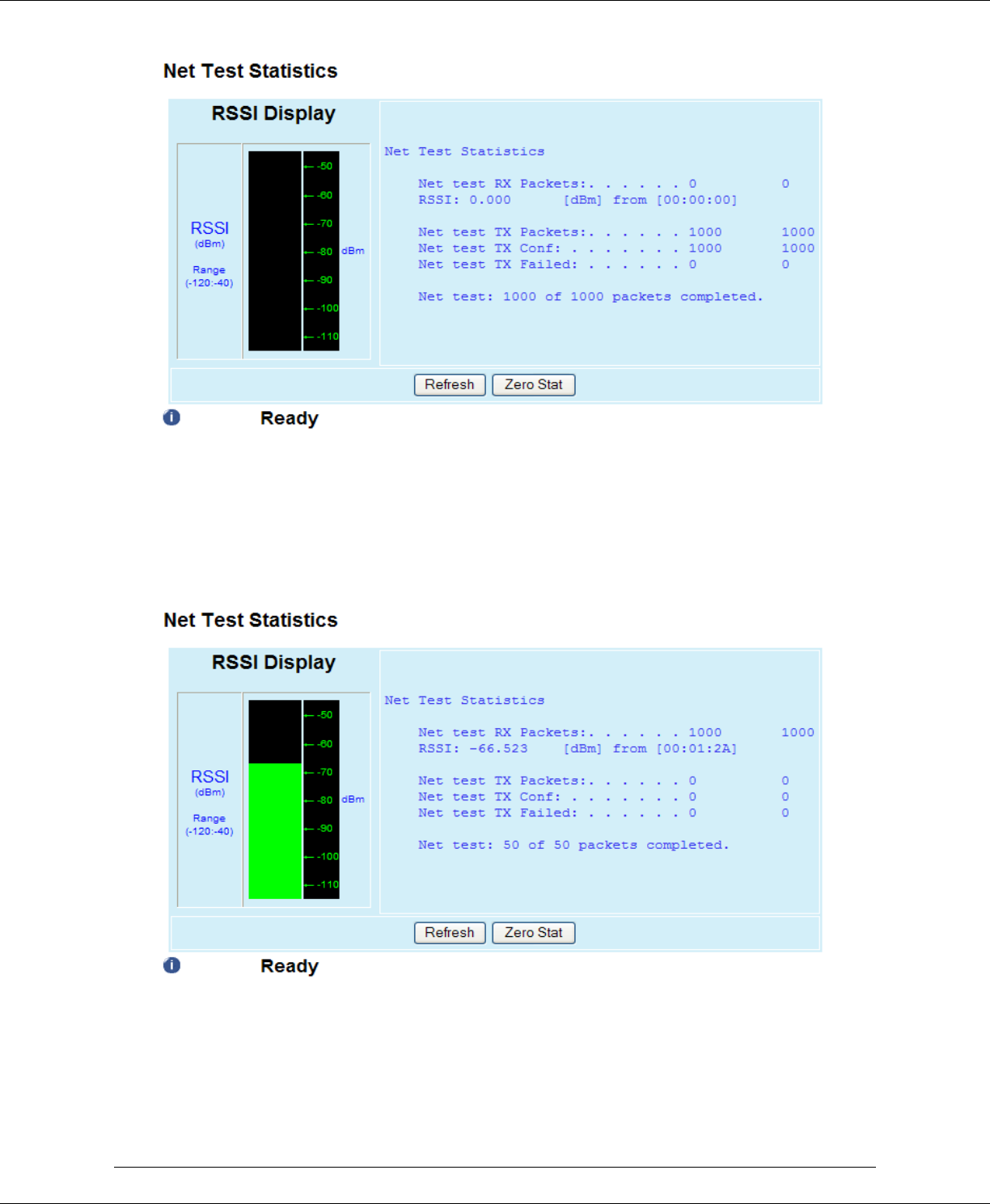
#9 ViPR User Manual_Rev2.doc Page 81
Figure 10.5 – Net Test Statistics (Transmitting Unit) Web Page
Stats from Receiving Unit
In this example, 1000 test packets were successfully received and the RSSI from unit
00:01:2A (the sending ViPR) was –66.523 dBm.
Figure 10.6 – Net Tests Statistics (Receiving Unit) Web Page
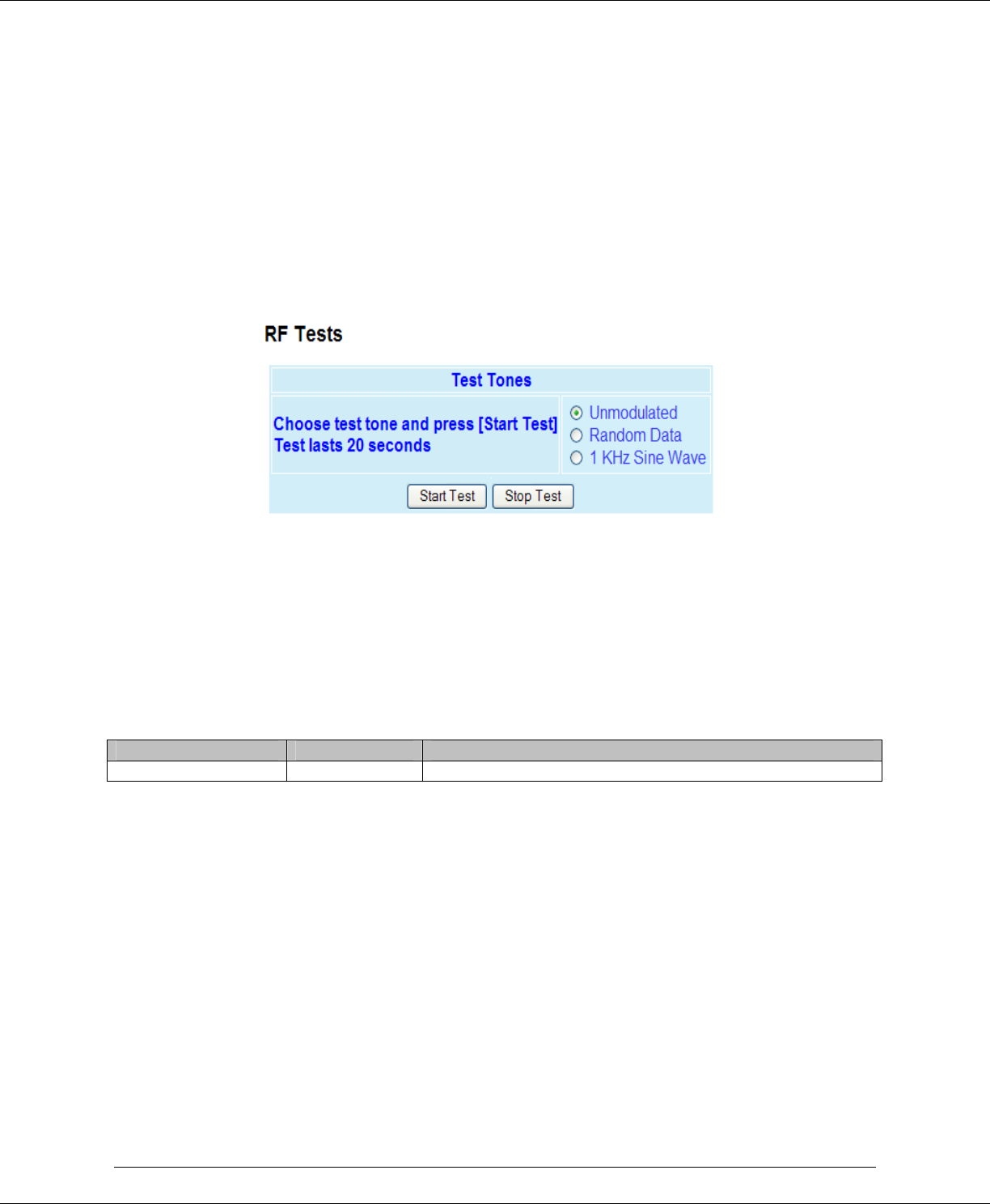
#9 ViPR User Manual_Rev2.doc Page 82
RF TESTS
Test Tones
Allows the user to choose from Unmodulated, Random Data, and 1 KHz Sine Wave test
tone.
The test tone will transmit for 20 seconds when the "Start Test" button is clicked. The "Stop
Test" button will end the test immediately. Note: This test may cause other ViPRs to stop
transmitting for the duration of the test. ViPR units have a feature that checks if another
carrier (RX frequency signal) is present. If a carrier is detected, the ViPR will not transmit
until the carrier is no longer present.
Figure 10.7 – Maintenance
D
RF Tests Web Page
FEATURE OPTIONS
The Feature Option web page lists the available add on features and shows which features
are currently installed in the ViPR.
Option # Name Description
009 SNMP Allows SNMP agent activation on the unit.
Table 10.1 – Available Feature Options
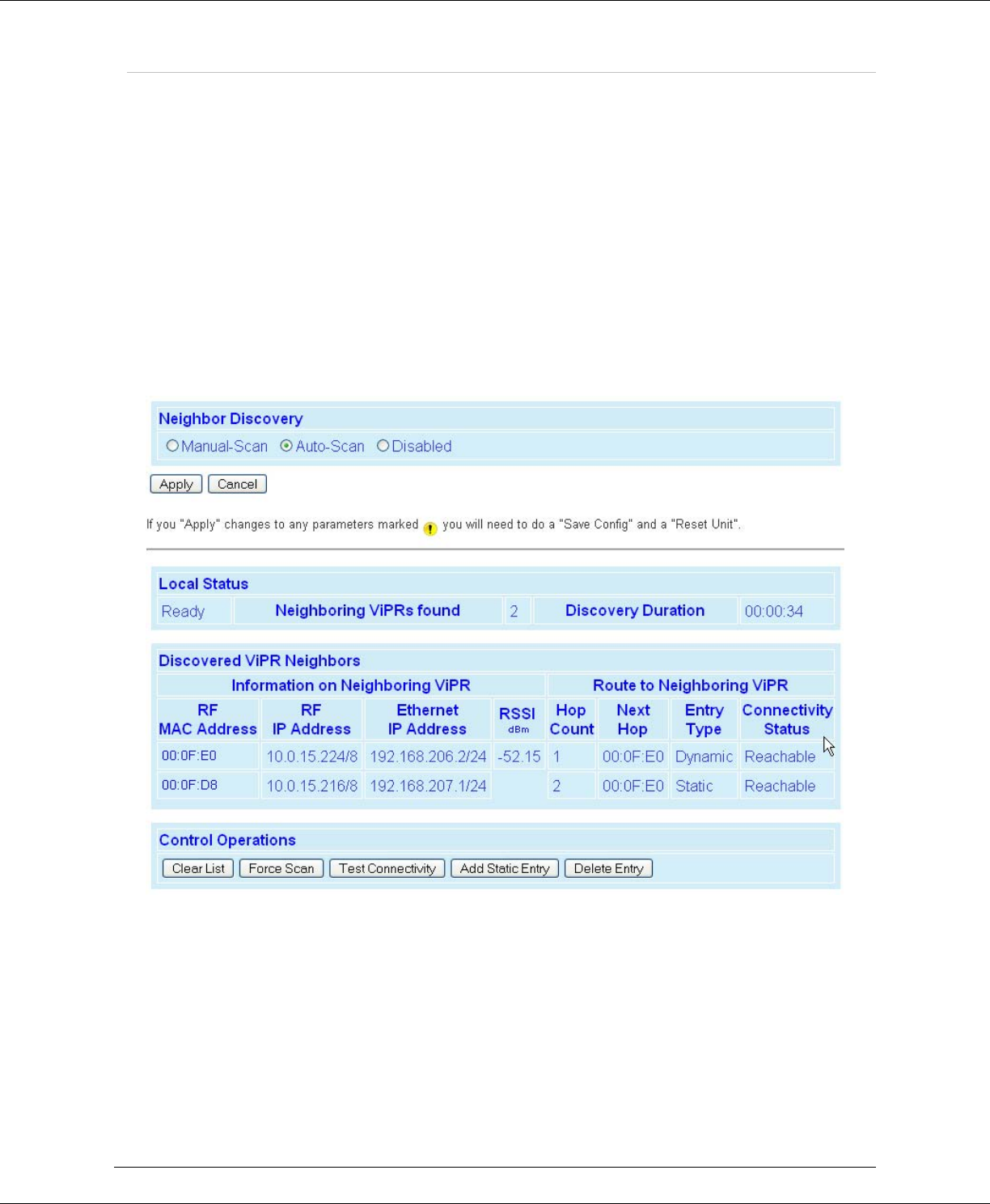
#9 ViPR User Manual_Rev2.doc Page 83
N
NE
EI
IG
GH
HB
BO
OR
R
M
MA
AN
NA
AG
GE
EM
ME
EN
NT
T
Each unit is equipped with a powerful neighbor discovery module whose purpose is to detect
all units in the RF network and add all necessary IP routes required to reach neighboring
units. The neighbor discovery module only operates when the unit is configured in
router mode. ViPRs discover other ViPRs by sending and receiving neighbor discovery
control messages.
There are three modes of operations (Manual-Scan, Auto-Scan, Disabled); five states of
operations (Ready, Scanning for Neighbors, Disabled, Saving Neighbor Table, Testing
Connectivity); and three types of Neighbor Table entries (Static, Dynamic, Locked).
USER INTERFACE
The User Interface grants access to ViPR Neighbor Management options and displays
information about local status, discovered neighbors, and control operations.
FIGURE 11.1 - NEIGHBOR DISCOVERY USER INTERFACE
NEIGHBOR DISCOVERY (MODES)
Neighbor Discovery mode must be configured the same for each ViPR in the network.

#9 ViPR User Manual_Rev2.doc Page 84
Manual-SCAN
Manual-Scan is the default mode of operation. The ViPR starts in the “Ready” state. In the
“Ready” state, the unit is quiet (no neighbor discovery control messages are sent). If the
user presses the “Force Scan” button, the unit goes into the “Scanning for Neighbors” state.
If other units are in the "Scanning for Neighbors" state, the unit will automatically be
triggered to go into the "Scanning for Neighbors" state.
In the "Scanning for Neighbors" state, the ViPR is learning about other units and the other
units are learning about this unit. The unit goes from the "Scanning for Neighbors" state to
the "Saving Neighbor Table" state when it doesn’t learn anything new for a given amount of
time.
In the "Saving Neighbor Table" state, the content of the neighbor table is saved in nvram
(nonvolatile ram). If the unit reboots, the content of the neighbor table is restored from the
nvram.
The unit goes from the "Saving Neighbor Table" state to the "Ready" state.
Auto-SCAN
In the Auto-Scan mode, ViPR begins "Scanning for Neighbors". In the "Scanning for
Neighbors" state, ViPR discovers other ViPR units in the network and other ViPR units learn
about the ViPR initiating the scan.
ViPR goes from "Scanning for Neighbors" state to "Ready" state when it doesn’t discover
another ViPR for a given amount of time.
In "Ready" state, ViPR will generate a “keep alive” packet periodically. In "Ready" state,
ViPR performs broken link detection. ViPR is monitoring the “keep alive” packets of other
ViPRs (1 hop away). ViPR knows the interval period for other ViPRs generating their “keep
alive” packets. If ViPR (A) fails to receive four “keep alive” packets in a row from ViPR (B),
ViPR (A) removes ViPR (B) from its neighbor table and goes into the "Scanning for
Neighbors" state.
If a user presses the “Force Scan” button, ViPR goes into the "Scanning for Neighbors"
state. If other ViPRs are in the "Scanning for Neighbors" state, ViPR will automatically go
into "Scanning for Neighbors" state.
Note: Care should be taken when selecting Auto-Scan mode for the permanent operating
mode of a ViPR network. Auto-Scan mode could generate a large number of neighbor
discovery control messages in a large ViPR network
Disabled
In the disabled state, ViPR does not send neighbor discovery packets, nor does it process
neighbor discovery packets generated by other ViPRs. The user can enter static entries in
the Neighbor Table.
LOCAL STATUS
Local Status displays operating state information about the local discovery module. The
device shown in Figure 11.2 is currently Scanning for Neighbors. See below for additional
Discovery States.
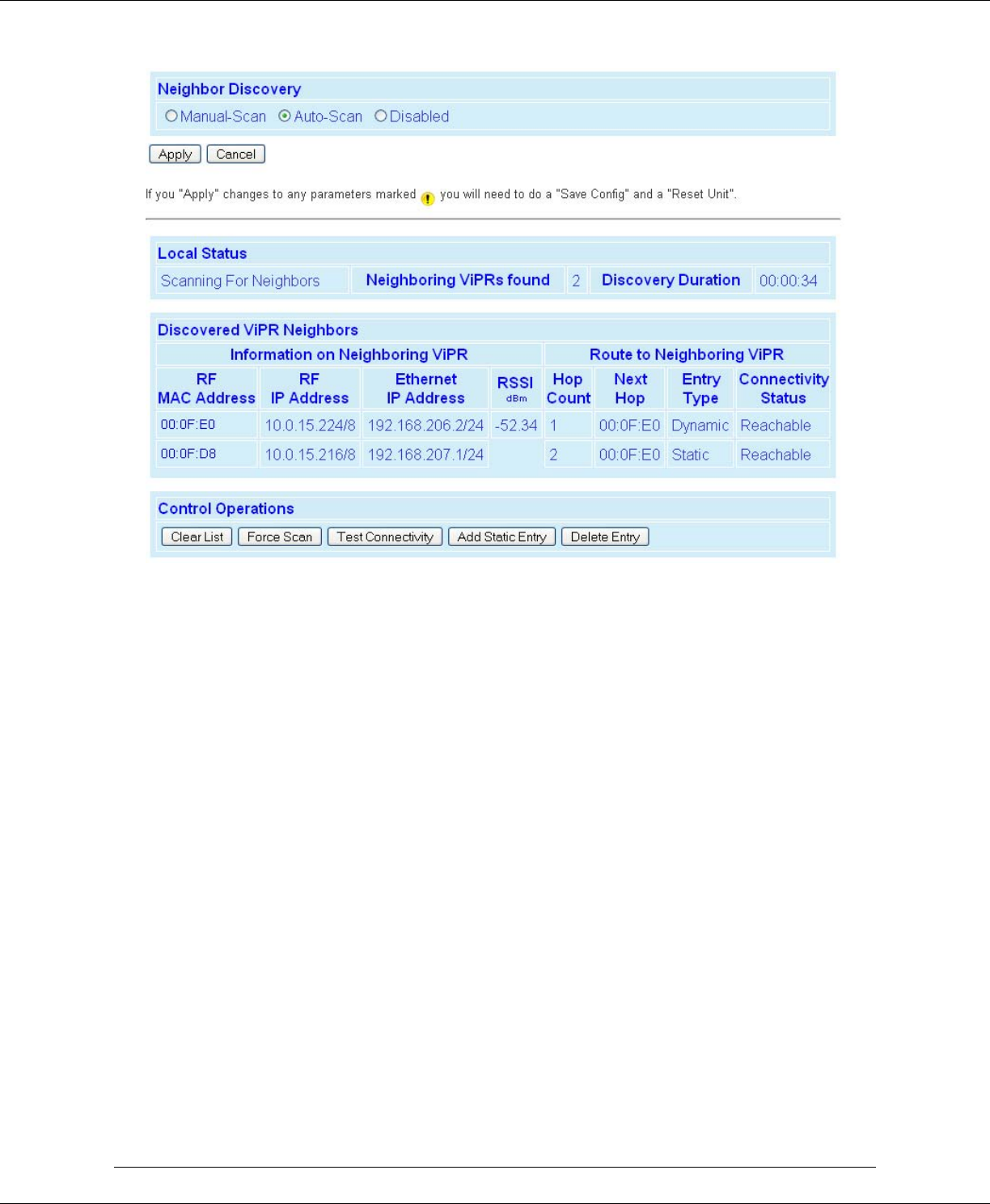
#9 ViPR User Manual_Rev2.doc Page 85
Figure 11.2 ViPR “Scanning for Neighbors”
Neighbor Discovery States
Ready
The neighbor discovery module is in a “Ready” state when it is not scanning for other units.
If the ViPR is operating in Manual-Scan, it does nothing.
If the ViPR is operating in Auto-Scan, it monitors the “keep alive” packets of other units and
sends its own “keep alive” packet periodically.
Scanning For Neighbors
The neighbor discovery module is trying to learn about other units. Other units are learning
about this unit.
Saving Neighbor Table
In this state, the ViPR is saving all neighbor entries of type "Dynamic" into
Nvram. When the save is complete, all these entries are now of type "Locked".
This state only occurs when the neighbor discovery module operates in
Manual-Scan mode.

#9 ViPR User Manual_Rev2.doc Page 86
Testing Connectivity
The neighbor discovery module is verifying the ViPR units in the neighbor table are
reachable by sending them an alive-request and waiting for an alive-response. Round trip
time must not exceed 10 seconds. The alive-request is only sent once.
Disabled
The neighbor discovery module is disabled.
Neighboring ViPRs Found
Displays the number of ViPRs discovered.
Discovery Duration
Discovery Duration is the time it took for the ViPR unit to complete the neighbor discovery
learning process.
DISCOVERED VIPR NEIGHBORS
Each entry in the Neighbor Table represents a remote ViPR. See Figure 11.1: Discovered
ViPR Neighbors.
Information on Neighboring ViPRs
RF MAC Address
Identifies each entry uniquely. The user can click the RF MAC ADDRESS entries to display
the details of the selected device in the Neighbor Node Detail window.
RF IP Address and Ethernet IP Address
Used to build the routing table.
Discovery Mode
Represents the Mode of operation of the remote Unit. See 11.2 for more information on
Neighbor Discovery Modes.
Neighbor Table Entry Type
Static
This entry has been defined by the user. The entry type can only be removed by the user.
This entry cannot be replaced by a "Dynamic" or "Locked" entry.
"Static" neighbor entries can be added in any neighbor discovery mode.
If the user presses the “Save” button from the web page, all "Static" neighbor entries are
saved in nvram. They are recovered after a reboot.

#9 ViPR User Manual_Rev2.doc Page 87
Dynamic
A "Dynamic" neighbor entry is one that has been learned by the neighbor discovery
algorithm. It can be updated or deleted by the neighbor Discovery algorithm when it
detects changes in the topology.
Locked
A "Locked" neighbor entry is a "Dynamic" neighbor entry saved into nvram. The "Locked"
neighbor entry behaves like a "Dynamic" neighbor except it is saved into nvram and will be
recovered after a reboot.
Route to Neighboring ViPRs
Hop Count and Next Hop
Indicates the route the remote ViPR can be reached - when HOP COUNT is 1, the device can
be reached directly. When HOP COUNT is more than 1, it can be reached by passing though
another ViPR as identified by the NEXT HOP field.
CONTROL OPERATIONS
Clear List
Clears the entries in the list and routing tables. If Auto-Scan is enabled, the neighbor list
will be repopulated automatically. If Manual-Scan is enabled, the neighbor list can be
repopulated by clicking the “Force Scan” button.
Force Scan
Starts the Scanning for Neighbors process.
Test Connectivity
Pings each ViPR in the list to ensure an RF path between the units.
Add Static Entry
By pressing the “Add Static Entry” button, a popup appears and the user can edit the static
neighbor entry. When a Static Neighbor entry is created, all routes to that neighbor are
created. User must then press “Apply” and “Save Config” buttons for entry to be added to
the network Routing Table.
NOTE:
Static Entries can replace dynamic entries.
Static neighbor entries do not age out.
Static neighbor entries are stored even when neighbor discovery is disabled.
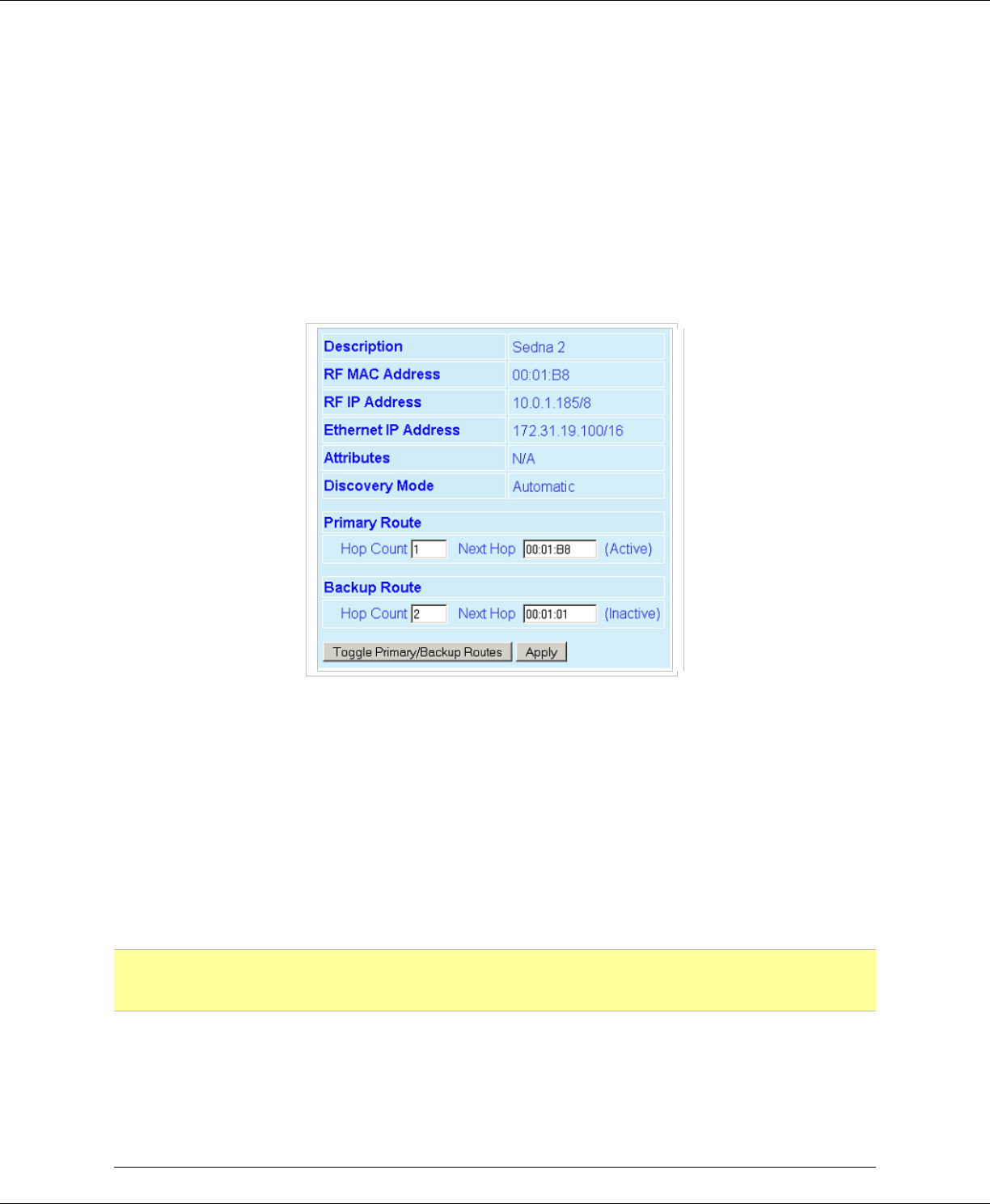
#9 ViPR User Manual_Rev2.doc Page 88
Delete Entry
By pressing the “Delete Entry” button, a popup appears and the user can specify the
neighbor entry to be deleted. The neighbor entry can be a dynamic or static entry.
The neighbor discovery module updates ViPR’s Routing Table when entries are added or
deleted from the Neighbor Table. See Section 7.5: IP Routing for more information.
PRIMARY AND BACKUP ROUTE SELECTION
If the user clicks on the RF MAC Address of a Unit in the neighbor table, the Neighbor Node
Detail window appears with a full description of the selected device.
Figure 11.3 - Neighbor Node Detail Window
The Neighbor Discovery module will keep track of two routes determined by the shortest
hop count to any given ViPR - the primary route and the backup route (if a route is
detected). Users can override the Neighbor Discovery selection by pressing the “Toggle
Primary/Backup Routes” button. The backup route will become the active route.
In certain applications, it may be necessary to edit Primary and/or Backup routes. Select
the desired unit; enter the RF MAC Address in the appropriate NEXT HOP field and the Hop
Count to reach that unit. Then press the “Apply” button. If a route from ViPR #1 to ViPR
#3 goes through ViPR #2. The route selected must be edited in ViPR #1 and ViPR #3. The
routing path must use the same ViPRs going out and coming back.
IMPORTANT!
If the user changes the selection made by the Neighbor Discovery module, the neighbor
entry will be changed from a dynamic entry to a static entry.
NETWORK STATUS
Network Status displays the Station Status, Neighbor Discovery (ND) mode and Command
Status for each RF-MAC address in the Neighbor List. The commands are generated on the
Neighbor Management Maintenance page. If the command fails, the status will indicate
either failure or Response Timeout
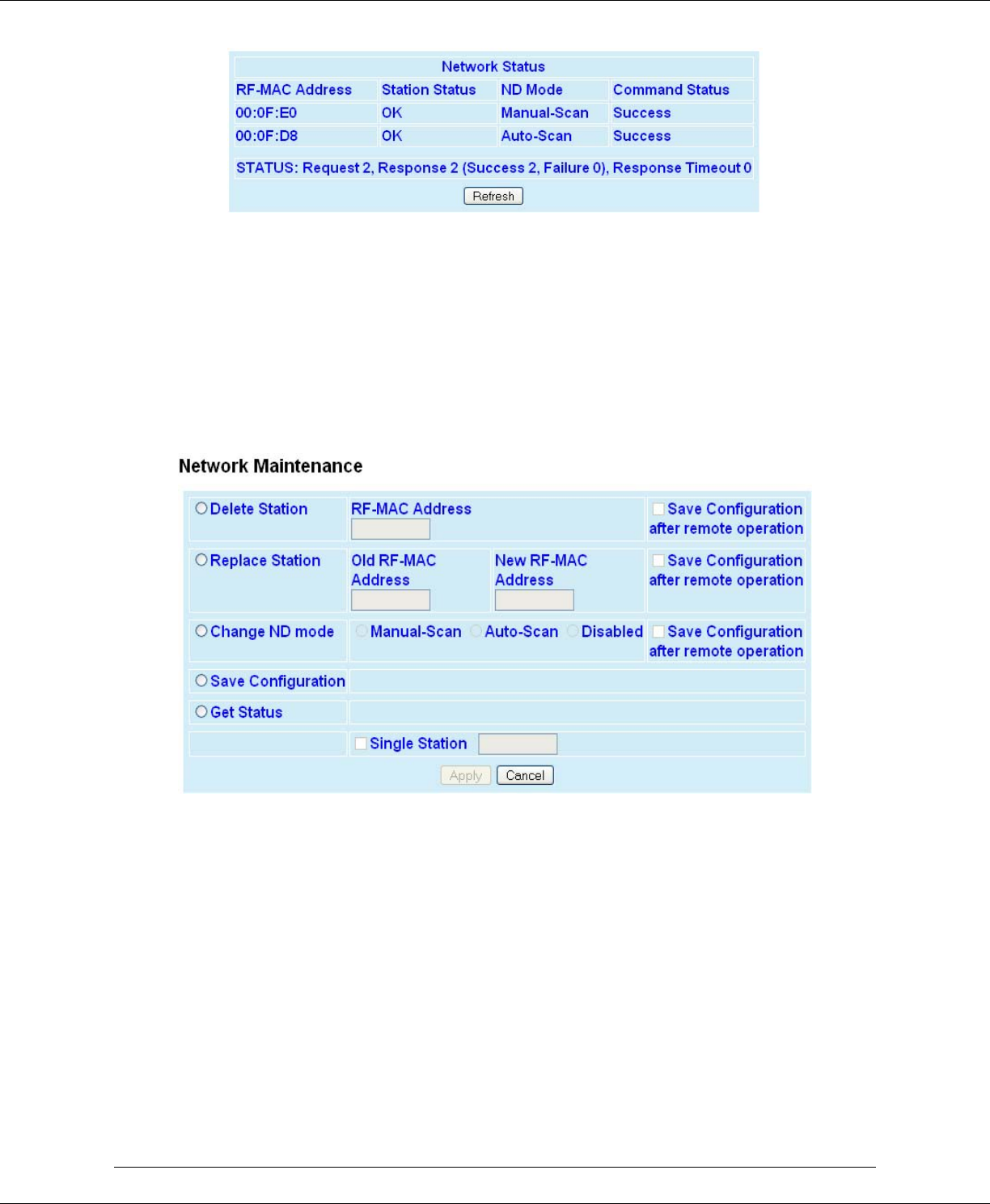
#9 ViPR User Manual_Rev2.doc Page 89
Figure 11.4 Network Status
To query the ViPR for the status of all its neighbors, select the Get Status option then press
the "Apply" button under Network Management -> Maintenance.
MAINTENANCE
The Network Maintenance page allows the user to make changes to a single ViPR unit or the
entire ViPR network. This allows the user to make changes to the remote units' neighbor
tables.
Figure 11.5 Network Maintenance
Delete Station
The user enters the RF MAC Address of the station to be deleted from the Neighbor Table of
all ViPRs in the network.
Replace Station
The user enters the old RF MAC Address (the unit to be replaced) and the new RF MAC
Address (that will replace the old ViPR). This will update the Neighbor Table of all the ViPRs
in the network.
Change ND mode
The user can change the Neighbor Discovery mode of all ViPRs in the network to Manual-
Scan, Auto-Scan, or Disable.

#9 ViPR User Manual_Rev2.doc Page 90
Save Configuration
This will send a save configuration command to all ViPRs in the network.
Get Status
This will send a "Get Status" command to all ViPRs in the network. The status will be
displayed on the Network Management -> Status page.
Single Station
Single Station allows the user to enter the single RF MAC Address of the ViPR module
commands will be sent to. If this option is selected, the command will be sent to an
individual ViPR instead of being sent to all ViPRs in the Network.
Apply
The commands will not be sent until the "Apply" button is clicked.
RECOMMENDED NEIGHBOR DISCOVERY MODES OF OPERATIONS
CalAmp recommends Auto-Scan be limited to ViPR networks of two to ten units. If Auto-
Scan mode is used, be aware the Neighbor Discovery learning process may slow responses
in SCADA networks from remote units or capture the RF channel so remotes cannot respond
to a Master.
Manual-Scan is recommended for most projects.
D
Di
is
sa
ab
bl
le
ed
d
i
is
s
r
re
ec
co
om
mm
me
en
nd
de
ed
d
i
in
n
p
pr
ro
oj
je
ec
ct
ts
s
w
wh
he
er
re
e
t
th
he
e
c
cu
us
st
to
om
me
er
r
d
do
oe
es
s
n
no
ot
t
w
wa
an
nt
t
R
RF
F
p
pa
at
th
hs
s
t
to
o
d
de
ev
vi
ia
at
te
e
f
fr
ro
om
m
R
RF
F
e
en
ng
gi
in
ne
ee
er
re
ed
d
(
(R
RF
F
S
Si
it
te
e
S
Su
ur
rv
ve
ey
y
c
co
om
mp
pl
le
et
te
ed
d)
)
p
pa
at
th
hs
s.
.NETWORK OPTIMIZATION
MAXIMIZING TCP/IP THROUGHPUT
After optimizing the Airlink, if there appears to be an unexplained speed loss, you can
attempt to maximize TCP/IP throughput.
TCP/IP throughput can be a challenge to measure as performance is related not only to the
RF link, but how well flow-control is implemented in the TCP/IP stack and each application’s
design. ViPR has been optimized with this in mind. When the TX/RX LED flashes green or
red, this indicates data is moving across the network. It also indicates (by the LED OFF
periods) when data is not moving across the RF network at full rated speed. OFF periods
indicate the application has not presented data to the ViPR radio modem.
Using different client/server combinations or applications may show improvements. For
instance, one FTP server may work 30% faster than another; the buffer management is
quicker to respond or has bigger message buffers – yet run at nearly the same speed over a
pure Ethernet (no RF) link.
Network Address Translation (NAT), payload data compression, and encryption have little
effect other than adding a small latency to the flow of traffic.

#9 ViPR User Manual_Rev2.doc Page 91
MAXIMIZING THROUGHPUT WITH A WEAK RF LINK
Further performance optimization can be done via the User Interface Setup web pages.
Fundamental adjustments, described in the following paragraphs, can be changed singularly
or in conjunction with each other.
Use Router Mode with RF Acknowledgements Enabled
Selecting Router mode and enabling RF Acknowledgements is highly recommended when
running over a weak RF link. This mode ensures several levels of retry mechanisms are at
work, each optimized to minimize TCP flow control delays or prevent a dropped TCP/IP link.
It requires some IP route planning to and from ViPR units, but is well worth the increase in
link stability over the simple Bridge mode.
RF Acknowledgements can be enabled on ViPR web pages under Setup (Advanced) D IP
Optimization. RF Acknowledgements must be enabled or disabled on all ViPRs in the
network.
ViPRs are tested for BER at the factory with the optimizations described above. The units
are configured for Router Mode, RF Acknowledgements are enabled, MAC retries are set for
2, and OIP retries are set for 2.
Reduce RF Network Bit Rate
ViPR has two speeds of operation available for each of the three channel bandwidths. The
faster speeds in each bandwidth utilize 4-level FSK (frequency shift keying.) The slower
speeds in each bandwidth utilize 2-level FSK, yielding a higher Signal-to-Noise level
resulting in better sensitivity. Normally the system is able to utilize the faster bit rate.
However, if the system has a very low signal level (-95 dBm or less) or the RF signal levels
are close to an elevated noise floor level, you can try running at a slower over-the-air speed
for the system’s bandwidth. It may result in better overall performance.
Increase OIP and MAC Retries Limit
OIP retries and MAC retries are only available in Router mode. The MAC Retry Limit is
normally set to 1 and the OIP Retry Limit is normally set to 2. Gradually increasing these
limits (up to 3 in extreme cases), may provide a slower, but more reliable link impossible
with weak signals. Use in conjunction with the slower over-the-air network bit rate for the
system’s bandwidth.
The number of MAC retries can be configured on the ViPR’s web pages under Setup
(Advanced) D RF Optimizations. The number of OIP retries can be configured under Setup
(Advanced) D IP Optimization.

#9 ViPR User Manual_Rev2.doc Page 92
U
UP
PG
GR
RA
AD
DI
IN
NG
G
Y
YO
OU
UR
R
F
FI
IR
RM
MW
WA
AR
RE
E
The ViPR radio modem firmware is field-upgradeable using the unit’s Ethernet port. The
process involves connecting to the IP address of the ViPR from a host PC and transferring
firmware files via a Files Transfer Protocol (FTP) program.
There are two sets of code in the ViPR Radio. The first set of code is the Modem Firmware
and must be updated every time a software upgrade is needed. The revision number for
the Modem Firmware is listed under the “REV” column in the table below. The second set of
code is the Radio Firmware. This firmware resides on the ViPR transceiver PC Board and
requires the user to manually start the upgrade process. It is likely the Radio Firmware will
not have to be upgraded each time the Modem Firmware is upgraded.
The first upgrade step involves using an FTP program to load the Modem Firmware into the
ViPR. Do this by following the steps outlined in section 13.2. The Modem Firmware
package will contain the new Radio Firmware file (vipr_radio.bin), if any, and will be
uploaded along with the other Modem Firmware files.
The second upgrade step, if needed, involves connecting to the ViPR’s CLI (command line
interface) and executing the upgrade command as outlined in section 13.3.
SOFTWARE RELEASE HISTORY
REV DATE REVISION DETAILS
1.0 12-17-2007 Initial Release
1.1 01-08-2008 Eliminate false error reporting on web pages
1.2 01-15-2008 Radio firmware update: ViPR-02_10-R
- Delay turning on fan to reduce surge current when starting to
transmit
- When ending transmit in ETSI mode, some of the transmitter
stages were not being controlled correctly
1.3 09-22-2008 Added SNMP Feature
- SNMP is tied to a Feature Key and requires license.opt file with
the correct pass code to operate.
Radio firmware update: ViPR-2_20-R
- Includes upgrade to enable Forward and Reverse Power SNMP
traps.
1.4 12-16-2008 - Added TCP Client/Server Mode for the serial ports.
- Updated the user interface for saving and restoring a ViPR User
Configuration.
- Bug fix related to generation of incomplete IP Routing Table when
setting up a system with many hops.
- Updated reporting for DSP alarms.
UPGRADE MODEM FIRMWARE PROCEDURE
1. Using a file decompression program, such as WinZIP™ (built into WinXP), right-click and
select the EXPAND TO option. Expand the contents of the firmware upgrade package to
a directory of your choice on the host PC.
2. Using an FTP program of your choice, establish a connection to the unit’s IP address.
The unit may prompt the user for a “Username” and “Password” depending of the FTP
application used.
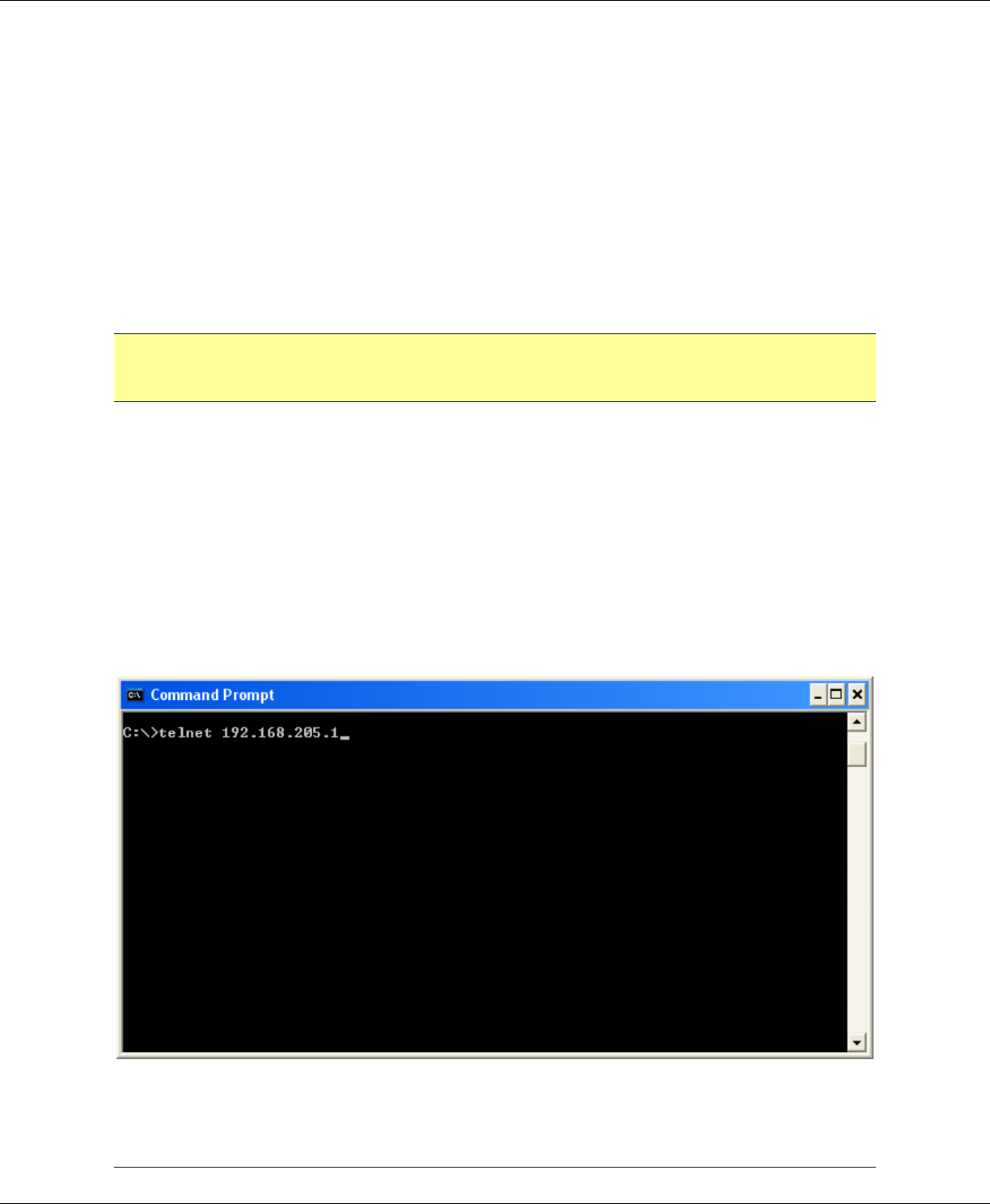
#9 ViPR User Manual_Rev2.doc Page 93
3. Transfer all files in the upgrade package. Occasionally, long pauses, on the order of 30
to 45 seconds, are possible when storing the file in the unit’s flash file system.
Warning: Only transfer Dataradio ViPR files. Do not transfer any zip folders that might
be included in the firmware upgrade package.
Failure to follow the recommended procedure as detailed above may result in unit becoming
unresponsive.
4. If you are upgrading from version 1.2 or older, transfer the license.opt file
corresponding to the ViPR’s MAC Address. The license.opt file will enable the SNMP
feature and is tied to the ViPR’s MAC Address. Contact CalAmp for information about
obtaining the SNMP feature.
5. Once the file transfer is complete, cycle power and allow the unit to boot. The ViPR
should return to its pre-update state.
Note:
After resetting, the Status LED should be steady green. If it is steady red, the FTP transfer
may not have been successful or the firmware is corrupt. See Verify File Integrity below.
UPGRADE RADIO FIRMWARE
If the radio firmware revision has been upgraded in the new package, follow these steps to
complete the upgrade process.
1. First upgrade the ViPR Modem Firmware as outlined in section 13.2
2. Telnet into the ViPR or access the CLI (command line interface) through the serial port.
Example: Telnet using Windows Command Prompt program.
Open Windows Command Prompt. Type the following command then press enter:
telnet vipr_ip_address
Figure 13.1 Use Windows Command Prompt to Telnet to ViPR Radio.
3. Enter in your username and password.
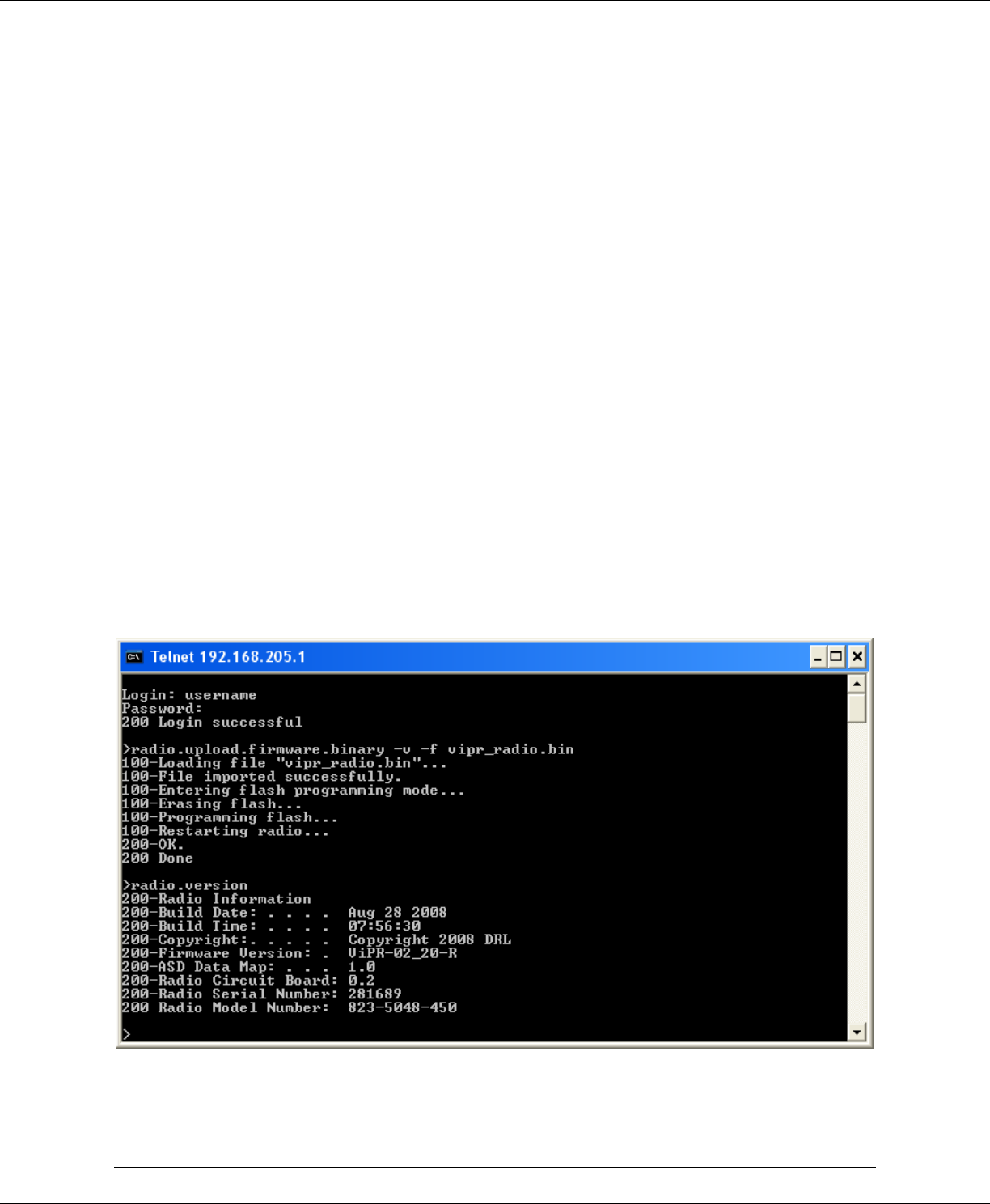
#9 ViPR User Manual_Rev2.doc Page 94
4. Type the following command then press enter:
radio.upload.firmware.binary –v –f vipr_radio.bin
You should see the following message in return:
100-Loading file "vipr_radio.bin"...
100-File imported successfully.
100-Entering flash programming mode...
100-Erasing flash...
100-Programming flash...
100-Restarting radio...
200-OK.
200 Done
Type the following command, then press enter to verify the radio firmware is the most
recent:
radio.version
You should see a message similar to this:
200-Radio Information
200-Build Date: . . . . Aug 28 2008
200-Build Time: . . . . 07:56:30
200-Copyright:. . . . . Copyright 2008 DRL
200-Firmware Version: . ViPR-02_20-R
200-ASD Data Map: . . . 1.0
200-Radio Circuit Board: 0.2
200-Radio Serial Number: 281689
200 Radio Model Number: 823-5048-450
Check that the “Firmware Version:” shows the latest firmware revision.
Figure 13.2 Using Windows Command Prompt to upgrade Radio Firmware.
5. Restart the ViPR.
Tip: You can restart the ViPR by typing “stationreset” in the CLI then pressing enter.

#9 ViPR User Manual_Rev2.doc Page 95
VERIFY FILE INTEGRITY
1. Using your browser, connect to the unit’s IP address.
2. Enter the user name and password. Allow the Welcome page to load.
3. In the left pane, select UNIT STATUS. The Unit Identification and Status pane should
display the newly upgraded firmware in its Banner and the H/W Status should also
show Ok.
4. In the left pane, select MAINTENANCE D PACKAGE CONTROL. Wait a few moments
for the results to display.
If the message in the result screen points out that file(s) failed the integrity check, retry the
FTP transfer for the failed files(s) again. If the problem persists, please have the PACKAGE
CONTROL results ready and contact CalAmp Technical Services at the numbers provided in
the front of this manual.

– APPENDIX A –
V
VI
IP
PR
R
S
SP
PE
EC
CI
IF
FI
IC
CA
AT
TI
IO
ON
NS
S
These specifications are typical and subject to change without notice.
GENERAL UHF VHF 900
Frequency Range (MHz) 406.125-470 MHz,
450-511.975 MHz 136 – 174 MHz 928 – 960 MHz
Frequency Stability 1.0 ppm 1.0 ppm 1.5 ppm
Modes of Operation Simplex, Half-Duplex
Channel Bandwidth 6.25 kHz; 12.5 kHz; 25 kHz
Frequency Increment 1.25 kHz
Power Source 10-30 VDC, Negative GND
RF Impedance 50 Ω
Operating Temperature -30° to + 60° C
Storage Temperature -40° to + 85° C, 95% non-condensing RH
Operating Humidity 5% to 95% non-condensing RH
Rx Current Drain at 25°C DC Input 10V DC Input 20V DC Input 30V
520 mA (max)
450 mA (typ) 270 mA (max)
240 mA (typ) 190 mA (max)
170 mA (typ)
Tx Current Drain at 25°C Power Out
DC Input 10V DC Input 20V DC Input 30V
Max Pwr 5.8 A (max)
3.6 A (typ) 2.5 A (max)
1.8 A (typ) 1.6 A (max)
1.2 A (typ)
30 dBm
(1W) 1.6 A (max)
1.2 A (typ) 0.8 A (max)
0.6 A (typ) 0.6 A (max)
0.4 A (typ)
Cold start 20 seconds
Nominal Dimensions 5.50" W x 2.125” H x 4.25" D (13.97 x 5.40 x 10.8 cm)
Shipping Weight 2.4 lbs. (1.1 Kg)
Mounting Options Mounting plate/pattern & DIN Rail
Fan Output 5VDC, 400mA max.
TRANSMITTER UHF VHF 900
Tx Frequencies 406.125-470 MHz,
450-511.975 MHz 136-174 MHz 928-960 MHz
Carrier Output Power UHF/VHF: 1-10W Adjustable
900: 1-8W Adjustable
Duty Cycle 100% (Power Foldback Allowed for High Temperatures)
Radiated Spurious
Emissions Per FCC/Regulatory
Conducted Spurious
Emissions <-65 dBc
Transmitter Stability into
VSWR: > 10:1 (Power Foldback Allowed)
RX to TX Time < 2ms
Channel Switching Time < 15 ms (Band-End to Band-End)

RECEIVER UHF VHF 900
RX Frequencies 406.125-470 MHz,
450-511.975 MHz 136-174 MHz 928-960 MHz
25 kHz Channel 12.5 KHz Channel 6.25 kHz Channel
Data Sensitivity @ 10-6
Bit Error Rate (BER)
(Maximum)
UHF/VHF
-111 dBm @ 16kb/s
-103 dBm @ 32kb/s
900 MHz
-108 dBm @ 16kb/s
-101 dBm @ 32kb/s
UHF/VHF
-114 dBm @ 8kb/s
-106 dBm @ 16kb/s
900 MHz
-109 dBm @ 8kb/s
-103 dBm @ 16kb/s
UHF/VHF
-112 dBm @ 4kb/s
-103 dBm @ 8kb/s
Data Sensitivity @ 10-6
Bit Error Rate (BER)
(Typical)
UHF/VHF
-114 dBm @ 16kb/s
-106 dBm @ 32kb/s
900 MHz
-111 dBm @ 16kb/s
-104 dBm @ 32kb/s
UHF/VHF
-116 dBm @ 8kb/s
-109 dBm @ 16kb/s
900 MHz
-112 dBm @ 8kb/s
-106 dBm @ 16kb/s
UHF/VHF
-115 dBm @ 4kb/s
-106 dBm @ 8kb/s
Adjacent Channel
Rejection > 75 dB > 60 dB > 45 dB
Spurious Response
Rejection > 75 dB
Intermodulation Rejection > 75 dB
TX to RX Time < 1ms
Channel Switching Time < 15ms (Band-End to Band-End)
Receive Input Power 17 dBm (50mW) max.
MODEM/LOGIC 25 kHz Channel 12.5 KHz Channel 6.25 kHz Channel
Data Rate (Selectable) 16 kbps, 32 kbps 8 kbps, 16 kbps 4 kbps, 8 kbps
Modulation Type 2FSK, 4FSK
Addressing IP
SETUP and COM Port
Interface EIA-232F DCE
Data Rate Setup Port: 300 – 19,200 bps (Default: 19.2 Kbps)
Com Port: 300 – 115,200 bps (Default: 9.6 Kbps)
Display
5 Tri-color status LEDs Power, Status, Activity, Link, Rx/Tx
Connectors
Antenna Connector TNC female (Tx/Rx)
Serial Setup Port DE-9F
Serial Terminal Server DE-9F
Ethernet RJ-45 10 BaseT auto-MDIX
Power - I/O Power Header Power Plug

DRL p/n 415-7108-113
(Weidmüller p/n 1615550000)
4 Pin, 3.5mm, Power Header
DRL p/n 897-5008-010
(Weidmüller p/n 1639260000)
4 Pin, 3.5mm, Power Plug
Cable: 60 inches
Connections: Fan Output,
Ground, Power, Enable

Diagnostics
Message elements Temperature, Voltage, Local RSSI, Remote RSSI, Forward Power,
Reverse Power, Packet Error Rate
FCC / IC / UL Certifications
FCC IC (DOC) UL
136 – 174 MHz NP4-5018-500 773B-5018500 Pending
406.1 - 512 MHz NP4-5048-300 773B-5048300 Pending
928 - 960 MHz NP4-5098-500 773B-5098500 Pending

Effective 01/2007
– APPENDIX B –
P
PR
RO
OD
DU
UC
CT
T
W
WA
AR
RR
RA
AN
NT
TY
Y
CalAmp warrants to the original purchaser for use ("Buyer") that data telemetry products
manufactured by DRL ("Products") are free from defects in material and workmanship and will
conform to DRL's published technical specifications for a period of, except as noted below, two
(2) years from the date of shipment to Buyer. DRL makes no warranty with respect to any
equipment not manufactured by DRL, and any such equipment shall carry the original
equipment manufacturer's warranty only. DRL further makes no warranty as to and specifically
disclaims liability for, availability, range, coverage, grade of service or operation of the repeater
system provided by the carrier or repeater operator. Any return shipping charges for third party
equipment to their respective repair facilities are chargeable and will be passed on to the Buyer.
If any Product fails to meet the warranty set forth above during the applicable warranty period
and is returned to a location designated by DRL. DRL, at its option, shall either repair or replace
such defective Product, directly or through an authorized service agent, within thirty (30) days
of receipt of same. No Products may be returned without prior authorization from DRL. Any
repaired or replaced Products shall be warranted for the remainder of the original warranty
period. Buyer shall pay all shipping charges, handling charges, fees and duties for returning
defective Products to DRL or DRL's authorized service agent. DRL will pay the return shipping
charges if the Product is repaired or replaced under warranty, exclusive of fees and duties.
Repair or replacement of defective Products as set forth in this paragraph fulfills any and all
warranty obligations on the part of DRL.
This warranty is void and DRL shall not be obligated to replace or repair any Products if (i) the
Product has been used in other than its normal and customary manner; (ii) the Product has
been subject to misuse, accident, neglect or damage or has been used other than with DRL
approved accessories and equipment; (iii) unauthorized alteration or repairs have been made or
unapproved parts have been used in or with the Product; or (iv) Buyer failed to notify DRL or
DRL's authorized service agent of the defect during the applicable warranty period. DRL is the
final arbiter of such claims.
THE AFORESAID WARRANTIES ARE IN LIEU OF ALL OTHER WARRANTIES, EXPRESSED AND
IMPLIED, INCLUDING BUT NOT LIMITED TO, ANY IMPLIED WARRANTY OF MERCHANTABILITY
OR FITNESS FOR A PARTICULAR PURPOSE. DRL AND BUYER AGREE THAT BUYER'S EXCLUSIVE
REMEDY FOR ANY BREACH OF ANY OF SAID WARRANTIES IT AS SET FORTH ABOVE. BUYER
AGREES THAT IN NO EVENT SHALL DRL BE LIABLE FOR INCIDENTAL, CONSEQUENTIAL,
SPECIAL, INDIRECT OR EXEMPLARY DAMAGES WHETHER ON THE BASIS OF NEGLIGENCE,
STRICT LIABILITY OR OTHERWISE. The purpose of the exclusive remedies set forth above shall
be to provide Buyer with repair or replacement of non-complying Products in the manner
provided above. These exclusive remedies shall not be deemed to have failed of their essential
purpose so long as DRL is willing and able to repair or replace non-complying Products in the
manner set forth above.
This warranty applies to all Products sold worldwide. Some states do not allow limitations on
implied warranties so the above limitations may not be applicable. You may also have other
rights, which vary from state to state.
EXCEPTIONS
ONE YEAR: Labor to replace defective parts in repeaters or base stations
THIRTY DAY: Tuning and adjustment of telemetry radios
NO WARRANTY: Fuses, lamps and other expendable parts

– APPENDIX C –
D
DE
EF
FI
IN
NI
IT
TI
IO
ON
NS
S
Access Point. Communication hub for users to
connect to a LAN. Access Points are important
for providing heightened wireless security and for
extending the physical range of wireless service
accessibility
Airlink. Physical radio frequency connections
used for communications between units
ARP. Address Resolution Protocol – Maps
Internet address to physical address
Backbone. The part of a network connecting of
the bulk of the systems and networks together -
handling the most data
Bandwidth. The transmission capacity of a
given device or network
Browser. An application program providing the
interface to view and interact with all the
information on the World Wide Web
COM Port. Both RS-232 serial communications
ports of the ViPR wireless radio modem.
Configured as DCE and designed to connect
directly to a DTE
Default Gateway. A device forwarding Internet
traffic from your local area network
DCE (Data Communications Equipment).
This designation is applied to equipment like
modems. DCE is designed to connect to DTE
DHCP (Dynamic Host Configuration
Protocol). A networking protocol that allows
administrators to assign temporary IP addresses
to network computers by "leasing" an IP address
to a user for a limited amount of time, instead of
assigning permanent IP addresses
DNS (Domain Name Server). Translates the
domain name into an IP address
Domain. A specific name for a network of
computers
DTE (Data Terminal Equipment). This
designation is applied to equipment such as
terminals, PCs, RTUs, PLCs, etc. DTE is designed
to connect to DCE
Dynamic IP Address. A temporary IP address
assigned by a DHCP server
Ethernet. IEEE standard network protocol that
specifies how data is placed on and retrieved
from a common transmission medium
Firewall. A set of related programs located at a
network gateway server that protects the
resources of a network from users on other
networks
Firmware. The embedded programming code
running a networking device
Fragmentation. Breaking a packet into smaller
units when transmitting over a network medium
that cannot support the original size of the
packet
FTP (File Transfer Protocol). A protocol used
to transfer files over a TCP/IP network
Gateway. A device interconnecting networks
with different, incompatible communications
protocols
HDX (Half Duplex). Data transmission
occurring in two directions over a single line,
using separate Tx and Rx frequencies, but only
one direction at a time
HTTP (HyperText Transport Protocol).
Communications protocol used to connect to
servers on the World Wide Web
IPCONFIG. A Windows 2000 and XP utility that
displays the IP address for a particular
networking device
MAC (Media Access Control). The unique
address a manufacturer assigns to each
networking device
MTU (Maximum Transmission Unit)
The largest TCP/IP packet hardware can carry
NAT (Network Address Translation). NAT
technology translates IP addresses of a local
area network to a different IP address for the
Internet
Network. A series of computers or devices
connected for the purpose of data sharing,
storage, and/or transmission between users
Network speed. Bit rate on the RF link between
units in a network
Node. A network junction or connection point,
typically a computer or work station
OIP (Optimized IP). Compresses TCP and UDP
headers, and filters unnecessary

acknowledgments. OIP makes the most use of
the available bandwidth
OTA (Over the Air). Standard for the
transmission and reception of application-related
information in a wireless communications system
PHY. A PHY chip (called PHYceiver) provides the
interface to Ethernet transmission medium. Its
purpose is digital access of the modulated link
(usually used together with an MII-chip). The
PHY defines data rates and transmission method
parameters
Ping (Packet Internet Groper). An Internet
utility used to determine whether a particular IP
address is online
PLC (Programmable Logic Controller). An
intelligent device that can make decisions,
gather and report information, and control other
devices
RIPv2. Dynamic IP routing protocol based on
the distance vector algorithm
Router. A networking device connecting multiple
networks
RS-232. Industry–standard interface for data
transfer
RTU (Remote Terminal Unit). A SCADA device
used to gather information or control other
devices
SCADA (Supervisory Control And Data
Acquisition). A general term referring to
systems gathering data and/or performing
control operations
SNTP (Simple Network Time Protocol)
Protocol for synchronizing clocks of computer
systems over packet-switched, variable-latency
data networks. Uses UDP as its transport layer
Static IP Address. A fixed address assigned to
a computer or device connected to a network
Static Routing. Forwarding data in a network
via a fixed path
Subnet Mask. An Ethernet address code
determining network size
Switch. A device connecting computing devices
to host computers, allowing a large number of
devices to share a limited number of ports
TCP (Transmission Control Protocol). A
network protocol for transmitting data that
requires acknowledgement from the recipient of
data sent
TCP/IP (Transmission Control
Protocol/Internet Protocol). A set of
protocols for network communications
Telnet. User command and TCP/IP protocol used
for accessing remote PCs
TFTP (Trivial File Transfer Protocol). UDP/IP
based file transfer protocol
Topology. The physical layout of a network
Transparent. Device capable of transmitting all
data without regard to special characters, etc
Terminal Server. Acts as a converter between
Ethernet/IP and RS-232 protocols
UDP (User Datagram Protocol). Network
protocol for transmitting data that does not
require acknowledgement from the recipient of
the sent data
Upgrade. To replace existing software or
firmware with a newer version
URL (Universal Resource Locator). The
address of a file located on the Internet

About CalAmp
CalAmp is a leading provider of wireless communications products that enable anytime/anywhere access to critical
information, data and entertainment content. With comprehensive capabilities ranging from product design and
development through volume production, CalAmp delivers cost-effective high quality solutions to a broad array of
customers and end markets. CalAmp is the leading supplier of Direct Broadcast Satellite (DBS) outdoor customer
premise equipment to the U.S. satellite television market. The Company also provides wireless data communication
solutions for the telemetry and asset tracking markets, private wireless networks, public safety communications and
critical infrastructure and process control applications. For additional information, please visit the Company’s website at
www.calamp.com.